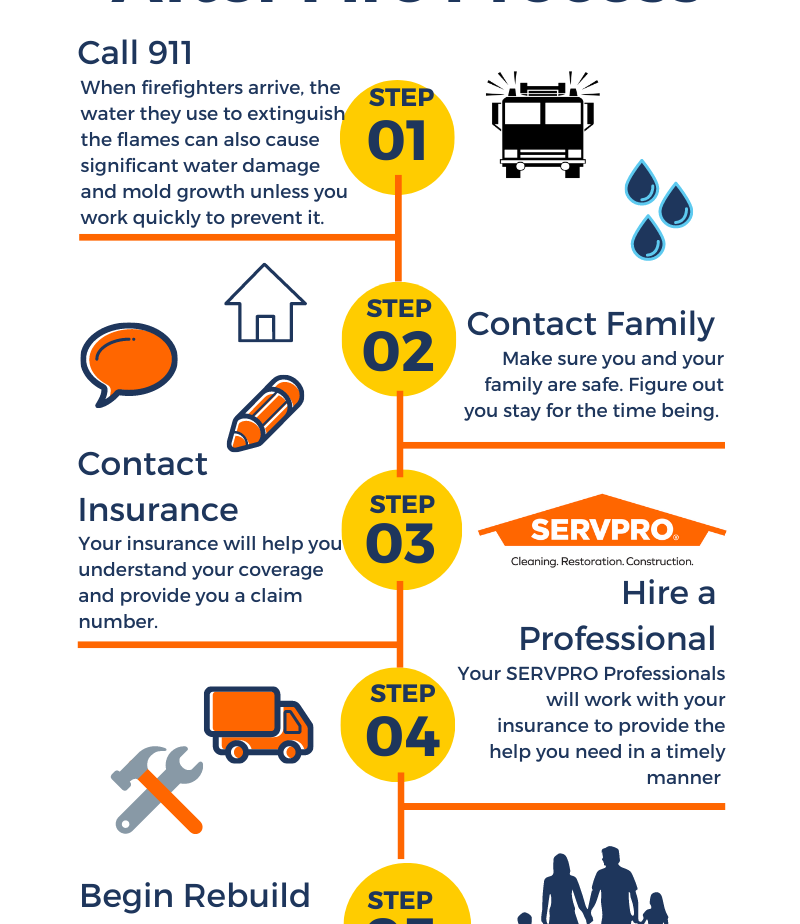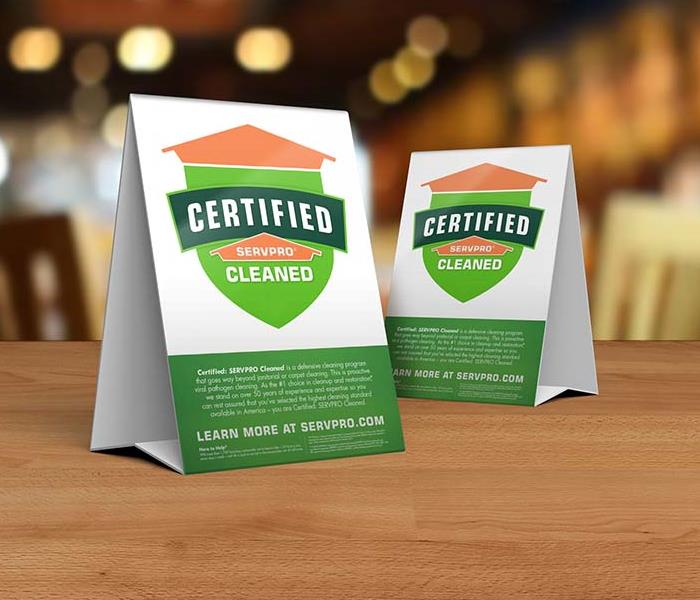Archived Blog Posts
Helpful Tips After Experiencing a Home or Property Fire
8/8/2023 (Permalink)
A home or property fire can be a very scary and traumatic experience. It can leave you feeling nervous, panicked, and overwhelmed and the feeling isn’t over yet. The aftermath of the fire can leave you just as anxious if you don’t know what to do. Fortunately, as fire damage restoration experts we understand what you might be feeling, and we’re here to help. In this blog post, we will provide you with helpful tips to navigate the aftermath of a fire, guiding you towards a swift recovery with the reliable assistance of SERVPRO.
Ensure your safety.
- Take care and depart from your abode without delay.
- Request medical assistance if needed.
To ensure the safe entry of your property, contact the local fire department.
- Assess the damage.
- After the fire has sparked, assess the damage. Obtain photographs or videos for insurance claims purposes.
Secure valuable belongings such as ID papers, jewelry, and crucial documents in a secure place.
- Contact your insurance provider.
- Make sure to inform your insurance provider about the fire immediately. Take note of all discussions and communications with your insurance provider for future reference.
Secure the property.
- Be vigilant and prevent any potential harm to your property. Board up windows, tarp or cover roof damage and secure any openings.
- Emergency services, such as temporary board ups and roof tarping, are available from SERVPRO to avoid further damage.
Request for expert fire damage restoration services.
- Call SERVPRO for a fire damage assessment and plan of action for restoration.
- SERVPRO uses state-of the art equipment and restoration techniques to efficiently clean, deodorize and restore your property.
- Reduce the impact of smoke and dust. Using SERVPRO's advanced equipment, you can remove smoke, soot, and smells from your property and restore it to its pre-fire state. We thoroughly clean affected surfaces, furnishings and HVAC systems ensuring smoke and soot are removed.
Deal with Water Damage:
- During firefighting, water can cause significant harm. Our experts use state-of-the-art equipment, such as dehumidifiers and air movers, to completely dry out the affected areas and prevent mold growth.
Conclusion:
Recovering from a home or property fire requires professional expertise and guidance. SERVPRO is here to help you during this challenging time. Our dedicated team of professionals will work with compassion, efficiency, and expertise to restore your property to its pre-fire condition. Contact SERVPRO today, and let us handle the restoration process, allowing you to focus on rebuilding your life.
September is National Preparedness Month
9/1/2022 (Permalink)
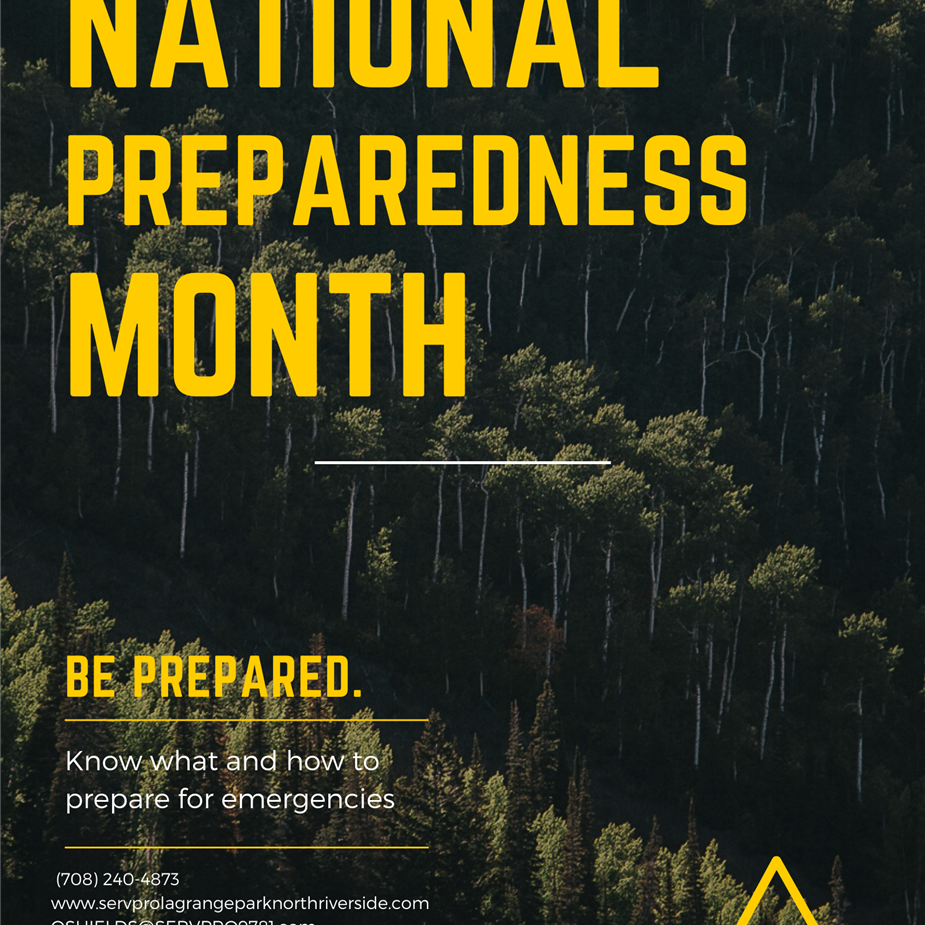
September is National Preparedness Month (NPM). NPM is FEMA's national annual preparedness outreach. It is managed and sponsored by FEMA's Ready Campaign. The Ready Campaign, in conjunction with the Ad Council, aims to educate and empower Americans during NPM and through the year to prepare for and respond to all types of emergencies, including natural disasters and potential terrorist attacks. National Preparedness Month culminates on September 30th with National Preparedness Day, the National Day of Action. The theme for 2022 is: A Lasting Legacy. The life you've built is worth protecting. Prepare for disasters to create a lasting legacy for you and your family. SERVPRO® is proud to spotlight National Preparedness Month this year. By doing so, we want to make sure you are prepared in case of a disaster? whether natural or man-made. If you haven't taken the time to think about how different disasters could affect you, then we challenge you to take the necessary steps to become informed and develop an emergency plan for before, during, and after an event for yourself and your family. IN THIS ISSUE of the Restoration Newsline:
• Why is NPM observed in September?
• What 2 states experience the most tornadoes?
• Preparedness steps that could save your life
• What to include in an emergency supply kit We must work together to ensure that our families, businesses, places of worship, and neighborhoods are ready for the unthinkable.
Begin preparing vital information now so you can address the unique needs of your business during an emergency situation. Contact your local SERVPRO® team of professionals to find out more preparedness planning tips and how you can minimize business interruption with SERVPRO's Emergency READY Profile®.
How SERVPRO work directly with your insurance
8/31/2022 (Permalink)
When a disaster strikes your property, it is important to know who to call! SERVPRO of La Grange Park / North Riverside, Arlington Heights/Prospect Height, and Elmhurst is highly trained and experienced in disaster restoration and cleanup. Our team is the trusted leader in the restoration and cleaning industry, and we offer a wide variety of services for your residential and commercial properties. Water damage, fire damage, and mold damage don't stand a chance against our team! Locally owned and operated, we are dedicated to being "Faster to any size disaster!" Available 24 hours a day, days a week for your emergency.
When you experience an unexpected disaster in your home, you may not know how to handle it. After the shock is over, your first thoughts are “what am I going to do?” and “How am I going to pay for this?”. These are two very common questions homeowners ask themselves given the high cost of repairing water, fire, mold or trauma damage. Good news for you, our team of professionals is here to help eliminate that concern.
Here at SERVPRO of La Grange Park / North Riverside, Arlington Heights/Prospect Height, and Elmhurst set ourselves apart from other restoration companies with our seamless design to work directly with most insurance companies while keeping property owners in the loop. Our dedicated team of professionals understands the insurance industry. From knowing how the claims process works, to getting your claim submitted and your repairs documented correctly. One major advantage we use is our advanced technology that allows us to perform very accurate estimates with detailed reports on replacements. Many of our team members have worked directly with insurance agents and adjusters.
As one of the largest restoration and damage remediation companies in the country, we work with hundreds of insurance companies to help our customers get their claims processed quickly and fairly. Many insurance companies know that SERVPRO handles losses professionally and often recommend us to their policyholders.
If you have any questions or are in need of emergency services, don't hesitate and give our SERVPRO of La Grange Park / North Riverside, Arlington Heights/Prospect Height, and Elmhurst team a call!
What to do after a Home or Commercial Property Fire!
6/24/2022 (Permalink)
Experiencing a Home or Commercial Property fire can be a very traumatic experience and leave you feeling overwhelmed and confused. SERVPRO understands the anxiety that comes when a water or fire damage event hits your home or business. Our professionally trained staff is accustomed to handling these emergencies, and we strive to minimize the disruption for you so you can get back to normal life, soon. We’re a trusted leader in fire and water cleanup, restoration services, pathogen, and biohazard cleaning, and more. Our experience in this service allows us you help understand and answer some of the questions you may have and leave you with some insightful tips. The following is a list of tips we believe will help us through a difficult experience.
Call for Help
This may seem obvious for some but in the case of panic, your mind may be in a state of stress and confusion. Remove yourself from immediate danger and call for help. In the case of an emergency first responders are trained professionals with experience in dangerous situations Getting out of the home or property and seeking help from your first responder may be detrimental to saving others and your own life.
Take a moment to collect your thoughts
A backdraft of emotions often sweeps over the homeowners after a fire ravages a home. Fear, uncertainty, stress and doubt about the future of the property can overwhelm the homeowner long after the flames have extinguished, and the smoke has cleared. Once the first responders have arrived and you are no longer in immediate danger, take a moment. Understand that you may have just undergone a traumatic experience. Take a deep breath and take a moment to gather your thoughts. Taking a moment to collect your thoughts and clear your mind you may be able to better assist and communicate with your first responders. Help the first responders to answer questions they may have such as the number of individuals on or in the property and the cause of the fire. Help the first responders to make sure all individuals are safe. People and animals that are injured may need to be transported to a hospital or veterinarian for immediate help.
Contact your property manager or Insurance Agent
Contact your property manager to let them know what has transpired. Your property manager may have essential resources to help, such as new or temporary housing. Your property manager may also need to collect information from you to file an insurance claim. Contact your insurance company immediately. Insurance companies may take some time to process claims and the quicker that you are, the better. Many insurance companies face casualty losses such as fires and have national accounts with professional restoration companies. Such as SERVPRO, utilize highly trained and skilled technicians alongside advanced technologies to get your home back together “Like it never even happened”
Secure your property ad Call a reputable restoration company
Many restoration companies such as SERVPRO have emergency response teams that are available 24/7. Depending on the damage the company to come to your home and begin as soon as the fire department allows. When it is safe they will secure the property, and start pumping out water and drying material to reduce water damage and mold infestation. Restoration companies such as SERVPRO will help you understand the true damages of your property.
The first 48 hours after fire damage can make the difference between restoring and replacing your property and personal belongings. SERVPRO franchise professionals can help prevent fire damage from creating long-term problems. SERVPRO franchise professionals provide timely response with mitigation services ranging from fire, smoke, and soot removal to contents claims inventory and document restoration. These services help ensure your property, belongings, and memories are restored to preloss condition when possible. Here are a few tips you might be able to do until help arrives
- Limit movement in the home to prevent soot particles from spreading and additional damage from occurring.
- Place clean towels or old linens on rugs and high traffic areas and upholstery.
- Coat chrome faucets, trim, and appliances with petroleum jelly or oil.
- Place aluminum foil or wood blocks between furniture legs and wet carpet.
- Do not wash any walls or painted surfaces.
- Do not shampoo carpet or upholstery.
- Do not clean any electrical equipment.
- Do not send clothing to a dry cleaner since improper cleaning may set up smoke odor.
Building Safety Month
5/3/2022 (Permalink)
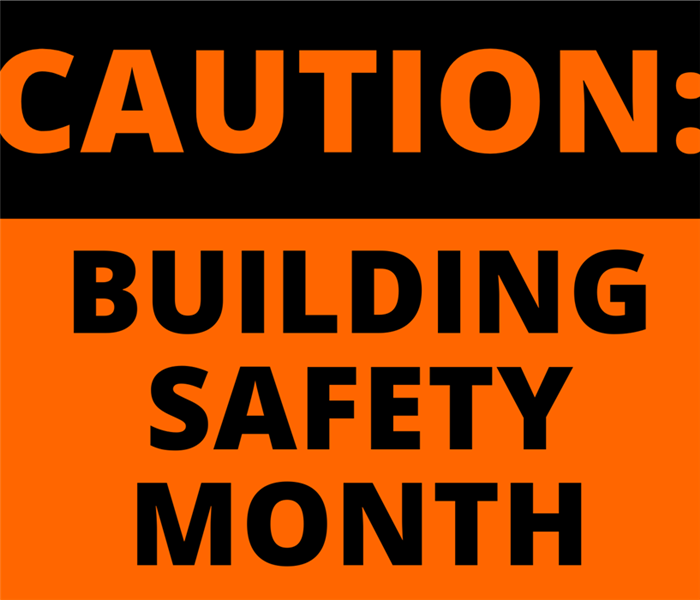
Building Safety Month is an international campaign that takes place annually in the month of May to raise awareness about building safety, according to the International Code Council (ICC) website. This increasingly popular campaign reinforces the need for the adoption of modern, regularly updated building codes, and help individuals, families and businesses understand what it takes to create safe and sustainable structures. This initiative is presented by the International Code Council, a nonprofit association that is focused on building safety worldwide. The Code Council provides a wide range of building safety solutions and develops codes and standards used around the world to construct safe, sustainable, affordable, and resilient structures. All communities need building codes to protect their citizens from disasters like fires, weather-related events such as flooding, and structural collapse. Model building codes, adopted and enforced by well-trained professional code officials, are society's best way of protecting homes, offices, schools, manufacturing facilities, stores, and entertainment venues. The theme for this year's campaign is Safety for All: Building Codes In Action. Regularly updated codes and a strong system of strict code enforcement ensures that individuals and communities are safe in the buildings where they live, work, and play. This campaign is supported by four core themes that will be highlighted throughout the month:
Week 1: Planning for a Safe & Sustainable Tomorrow
Week 2: Exploring Careers in Building Safety
Week 3: Understanding Disaster Mitigation
Week 4: Creating a Safe & Abundant Water Supply To learn more about the weekly themes, check out iccsafe.org.
You can help spread the word about Building Safety Month, the importance of building safety, and the role of code officials with your community! Use the hashtag #BuildingSafety365 to join the global conversation on social media. As always, if your residential or commercial property suffers from structural damage, call your local SERVPRO franchise professionals to help make it "Like it never even happened.®"
SERVPRO’s Higher Standard of Cleaning
4/5/2022 (Permalink)
SERVPRO has been helping our community for over 50 years so it should be of no surprise that when the COVID-19 pandemic began SERVPRO was quick to react to the virus. We enacted safety guidelines to prevent the spread of the virus between customers and businesses. SERVPRO has been committed to providing a safe and clean location for customers and businesses to frequent often. This has been possible through our higher stander of cleaning operations.
Did you know that 89% of consumers said they are hesitant about returning to brick-and-mortar establishments according to a recent survey? And of those, 40% say that cleanliness is a major factor for concern?
A business can look spot on clean but what about the invisible germs and pathogens that our naked eye can’t see? These hesitant consumers are talking about coronavirus, and patrons and employeeswant to feel safe and secure. The COVID-19 pandemic has changed what it means to be clean. Fortunately, SERVPRO has adapted and changed the way we clean. SERVPRO to tell everyone about a new program we are rolling out to take ourCOVID-related cleaningwork to a whole new level, or a “higher standard of clean” says our SVP & Chief Marketing Officer Mike Stahl.
Certified: SERVPRO cleaned program is a cleaning and disinfecting program. This program ensures that businesses and their patrons have been treated by SERVPRO’s best-in-class cleaning and disinfecting services. Businesses and buildings will be provided SERVPRO Certifies Cleaned decals for their windows and doors, signage for tabletops, and digital assets they can share online. This gives consumers and employees peace of mind knowing that a business or building has been treated by the #1 cleaning and restoration brand.
Springtime Storm Flooding
3/29/2022 (Permalink)
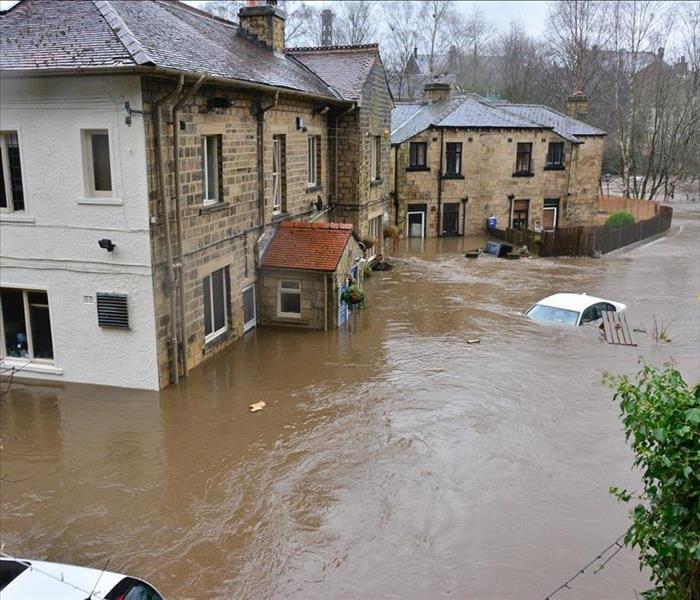 Bingley Floods Boxing Day 2015 River Aire - Ireland Bridge
Bingley Floods Boxing Day 2015 River Aire - Ireland Bridge
Flooding, an overflowing of water that covers or submerges land that is normally dry, is the most common natural disaster in the United States. (Ready.gov/ Samhsa.gov) Although often predicable and planned for alongside “emergency declaration for evacuation, storms and floods can be occasionally unpredictable. Floods happen during heavy rains when the snow melts rapidly when dams or levees break (most notably is the New Orleans levee break killing hundreds and leaving millions homeless). Flooding can even be in relation to other natural disasters such as underwater earthquakes causing tsunamis and hurricanes.
Flash floods are fast-moving waters that are particularly dangerous because of the combination of destructive power and speed. Usually occurred by heavy rainfall exceeding the grounds or drainage system’s ability to absorb the water. Water flows out into streets and sidewalks making driving and walking very dangerous. These flash floods can be significantly damaging to infrastructure. Flooding can cause server damage to residential and commercial properties. Although these events can occur randomly there are ways to prepare and prevent the damaging effects of flooding.
Preventative steps you can take in the case of a flood are unclogging drains and gutters, using sandbags to direct the flow of water, installing a backflow prevention device, and getting a sump pump. A sump pump is a submersible device installed in a sump pit dug at the lowest point of your house such as the basement and used as a sort of drain. installed If your residential or commercial property suffers from flood damage, call your local SERVPRO franchise professionals to help make it “Like it never even happened”
9 Ways to Keep Your Home Safe From Water Damage
3/12/2022 (Permalink)
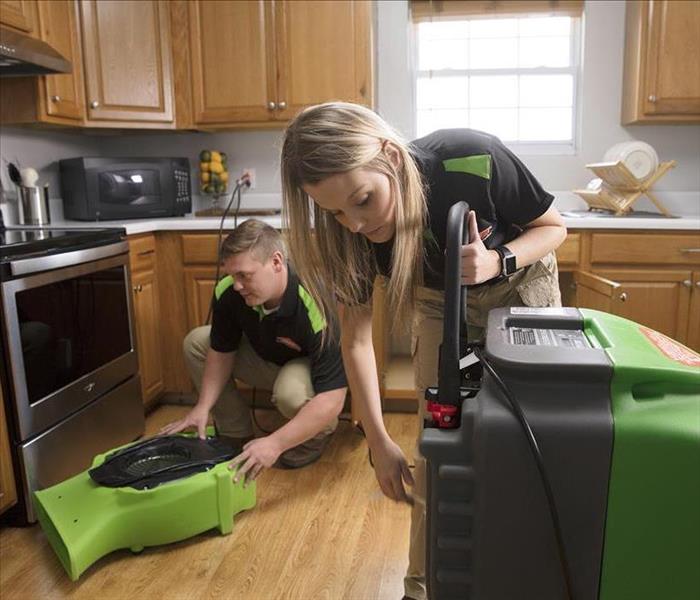 Minor leaks can go undetected for a long time and cause significant damage if left unchecked.
Minor leaks can go undetected for a long time and cause significant damage if left unchecked.
- You should be aware of the location of the stopcock. Ensure that not only you, but also your family members, are aware of its location. A severe leak or rupture can cause significant damage in minutes. It is critical to understand where and how to turn off the water supply.
- Check for leaks ahead of time. Minor leaks can go undetected for a long time and cause significant damage if left unchecked. Consider that a dripping faucet can waste up to 57 gallons (260 litres) of water per week. Look for signs of stray water beneath sinks and around appliances such as dishwashers and washing machines.
- Check that your sump pump is operational. The sump pump, which is common in basement homes, plays an important role in ensuring that your basement does not flood after prolonged periods of rain. If you have one, make sure it's well-maintained and serviced at least once a year.
- Keep debris out of your gutters. While leaves are the most common cause of blocked gutters, this isn't just an autumnal problem. Moss and weeds are frequently discovered to be a major cause. Blocked gutters play a significant role in damp problems. If you see water running down the side of your house or if your gutters appear to be sagging, they're probably blocked and need to be cleaned.
- Inspect your roof from the inside out. Examine the inside of your attic for signs of water leaking through the roof. Examine the joists for damp spots and the plaster for tea-colored stains. Outside, look for visible damage to the roof and make sure the flashing around any chimneys is in good condition.
- Keep your pipes from freezing. Even if you plan to be away, use a smart thermostat to keep your home at a minimum temperature of at least 10 degrees Celsius. Warm water must be able to circulate through pipes to avoid freezing damage. If a property will be unoccupied for an extended period of time, turn off the water supply at the stopcock and consider draining the system so that no water remains in the system.
- Pipes that are exposed should be properly insulated. Snap-on pipe insulation is inexpensive and effective, and it can also be used outside.
- Install a device to detect water leaks. Detection devices, which are relatively inexpensive, cut off the water supply in the event of a leak, which is critical if you leave your property vacant for extended periods of time.
- Look for any signs of moisture or mold. Damp can be detected by flaking paint or wallpaper, as well as black, speckled marks on skirting and sills. Consider adding more insulation if your walls feel cold to the touch or if you notice a musty odor. In the mornings, check windows and skylights for condensation. Its presence can indicate that your home has higher-than-average moisture levels.
10 Safety Tips to Prevent a Dryer Fire
3/11/2022 (Permalink)
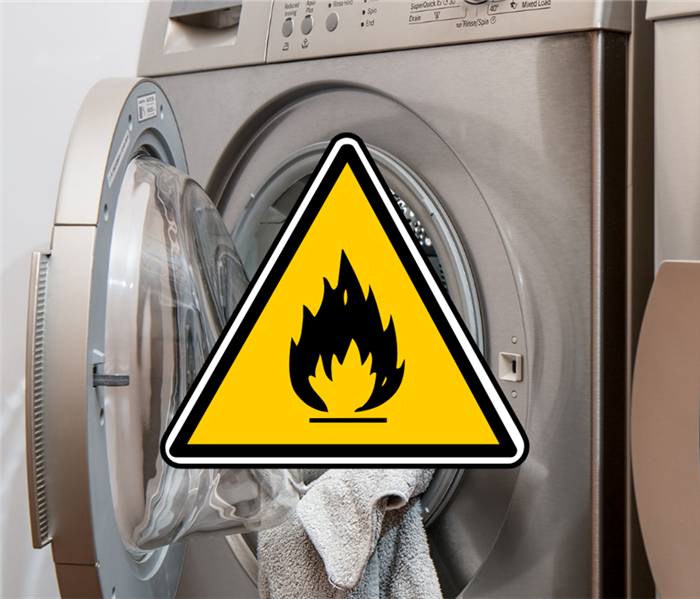 Consider running the dryer only when you are home and awake for your own safety.
Consider running the dryer only when you are home and awake for your own safety.
We usually wash and dry our clothes on a daily or weekly basis. However, it is critical to keep your clothes dryer in good working order in order to keep your home and family safe. Avoiding these specific bad habits can help you avoid a potentially disastrous house fire.
1. Installation by a Professional
Professional technicians can ensure that your dryer is installed correctly and carefully. These professionals should be knowledgeable about a wide range of units, including gas and electric dryers, as well as washer/dryer combos. Most manufacturer recommendations, such as proper vent pipe installation, are familiar to these technicians.
A technician would explain how minimizing bends in the pipe is important because it creates fewer opportunities for lint to accumulate. They can install a dryer vent fan for you if the distance between the vent and your dryer is significant. This is an automatic electric device that increases airflow through the duct whenever the dryer is turned on. Having a professional install and service your dryer unit can help ensure that any potential hazards are handled correctly.
2. Ongoing Maintenance
According to experts, the primary cause of clothes dryer fires is a failure to clean and maintain them. Check behind the dryer, where lint tends to accumulate. You should clean your dryer once a year and inspect the hose and vent for blockages twice a year.
It is a good idea to have a qualified service person clean the interior of the dryer chassis once a year. This will reduce the amount of lint that accumulates while also providing you with a professional opinion on the safety of your unit. In addition, a professional can inspect the venting and exhaust system. Employ only certified dryer exhaust technicians to ensure that this procedure is carried out correctly.
3. Keep Flammables to a Minimum in the Surrounding Area
Dryer lint is not the only flammable that should be considered and kept away from the dryer unit's heat. Anything flammable should be swept up and disposed of before it accumulates and creates a fire hazard. Cleaning up dust and lint is time-consuming, but it is far less difficult than dealing with the aftermath of a fire.
On the same note, do not store cleaning products, boxes, or clothing baskets near the dryer because they may start a fire that spreads quickly. While this is an extreme case, keeping the area clutter-free is an important step toward fire prevention.
4. Remove and clean the lint filter before and after each load of laundry.
Household dust and lint are the most common sources of ignition in dryer fires. They congregate within the dryer cavity, which is located near the heating elements. Temperatures can reach 550° here, which is hot enough to start a fire. It is never a good idea to forget to clean out your lint filter.
Cleaning the lint screen before and after each drying cycle is a good habit to get into during your laundry routine. This is an obvious first line of defense in the prevention of dryer fires. Wiping down the interior of the dryer will also remove excess lint buildup that the screen does not catch. This is a less obvious step that many people overlook, but it is nonetheless critical.
It is also critical that you never use a dryer without a lint filter, as this removes the dryer's built-in defense against hazardous lint buildup. This may seem obvious, but you'd be surprised how frequently it occurs.
5. Only use metal venting material that is rigid or flexible
Most clothes dryer manufacturers recommend using flexible or rigid metal venting material to maintain proper drying time and airflow. Lint can accumulate in accordion-style ductwork, causing clogs and increasing blockages. Any dryer venting made of plastic or coiled wire foil should be replaced immediately with rigid non-ribbed metal ducts. Purchasing from a reputable vendor is critical to ensuring that your unit meets the necessary safety standards.
It is always a good idea to do your research on any major appliance before purchasing it. Looking at the unit's website to ensure it is from a reliable source, as well as researching customer reviews, can help you make an informed decision.
6. Ensure that the air exhaust vent pipe is not obstructed
One of the leading causes of dryer fires is clogged dryer vents. When the vents are clogged, it is difficult to tell. Some people are completely unaware that the vents must be cleaned on a regular basis. However, it is critical to understand that lint accumulates on a large scale within the hoses and, when combined, can cause a serious problem. The accumulation restricts airflow, which can lead to overheating and fire.
In between professional inspections, clean the outside exhaust vent regularly. It is best to check this when your dryer is running by making sure that the exhaust air is escaping properly. If you cannot feel any air, it is likely that there is a lint accumulation clogging the vent outlet. This might require you to disconnect the exhaust vent from the dryer to remove the clog. Remember to reconnect the ducting to the outside vent and dryer before you use the dryer again. If you are unsure of how to do this, it is always recommended that you contact the manufacturer for help or hire a professional.
7. Avoid Overloading
Laundry is easy to put off, especially if you have a busy schedule. However, this can lead to you saving all of your dirty laundry to be cleaned on the same day, and it's easy to use this as an excuse to overload your dryer, which can be dangerous.
A heavy load is too much for the dryer and is the most common reason for it to break down. Aside from downtime and repair costs, an overloaded dryer can cause the drum belt, spindle bearings, and pulleys to work overtime, resulting in higher-than-normal temperatures. When this occurs, the friction can ignite a spark, resulting in a fire.
This may be the most straightforward cause of dryer fires and malfunctions to avoid. Maintain organization by limiting your laundry loads to a few times per week. If your schedule makes this difficult or unreasonable, it may be better to simply split your laundry load into two or three loads instead, and take a slightly longer (albeit safer) time to complete this necessary chore.
8. Examine Gas Lines
Qualified professionals should inspect the gas line and connection to ensure that they are leak-free and in good working order. Aside from a dryer fire, gas leaks are extremely dangerous and can cause a variety of problems. If you notice a burning odor when using your dryer, stop using it immediately and contact the manufacturer as soon as possible. At all times, stay away from the suspected gas leak area.
9. Use the Proper Plug and Outlet
Dryer grounding is critical to their proper operation. Check that you are using the correct electrical plug and outlet as specified by the manufacturer. A licensed professional installing your dryer unit is a good way to ensure that you are doing this.
Check all connections on a regular basis and keep an eye out for any changes. If anything appears to be wrong, loose, or discolored, stop using it right away. Overloaded electrical sockets frequently cause tripped circuit breakers or blown fuses, which can result in a house fire.
10. Never use the dryer when you are leaving the house or sleeping.
We've all succumbed to convenience and thrown a load of laundry in the dryer before heading to work or running errands. However, if a fire starts while you are away, you will be unable to put it out. Furthermore, if you are sleeping, it may be too late for you to realize that your house has caught fire.
Consider running the dryer only when you are home and awake for your own safety. It's also a good idea to keep a fire extinguisher in your laundry room in case anything goes wrong.
How to Protect Your Property from Floods Caused by Snowmelt, Ice Jams, and Winter Storms
1/31/2022 (Permalink)
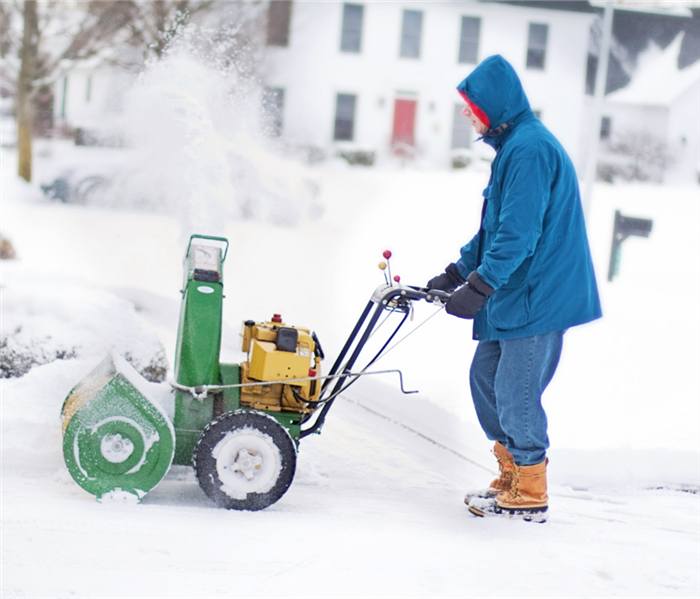 The risk of flooding doesn't go away after winter.
The risk of flooding doesn't go away after winter.
When we hear about flooding in the news, we usually hear about spring floods and summer storms, giving the impression that flooding occurs just half of the year. We're not out of the woods yet.
The risk of flooding doesn't go away in the winter, and flooding isn't the only thing to be concerned about when the weather turns cold. Snowmelt, ice jams, and winter storms threaten major floods from the Pacific Northwest to the Great Lakes to the Northeast throughout the winter months.
Winter Flood Risk #1: Snowmelt
Snowmelt is an element of the natural water cycle. However, if snow thaws too quickly to be absorbed back into the soil, neighboring water bodies, and drainage systems, it can flood adjoining land, potentially flooding your basement.
Snowmelt floods can occur anywhere in the snowy north of the US, and they usually occur in small, isolated episodes. But that doesn't rule out the possibility of serious consequences. Let's pretend it snows ten inches, which isn't unheard of in freezing areas. One inch of water equals ten inches of snow, and an inch of floodwater can cost you up to $25k in repairs, according to FEMA.
While snowmelt risk is higher in the spring, climate change has introduced more and more unseasonably warm temperatures every winter. Take the 2019 Midwestern floods, for example. Record amounts of snowfall from January through March were followed by a three-day stretch of 60-degree weather. Rain fell and caused historic levels of flooding along the Missouri River and its tributaries.
Winter Flood Risk #2: Ice Jams
Long cold episodes that cause the surface of rivers to freeze are followed by warm spells, resulting in ice jam floods. Large pieces of ice break off unevenly as temperatures rise, blocking streams and flooding adjacent settlements.
Winter Flood Risk #3: Winter Storms
People who live in lakeside places like the Windy City are probably familiar with flooding in the winter. Strong winds from winter storms can create massive waves that crash over shorelines and barriers into city streets, as they did in Chicago last winter.
These winter storms and subsequent floods are common in the Midwest along the Great Lakes, but they also happen along the East Coast. Nor’easters can trigger storm surges that push heavy ocean tides into coastal communities, on top of heavy rain or snow.
Regular downpours and flash floods can happen throughout the winter, too, as long as temperatures are high enough.
Steps You Can Take This Winter to Prevent Flooding on Your Property
The easiest method to protect your property from a flood is to put measures in place before one occurs. The two most important actions to take care of to ensure that you have both financial and structural flood mitigation on your property.
Step 1: Secure Flood Insurance
Purchase flood insurance as soon as possible once the fear of floods has passed. That way, if you experience flood damage this winter, you'll be able to file a claim swiftly and easily.
The good news is that a flood insurance policy covers all sorts of flood damage equally, so your policy will provide coverage all year. The cost of coverage is decided by factors such as the age of your structure, the type of foundation it has, and your flood zone and risk level.
Step 2: Shovel Proactively and Test Drainage Systems
Shovel snow away from your foundation by at least five feet.
Shovel snow away from a runoff path if your property is on a slope or hill.
Remove any snow that has accumulated on your roof.
Keep snow and ice from accumulating around your property's drainage systems, such as gutters and groundwater pumps.
A bucket of water can be used to test sump pumps.
Floods caused by snowmelt, ice jams, or winter storms can be helped with the same wet and dry floodproofing measures you take to safeguard your property against spring and summer floods, such as constructing drainage systems.
Will Insurance Pay For Mold Remediation
1/29/2022 (Permalink)
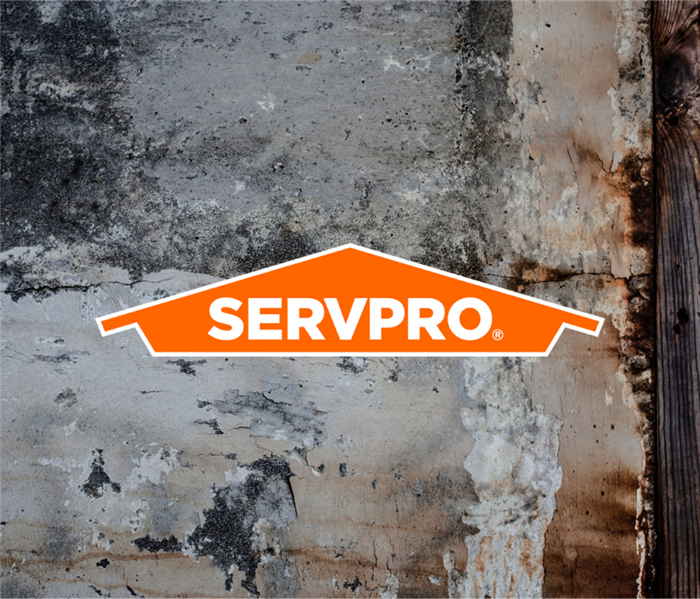 If you notice mold growth, it's best to eliminate it quickly. SERVPRO has the equipment and knowledge to assist in the cleanup process.
If you notice mold growth, it's best to eliminate it quickly. SERVPRO has the equipment and knowledge to assist in the cleanup process.
If you notice mold growth, it's best to eliminate it quickly. SERVPRO has the equipment and knowledge to assist in the cleanup process. Restoration costs can add up quickly, though, and you're probably wondering whether your homeowner's insurance can help pay the bill. Sometimes it does, and sometimes it won't. You'll want to review your policy and speak with your insurance adjuster. Here are three things to know before having that conversation.
1. Was It Accidental?
Is mold coverage not in your policy? Owners usually have to add it separately. That doesn't mean that you can't get aid. Did your roof cave in from snow or ice? Did a pipe suddenly freeze and burst? Insurance companies may payout if the spores spread as a result of something out of the homeowner's control. If the initiating incident is included then the subsequent events get bundled with it.
2. Was the Issue Remedied Quickly?
Before a check is cut, the company could ask for evidence proving your home was under proper care. Take the broken pipe for example. Can you prove that you called for help as soon as possible? Did you let it sit and fester for a while? If the latter is the case, you may have encouraged the fungus growth, giving grounds for denial. It's best to care for water damage as quickly as possible. Prove your efforts by saving receipts. Show efforts to have repairs made and dry up the premises.
3. Is a Different Policy Available?
Speak openly about concerns. As you meet about policy updates including mold insurance limits. For instance, some companies only pay up to a certain amount, capping the remediation and leaving the rest of the cost to the residents. Consider supplementing coverage. While you may have to pay a bit more each year, that annual amount could offset large numbers.
Eliminate mold growth as soon as possible. When you notice an issue, call SERVPRO and we will contact your insurance company if needed.
We Are Here to Help!!
1/22/2022 (Permalink)
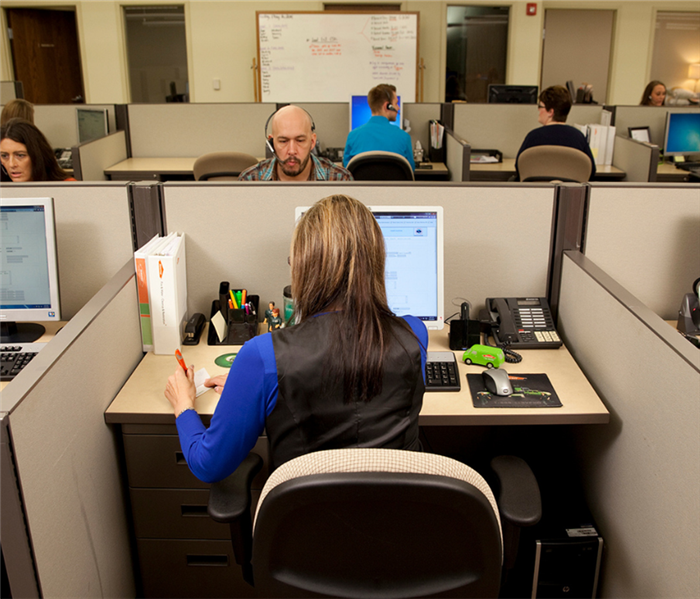 We answer the phone ready to help!
We answer the phone ready to help!
SERVPRO of Elmhurst is available 24 hours a day for water emergencies, large or small. When you are dealing with water damage, immediate action is crucial. A delay of just a few hours can greatly increase the severity of the water damage.
We Answer the Phone Ready to Help
We understand that when you call us, you may be feeling confused, stressed, and vulnerable. You need an expert to guide you through this crisis. SERVPRO of Elmhurst has the specific water damage training and experience to help you through this tough time. We specialize in water damage restoration—in fact, it's the cornerstone of our business.
What to Expect
When you call, we will ask several questions regarding your water damage emergency. These questions will help us determine what equipment and resources to bring, including how many trained SERVPRO Professionals may be needed.
Our SERVPRO Representative will ask several questions:
- Your name and contact information
- Your insurance information (if applicable)
- The street address of the water-damaged home or business
- When did the flooding or water damage occur?
- What caused the water damage (if known)?
- Is there electricity available (on-site)?
Call us today: (630) 758-1701
COVID-19 CLEANING & DISINFECTING SERVICES
1/10/2022 (Permalink)
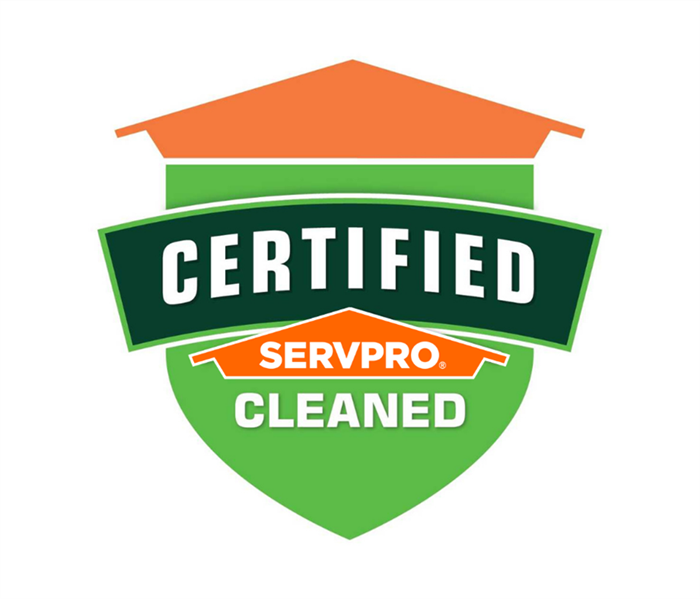 We provide preventative cleaning services as well as cleaning after a probable or proven exposure to assist reduce transmission.
We provide preventative cleaning services as well as cleaning after a probable or proven exposure to assist reduce transmission.
Protect Your Employees & Guests From COVID-19
About Our Services
SERVPRO® of Elmhurst technicians are specially trained to clean and disinfect your home or business according to CDC guidelines. We have years of experience dealing with biological hazards, and we will go above and beyond what janitorial personnel does on a daily basis. Our technicians are qualified to undertake a proactive cleanup that includes cleaning and disinfection of the business or structure. Washing porous and non-porous surfaces, disinfecting non-porous surfaces, cleaning, and disinfecting equipment, tools, and/or supplies used in the cleanup process, and waste disposal are all common cleanup methods.
Residential homes, small and large enterprises, schools and universities, commercial buildings, factories and plants, government facilities, and more can all benefit from SERVPRO's skilled cleaning services. COVID-19 was specifically addressed by our Certified: SERVPRO Cleaned defensive cleaning program. We provide preventative cleaning services as well as cleaning after a probable or proven exposure to assist reduce transmission.
What Chemical Do We Use to Clean?
While we use a range of disinfectants to destroy hazardous bacteria and viruses, SERVPROxide is the disinfectant of choice in COVID-19 cases. SERVPROxide is a hospital-grade disinfectant that has been shown to be effective on hard, non-porous surfaces against viruses like SARS-CoV-2. The CDC has cleared it for COVID-19 cleaning.
Call us today at (630) 758-1701 if your home or business has been exposed to COVID-19
The Deadly Chicago Winter Blizzard of 1967
1/7/2022 (Permalink)
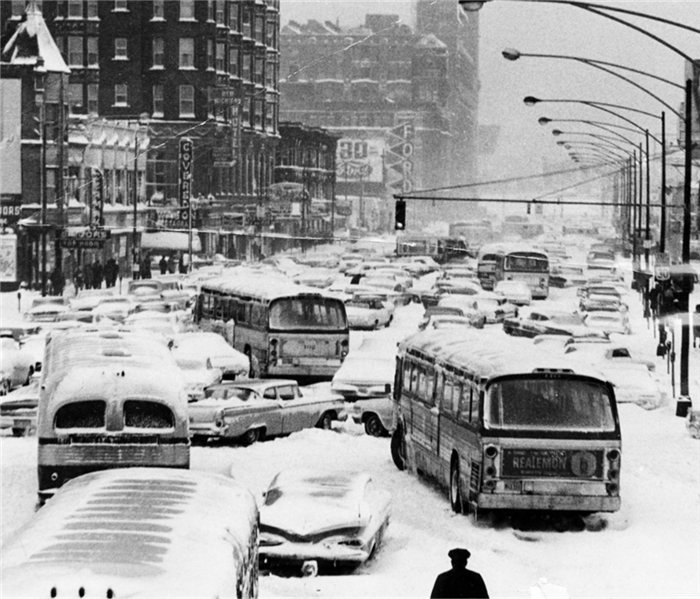 26 people had died and businesses lost an estimated $150 million, about $904 million in today’s currency!!
26 people had died and businesses lost an estimated $150 million, about $904 million in today’s currency!!
Chicago experienced its greatest snowstorm on record on January 26 and 27, 1967. The snow began around 5:02 a.m. on the 26th, and by 10:10 a.m. on the 27th, the city had been crippled by a record 23 inches of snow.
Winds gusted to 53 mph at Midway Airport during the storm. The strong winds generated a lot of blowing and drifting. Drifts of 4 to 6 feet high were found all over the area.
Snow began falling on Thursday morning, January 26th, but many people were able to go to work and school without difficulty. However, by noon, about 8 inches of snow had fallen, and O'Hare Airport had been closed.
Employees and kids have been released early from certain companies and schools. But even for those who got out early, the trip home was a misery. Many workers failed to return home or arrived late. Many people choose to stay at work or in motels. The city had come to a halt by Friday morning.
By the time it stopped snowing, 26 people had died and businesses had lost an estimated $150 million (about $904 million in today’s currency).
When a winter storm warning is issued, there is little or no time to prepare, making it more difficult to ensure safety. Check out the suggestions below for what to do depending on where you are during the alert.
At Home or in a Building:
- Stay inside
- Close off unneeded rooms to save heat
- Stuff towels or rags in cracks underneath doors to conserve heat
- Cover the windows at night
- Eat and drink to prevent dehydration
- Wear layers of loose-fitting, light-weight and warm clothing
If Caught Outside:
- Find a dry shelter immediately
- Cover all exposed body parts
If Caught Outdoors Without Shelter:
- Prepare a lean-to, windbreak, or snow-cave for protection against the wind
- Build a fire for heat and attention purposes
- Place rocks around the fire to absorb and reflect the heat
- Do not eat snow straight off the ground, melt it first.
If Stranded in a Vehicle:
- Stay inside your vehicle
- Run the motor for ten minutes each hour
- Crack the windows to avoid carbon monoxide poisoning
- Make sure the exhaust pipe is not blocked
- Tie a colored cloth to your antenna or door
- Raise the hood after the snow stops falling
- Exercise to keep warm and keep your blood flowing
The Fire Hazards of Winter!
1/5/2022 (Permalink)
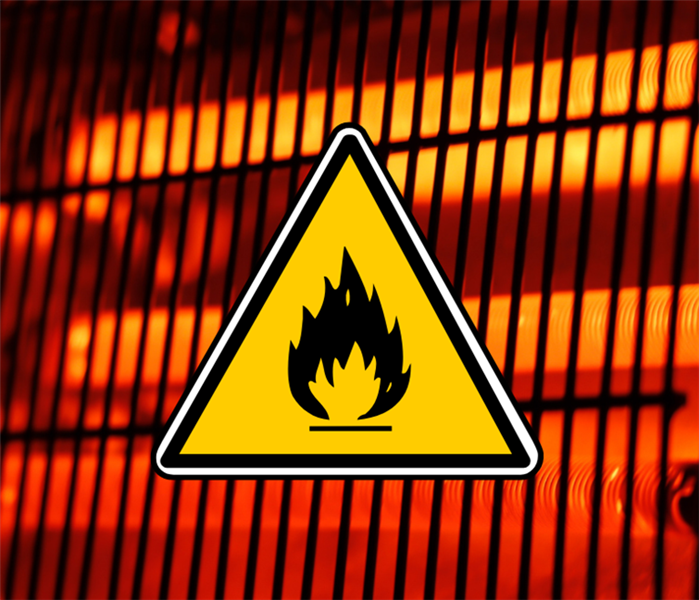 Anything that can burn should be kept at least three feet away from heating equipment!!
Anything that can burn should be kept at least three feet away from heating equipment!!
Keeping ourselves and our houses warm during winter can rapidly turn into a fire hazard, whether it's with a space heater, candles, or an electric blanket. There are various things you can do to make your home more fire-safe, as well as activities you can personally adopt to assist you to stay safe this winter.
Candles
- Candles should be kept at least 3 feet away from anything that can catch fire.
- Place candles in robust holders and in places where they won't be easily knocked over.
- Make sure that candles are out of reach of youngsters and dogs.
- If you leave the room, fall asleep, or go to bed, extinguish all candles.
Electrical equipment/appliances
- Only use one wall outlet at a time to plug in a heat-producing gadget (coffee maker, space heater, microwave, etc.).
- When using a heat-producing appliance, never utilize an extension cord.
- Extension cords should only be used for a short period of time.
- Furniture, beds, curtains, clothing, and flammable or combustible gases and liquids should all be kept away from lamps, light fixtures, and light bulbs.
Heaters
- Make room for space heaters! Anything that can burn should be kept at least three feet away from heating equipment (furnace, fireplace, wood stove, portable heater, etc.).
- When you leave the room or go to bed, turn off the space heater.
- A competent specialist should clean and inspect your heating equipment and chimneys once a year.
- Never heat your home using an oven.
Always make sure you have a working smoke and carbon monoxide alarm at all times in case of a fire.
Be Prepared for the Next Winter Storm With These Tips!
1/5/2022 (Permalink)
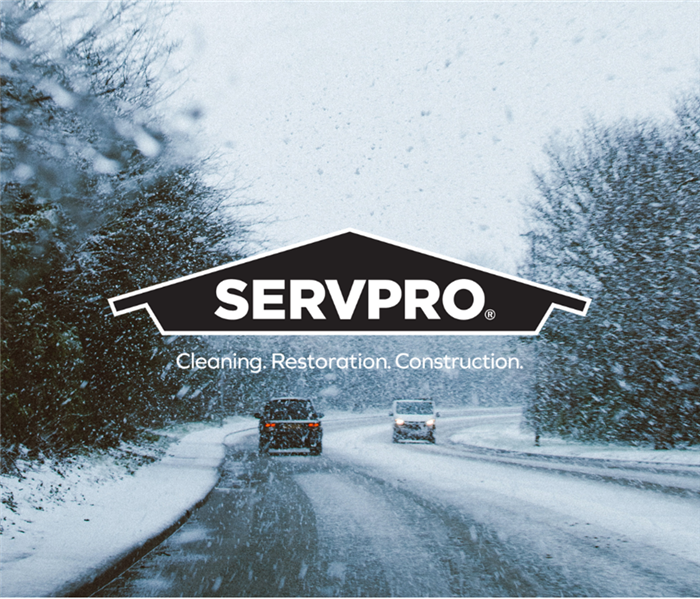 Before the next winter storm arrives, get your car's antifreeze levels, battery, ignition system, exhaust system, heater, lights, and oil checked.
Before the next winter storm arrives, get your car's antifreeze levels, battery, ignition system, exhaust system, heater, lights, and oil checked.
Winter storms can bring not only a lot of snow, but also bitterly cold temperatures, strong gusts, freezing rain, and ice. They can bring down trees, make roads and pathways extremely unsafe, and produce power outages that linger for days. Schools and daycare facilities may be closed as a result of the disruption to public transit. Winter storms also increase the likelihood of car accidents, hypothermia, frostbite, carbon monoxide poisoning, and heart attacks.
That's why, with winter storm season in full swing, knowing how to protect yourself, your family, and your house safe is essential.
Here are some things you can do now to prepare for the impending storm.
1. Make sure you have enough food in your pantry.
Because it's critical to stay indoors and avoid traveling during a winter storm, making sure you're well-stocked on food is critical. Many non-perishable things should be in your pantry so that you don't have to worry about anything deteriorating if you lose electricity. Ideally, you should have enough food to last at least three days.
2. Buy Bottled Water
Make sure you have plenty of bottled water on hand in case your pipes freeze and you can't get water from the tap. You may also require water for brushing your teeth, cleaning dishes, flushing toilets, or bathing if your pipes freeze. You can also prepare ahead of time by filling the bathtub, jugs, bottles, and other containers with water.
3. Get your prescriptions filled and hygiene items picked up
Make sure all of your prescription drug prescriptions are filled so that you have enough on hand to last at least three days, if not a week. This eliminates the need to rush to the pharmacy when the roads are poor.
You should also stock up on any hygiene products you may require, like as diapers, toilet paper, tampons, and toothpaste. Picking up moist toilet paper can also be beneficial if water is scarce.
4. Check your tools and stock up on ice melt.
Ice melt salt sells out quickly in local stores just before a storm, so start buying up early to ensure you have enough for after the storm. You'll need enough to shovel and salt all of your outside stairs, stoops, and walkways immediately following the storm, before the snow melts and turns to ice as the temperature drops.
Before the storm hits, make sure you have a good snow shovel (or two). Make sure they aren't too worn or cracked, as this will only complicate your life. You'll also want to make sure your tool kit is up to date and simple to locate, since you may need a wrench or pliers to quickly turn off utilities.
5. Be Prepared For A Power Outage
Charge your cell phones in advance of the storm, and have some portable battery backups available in case the power goes out. It's also a good idea to keep flashlights or battery-powered lights around the house so you don't have to waste time looking for them.
If you live in a region where power outages are common, you should consider purchasing a generator, either a portable or a standby one for your home. If you have a portable generator, make sure you have enough gasoline or propane before the storm to operate it whenever and for as long as you need it. Always use portable models outside, away from windows, and never use them indoors or in confined locations like garages, crawl spaces, or basements.
6. Take Care of Your Water Pipes
Allow cold water to flow from faucets supplied by exposed pipes to help prevent frozen pipes. Running water, even at a trickle, is less likely to freeze. Allow warm air to circulate near plumbing by opening cabinet doors in the kitchen and bathroom. Pipe insulation should be added to any pipes that are prone to freezing. Maintain a temperature of no less than 55 degrees Fahrenheit inside your home.
7. Make sure your windows and doors are well-sealed.
Drafty windows and doors let chilly air in while letting warm air out. That's why it's a good idea to use an insulation kit from any hardware shop to seal any windows. Weatherstripping can also be purchased at the store to improve the seal on your front door.
Insulated blinds are also available to help keep the warm air inside the house.
8. Inspect and replace smoke and carbon monoxide detectors if necessary.
Make that your smoke and carbon monoxide alarms are still operational. It's advisable to replace them with detectors that work during a power outage if they aren't already battery-powered or battery-backed to keep your family safe.
9. Get Your Backyard Ready
Take a trip around your yard before the storm to check for any tree limbs that could fall on your house. If you have the ability, you should prune those back to prevent them from causing damage to your property during the storm – or hire someone to do it for you.
If any tree branches are near power lines, you should get them trimmed or chopped back by a professional or the utility to assist reduce the danger of a power outage.
Mulch your gardens, if you haven't already, to protect plants that you don't want to freeze.
10. Get Your Car Ready
Before the next winter storm arrives, get your car's antifreeze levels, battery, ignition system, exhaust system, heater, lights, and oil checked.
Then, in case you're trapped in your automobile due to the blizzard, prepare your car with items you might require. Blankets, water, chains, jumper cables, ice scrapers, maps, bottle water, warm clothing, non-perishable snacks, and a first-aid kit should all be in your car. It's also a good idea to have some sand or kitty litter on hand in case you get stranded in the snow or ice.
11. Keep yourself up to date
Listen to your NOAA weather radio for hazardous weather alerts and warnings. Always keep an eye on the weather forecast, whether it's on the internet or on your phone. Sign up for emergency alerts and updates in your area.
In the event of an emergency, know how to cut off your utilities, such as gas lines.
Before the storm strikes, do some research on nearby shelters and warming centers, and establish a plan for where to go and how to get there if you need to leave your house in an emergency.
Also, be aware of the symptoms of hypothermia and frostbite, and be prepared to check on your neighbors, particularly if they are elderly or have young children who are more vulnerable to the cold.
How the Pros Will Clean up Water After a Fire in Your Office Building
12/31/2021 (Permalink)
If you can’t summon help quickly, a fire can quickly sweep through your Elmhurst, IL, office and leave a trail of devastation in its wake. Fire damage can be severe and make it impossible for you to resume work duties in your building. Ironically, the very water firefighters use to eliminate the fire can also cause major problems. Trained professionals have the equipment and skill to clean up both types of damage.
Thorough Inspection
When you call a professional disaster cleanup crew to your office, the team won’t jump right in and start working without a plan. The company will evaluate the effects of the fire damage in order to come up with an effective strategy. The technicians will do the following:
• Make note of which areas of your building were affected.
• Determine the extent of the damage.
• Decide what areas and items you can salvage and which ones you must replace.
• Establish a plan of attack that will yield the most complete, time-effective results.
Remove Standing Water
A fire hose can pump out hundreds of gallons of water while a firefighter is battling a blaze. It’s no wonder water can wreak havoc in your office after a fire. A technician will use wet vacuums and other specialized water removal equipment to make sure there is no leftover water on your floor or on furniture or other objects. Next, the team will dry the areas with dehumidifiers and high-powered blowers.
Clean and Sanitize
Sucking up water and drying the area isn’t enough to mitigate water damage. The professionals will also use chemicals to thoroughly sanitize any areas where there had been water. This will minimize the chances of mold growth.
Fire damage and water issues go hand in hand after a fire. By understanding the process the pros use, you can have peace of mind and confidence that your office will be in good hands.
We Specialize in Flooded Basement Clean Up and Restoration
12/31/2021 (Permalink)
A basement can flood at any time, although flooding most often occurs during heavy rainfall. Basements are inherently prone to flooding because they are the lowest level of a building and are normally built partly or entirely below ground level. There are a number of reasons why your basement could flood, including:
- A blocked or failed sewer lateral pipe
- Heavy rain causes surface water to pool around your home
- Storm sewer backup
- Sanitary sewer backup
- Foundation drainage failure
- Water supply-line break or hot-water tank failure
- And many more
Have Questions about Basement Flooding?
Call Today – SERVPRO of Elmhurst
If flood water is not handled quickly and properly, it can jeopardize your health and safety, and cause severe damage to your home’s structure. Remember, the longer you wait, the worse the problem will get.
The bottom line: a flooded basement can jeopardize your health, safety, and your home’s integrity. It’s worth making a call to SERVPRO of Elmhurst and letting our trained, professional crews handle the situation safely and correctly. We have earned the trust of hundreds of homeowners, business owners, and property professionals.
We are Flooded Basement Specialists:
- We are Available 24 hours/7 days per week
- We’re a Preferred Vendor to many National Insurance Companies
- We Bill The Insurance Directly – One Less Thing For You To Worry About
- Our Technicians are Highly-Trained in Water Restoration Techniques
- We use s500 IICRC Restoration Standards
- Advanced Inspection and Extraction Equipment
Basement Flooded? Call Us Today 630-758-1701 – SERVPRO of Elmhurst is Ready To Help!
7 Ways to Prevent Frozen Pipes
12/1/2021 (Permalink)
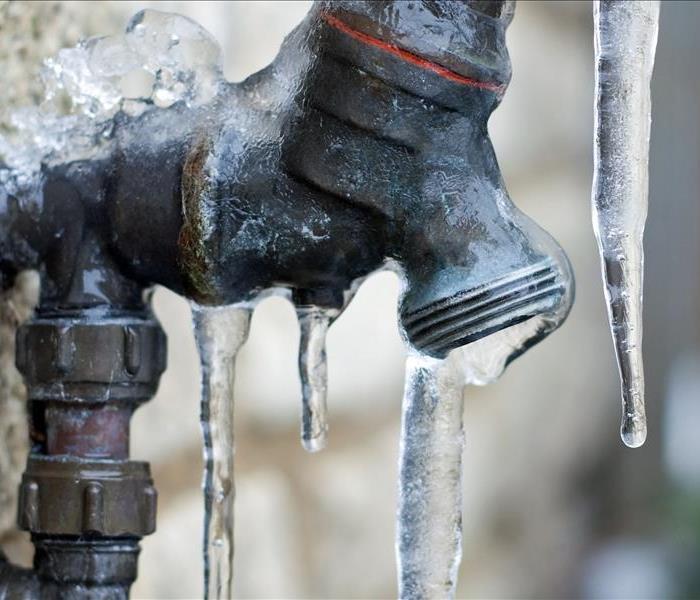 Tips to help prevent pipes from freezing
Tips to help prevent pipes from freezing
Frozen pipes are caused by three factors: rapid temperature dips, insufficient insulation, and thermostats set too low.
- Insulate. Even if you live in a climate where freezing is unusual, pipe insulation in your home's crawl areas and attic can help. The pipes that are exposed are the most vulnerable to freezing. Remember that the more insulation you use, the better your pipes will be protected.
- Use heat tape or wire. Wrapping pipes with heat tape or thermostatically controlled heat wires is one option. Use only goods that have been approved by a third-party testing organization, such as Underwriters Laboratories Inc., and only for the purpose indicated (exterior or interior). Follow the manufacturer's installation and operation directions to the letter.
- Seal leaks. Locate and completely plug any leaks that enable chilly air to enter the house. To keep the cold out, look for air leaks around electrical cables, dryer vents, and pipes and seal them with caulk or insulation.
- Hoses, valves, and faucets should all be secured outside. Disconnect garden hoses and, if possible, use an interior valve to turn off and drain water from pipes running to outside faucets before winter arrives. This decreases the risk of freezing in the short distance between the home and the pipe.
- Allow the water to drip. It may only require a trickle of hot and cold water to keep your pipes from freezing. When the weather is cold, let warm water trickle from a faucet on an outside wall overnight.
- Make the necessary adjustments to the thermostat. Frozen pipes can also be avoided by keeping your thermostat at the same temperature throughout the day and night. This also helps to lessen the strain on the furnace during periods of extreme cold.
- Open Cabinet doors. This permits heat to reach pipes under sinks and appliances near outside walls that aren't insulated.
Water not coming out of the faucet is one of the first indicators of a frozen pipe. If you notice this, go to the basement and double-check that the water is still on and that there isn't a leak. Continue your check after you've confirmed these two points to ensure that none of your pipes have burst. If you discover that your pipes are frozen but none have burst during your search, you have two options:
- Call a plumber to thaw your frozen. This is usually a better option. You don't know where the frozen pipes are or you can't get to the frozen region if you don't think you can safely thaw the pipes yourself.
- Make an effort to thaw the frozen pipes on your own. Be advised that if this option is not done correctly, it can cause more complications.
10 Fire Safety Tips for Holiday Decorating
12/1/2021 (Permalink)
 10 Fire Safety Tips for Holiday Decorating
10 Fire Safety Tips for Holiday Decorating
Seasonal decorations, such as lights, trees, and wreaths, can help you get into the holiday spirit in your home. However, if decorations (particularly lights) are not used appropriately, they can pose a safety risk or cause fires.
Make sure your family is safe over the holidays. Read the manufacturer's instructions for each item before using it to learn how to use it properly. To guarantee that your holiday lights and decorations are placed correctly, follow these best practices:
- Check lights for frayed wires or cracks, and make sure each socket has a bulb. Discard and replace any strands that are damaged.
- Keep ladders and decorations away from electrical lines when decorating outside. Before climbing, make sure the ladder is securely in place on the ground.
- Underwriters Laboratory approval is required for lights. The letters "UL" will be prominently displayed on the tag, indicating that the product has been thoroughly inspected for possible safety dangers. The lights with red UL marks are safe for both indoor and outdoor usage, whereas the lights with green UL marks are exclusively safe for indoor use.
- When hanging lights, avoid hammering tacks or nails into the electrical cord. Instead, secure lights to the house with clips.
- Use heavy-duty extension cables, and only use cords outside if they are labeled as such. Use no more than three sets of standard lights per extension cord to avoid overloading them.
- Ground fault circuit interrupters (GFCI) should be used to connect outdoor lights and inflatable decorations to circuits. When the currents of the hot and neutral wires differ, GFCIs help prevent electric shock by breaking the circuit.
- Before going to bed or if you'll be gone from home, set a timer or turn out the lights.
- Use no more than two special ornaments per string that plug into a bulb receptacle, or see the manufacturer's instructions.
- Indoor lights should not be allowed to come into contact with draperies, furniture, or carpets. Also, keep lit candles away from flammable materials.
- Place cords and decorations in low-traffic locations where they won't be stepped on to avoid tripping. Cords should not be yanked, pinched, or crushed.
You will avoid risks and focus on friends and family during the holidays by taking basic precautions both inside and outside your house. Don't forget to check your lights and decorations throughout the season to make sure they're still working properly.
Happy Holidays, Stay Safe!
Safety Tips for Deep Frying a Thanksgiving Turkey
11/3/2021 (Permalink)
 Safety tips to protect yourself, your loved ones, and your home.
Safety tips to protect yourself, your loved ones, and your home.
It’s November, so it’s time for turkey!!!
Deep frying is the newest trend in Thanksgiving turkey preparation. The outcomes can be wonderful, but the process can be risky. I will explain why deep-frying is dangerous and share safety tips to protect yourself, your loved ones, and your home.
Why deep fryers can be dangerous
- The fryer has the potential to tip over and spill gallons of heated oil.
- When the turkey is placed into the cooking pot, overfilling the pot with oil produces leakage. If the oil spills onto the burner, the entire fryer will burst into flames.
- When frozen or partially frozen turkeys are placed in the fryer, steam quickly expands, causing the oil to boil over.
- If there are no thermostat controls, the fryer units have the potential to overheat to the point of combustion.
- The sides of the cooking pot, the lid, and the pot handles can become extremely hot, resulting in severe burns.
Deep-Fried Turkey Safety Tips
- Place the turkey fryer at least 10 feet away from your home and away from children and pets. It should never be left unattended.
- Place the fryer on a leveled, flat surface and carefully measure out the amount of oil required.
- Make sure your turkey is totally thawed and dry before cooking.
- Keep an eye on the temperature of the oil and use the fryer with caution. Severe burns from the lid and handle are possible.
- Always keep a fire extinguisher or multipurpose dry powder on hand in case oil catches fire.
Thanksgiving Safety Tips and Fire Facts
11/2/2021 (Permalink)
 Thanksgiving Safety Tips and Fire Facts
Thanksgiving Safety Tips and Fire Facts
The kitchen is the heart of the home for most people, especially around the holidays. Everyone appreciates being a part of the preparations, from testing family recipes to creating cakes and pastries.
When there's a lot of activity and people at home, it's crucial to keep fire safety top of mind in the kitchen during this festive but chaotic time. As you begin to plan your holiday schedule and prepare a large family meal, keep in mind that by following a few easy safety tips, you can spend time with your loved ones while also keeping yourself and your family safe from fire.
Safety Tips
- While you're cooking, stay in the kitchen to keep an eye on the food.
- The stove will be very hot, so children should keep at least three feet away.
- Keep children away from hot foods and beverages. Vegetables, gravy, or coffee steam or splashes can cause significant burns.
- Make sure that no electric wires from a coffee maker, plate warmer, or mixer are dangling off the counter or within easy reach of a child.
- Matches and utility lighters should be kept out of reach of children, preferably in a locked cabinet.
- Never leave a lit candle alone in a room unattended.
- Check to see if your smoke detectors are working. By using the test button, you can put them to the test.
Thanksgiving Fire Facts
- Thanksgiving Day, the day before Thanksgiving, Easter, and Christmas Eve are the most common days for home cooking fires.
- On Thanksgiving Day in 2018, U.S. fire agencies responded to an estimated 1,630 home cooking fires, the busiest day for such disasters.
- Cooking that was left unattended was by far the most common cause of cooking fires and fire deaths.
How to Stay Safe During a Wind Storm!!
11/1/2021 (Permalink)
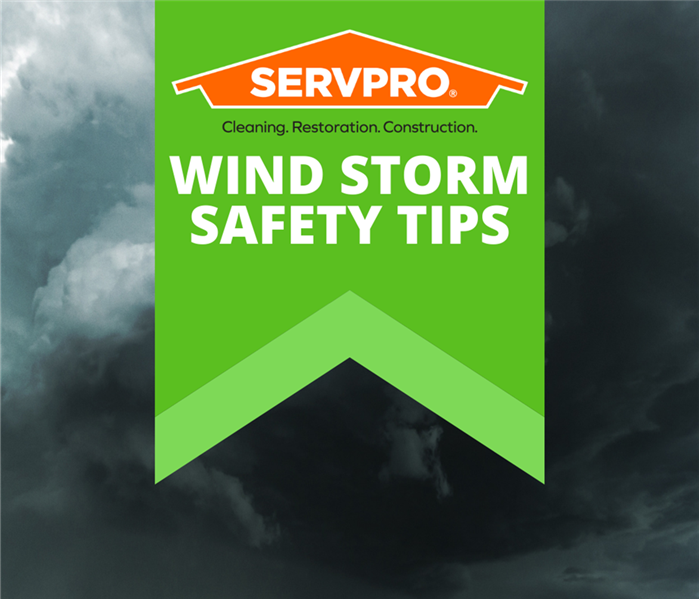 Wind Storm Safety Tips
Wind Storm Safety Tips
Winds can reach speeds of more than 100 miles per hour during extreme weather events such as tornadoes!
High winds of any speed, on the other hand, can cause damage to homes and property, as well as flying debris and shattered glass, which can cause injuries. A disaster preparedness plan for your family, including a disaster survival kit and an emergency evacuation plan, can save your family from injury and inconveniences.
Keep yourself updated!
Weather updates and advisories will be broadcast on the radio and television. Having the most up-to-date information is critical to keeping safe during a weather event. For updates, utilize an NOAA Weather Radio or battery-powered radio, and keep an eye out for mobile alerts.
A high wind alert indicates that persistent winds of more than 25 mph are expected.
Warnings for thunderstorms and tornadoes should be taken seriously since they indicate that severe weather has been detected and is on its way.
During bad weather, seek cover!
- Remove yourself from windows and glass doors and into the center of your house or basement. Take refuge under a stairwell or a large piece of furniture.
- During heavy winds, do not stay in a mobile home. High winds can easily topple them, and flying debris can penetrate their light frames and exteriors.
- Make a safe room for yourself. If you live in a location where violent winds are common, you should consider constructing a safe room in your home.
Protect your home against extreme weather and wind events with these helpful tips!
- Vehicles that you want to leave behind should be parked or stored in a garage. If you don't have a garage, relocate your belongings to higher ground in the event of flooding.
- Garbage cans, patio furniture, barbecues, and other potentially wind-borne items should all be kept inside your house or garage.
- Close the doors and windows to your home. In the event of severe winds, board up windows and glass doors with shutters or plywood to prevent harm from broken glass.
- Secure your outdoor pool and turn it off. To avoid damage, turn off the circuit breaker for your outdoor pool and remove the engine.
- Tree branches that pose a danger should be removed. Pruning branches that may break off during a storm and injure someone or cause damage to your home or vehicles is a good idea.
- A generator can be rented or purchased. A generator can assist keep refrigerators, freezers, and lights running if you can rent or buy one. A severe storm can knock out power for days, if not weeks, at your home.
- Keep an ear out for weather updates on the radio. If you are told to evacuate, follow local officials' instructions and head to a shelter.
- Let your friends and family know where you'll be.
If you don't have time to get to a shelter, go to your safe room if you have one. Otherwise, stay in the center of your house or basement, away from windows, and hide under a stairwell or a large piece of furniture.
Why SERVPRO is a Top Choice for Post-Disaster Cleanup and Restoration
11/1/2021 (Permalink)
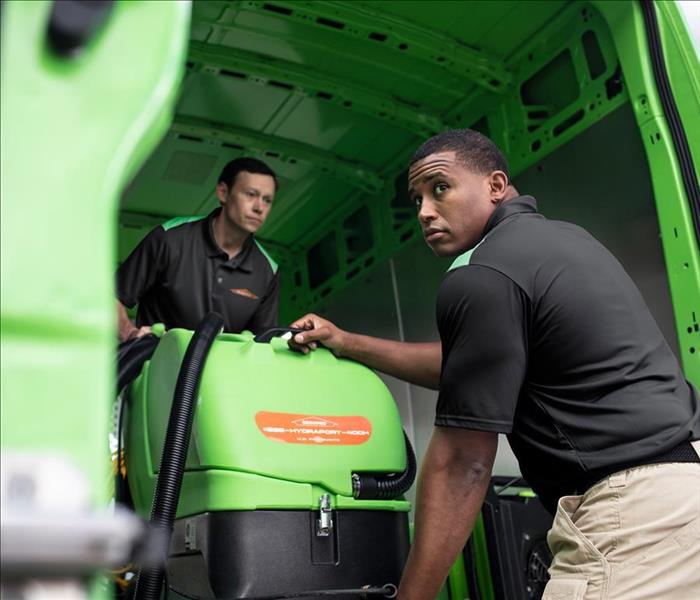 Why SERVPRO is Top Choice
Why SERVPRO is Top Choice
#1 Excellent Disaster Preparedness Resources
SERVPRO's network is one of the reasons for its success in crisis response. Because of the state-wide franchise network, there are enough resources to take on any job in any location. The experts of SERVPRO are prepared to repair commercial or residential damage.
Regardless of the size of the incident, all SERVPRO teams have access to additional resources for a quick and reliable response.
#2 Highly Skilled Groups
Each SERVPRO crew is made up of experts that have vast experience in catastrophe recovery.
SERVPRO is at the forefront of catastrophe recovery on a regular basis, allowing it to develop its processes and respond quickly. These teams are in charge of all areas of catastrophe recovery, including:
2017 Hurricane Harvey
2014 Polar Vortex
2010 Nashville Floods
2005 Hurricane Katrina
#3 Quick Responses for Lowering Total Costs
Storms cause damage on a property, enabling plenty of water to enter regions that should be dry. To save the building's structural integrity, the water must be removed quickly.
SERVPRO conducts a thorough cleaning process to prioritize areas that will be costly to replace or restore if not addressed right away. The response team knows which surfaces should be saved and which may be replaced at a reasonable price. As a result, the restoration time is reduced and the outcomes are more consistent.
#4 Experience with Insurance Companies
After a disaster, dealing with an insurance company is a necessary part of the process. That's why SERVPRO has established a network of contacts in the industry to ensure a seamless and effective relationship. SERVPRO works nicely with any insurance provider and has a good reputation for quality work on-site.
You deserve a clean bathroom!
10/1/2021 (Permalink)
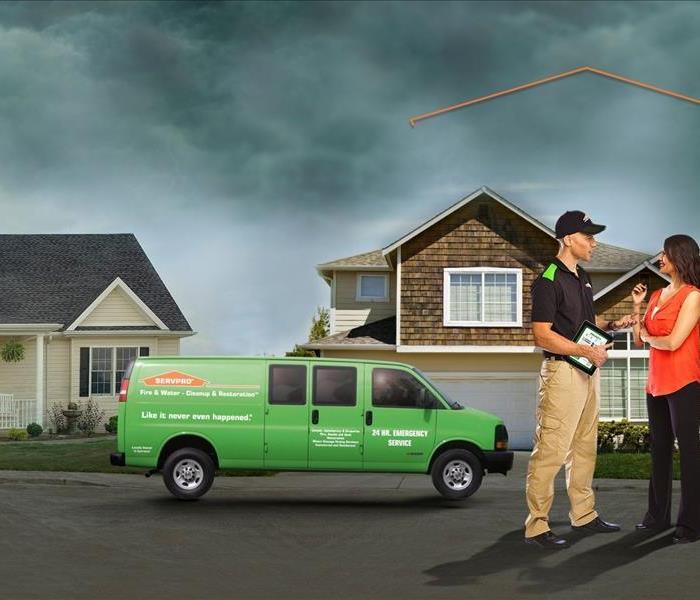 We are here to help!
We are here to help!
Your commercial location in Elmhurst, IL. deserves a clean, comfortable business bathroom. If you suspect mildew in your commercial bathroom, here at SERVPRO of Elmhurst, we can give you a mildew-clean room and provide the preventative services you need. Find out today how to identify and remove mildew.
Identifying Bathroom Mildew
Bathroom mold and mildew can typically be seen. However, here are some other signs to determine whether your bathroom needs professional cleaning:
- Musty odor
- Mold in the corners
- Mildew along grout or caulk
- Standing water on the floor or another surface
These signs typically point to mold or mildew growth. Whether it’s already happened or not, it’s important to thoroughly clean the area. Mildew can quickly damage water barriers throughout your commercial bathroom, including mold and grout.
Replacing Grout and Caulk
While mold cleaning solutions and mildewcide are effective mold and mildew clean techniques, sometimes the problem is deeper than a surface solution can handle. In that case, it may be time to completely remove and replace your grout or caulk.
Grout in between bathroom tiles and caulk along the edges of fixtures are common areas for mildew to grow in a commercial bathroom. Because of the porous nature of grout, it’s essential to completely remove it and replace it to ensure a thorough cleaning.
However, improper removal and installation of these materials can compromise the waterproof barrier and allow water to collect behind sinks, under toilets and in corners of your commercial bathroom. Choose a professional remediation service to maintain the high cleanliness of your business bathroom.
Completing Commercial Cleaning
Clean your commercial bathroom and keep it dry to prevent further mold growth. Work with a company that is Here to Help and is capable of inspecting and removing mildew from your property. When you choose a mildew clean and prevention service, you’ll keep your location protected and comfortable for your customers and coworkers
Top Causes of Water Damage
9/30/2021 (Permalink)
Here are the top causes of water damage
- Appliance leaks or failure
- Sewer backup or clog
- Water overflow and buildup
- Plumbing, leaking, or burst pipes
It's critical to act quickly when a water-related emergency develops. If action is not taken immediately to contain water damage, it can rapidly damage a structure.
Within Minutes:
- Waters spreads rapidly
- Carpet, subflooring, and padding beneath flooring can become saturated quickly
- Furniture begins to leach and stain
Within Hours:
- Furniture will swell
- Cabinetry will distort and weaken
- Dyes from fabric stored together can bleed
Within 24 Hours
Within Days
- Fungi and mold will become visible
- Musty odor will be present
- Painted walls will begin to peel
Within Weeks
- Mold infests organic materials, which will become unsalvageable
- Area becomes hazardous
- Property may have to be gutted down to studs
Within Months
- Cost repairs may be more than what insurance can cover
- Neglect may disqualify owner of property from an insurance claim
Contact SERVPRO Elmhurst today if you have any water damage or concerns! (630)758-1701
Emergency Ready Program for your business
9/29/2021 (Permalink)
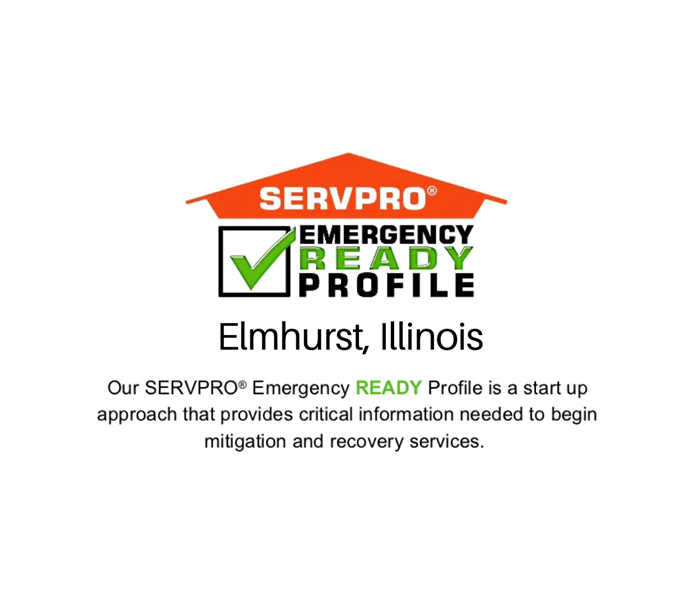 Join our Emergency Ready Program today!
Join our Emergency Ready Program today!
Are you and your clients “Ready for whatever happens?”
If an emergency situation arises in your workplace, give us a call and we'll be there as soon as possible to help.
We're here for you 24 hours a day, 7 days a week to get your business back on track! Our experience includes fire and water damage restoration, while also electronics restoration and document drying.
Our professionals are trained to be aware of legal and environmental issues while working within your budgetary constraints to repair the affected area. We understand that every hour spent cleaning is an hour of lost revenue and productivity.
Preparation is essential for surviving any major disaster, whether it's a minor water leak, a large fire, or a widespread flood. The greatest time to prepare for such tragedies is before they occur.
By becoming a member of our SERVPRO of Elmhurst Emergency READY Program (ERP), you will get access to over 40 years of experience in lessening the impact of natural and man-made disasters.
Give us a call today to schedule your Emergency Ready Program (630) 758-1701!
How to keep your employees safe in the event of a fire!
9/28/2021 (Permalink)
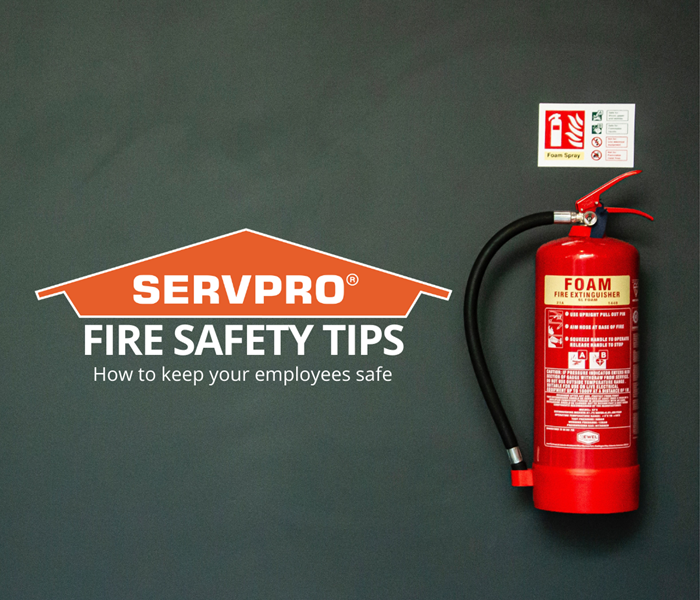 A portable fire extinguisher can save lives and property by putting out a small fire or containing it until help arrives.
A portable fire extinguisher can save lives and property by putting out a small fire or containing it until help arrives.
Your employees are not just members of your team, but also important assets to your company! These suggestions can help them avoid injury in the event of a fire:
- Conduct a fire drill at least once a year to ensure that your personnel are familiar with your workplace's fire safety procedures.
- Have a safety officer on the job. Assign someone to be the office's fire prevention officer. Composing escape routes and meeting points for employees, as well as keeping all of your safety plans, equipment, and information up to current, will be among their responsibilities.
- Sprinklers should be installed. Sprinkler systems are the most cost-efficient and effective technique to stop a fire from spreading. According to the National Fire Protection Association, fires were restricted to the room of origin 97 percent of the time when sprinklers were present.
- Make sure there's room for appliances. Allow some space behind heat-generating gadgets, such as coffee machines and computers, to allow them to cool down. Keep all of your office equipment away from flammable items such as paper or cloth. Unplug these appliances at the end of the day if at all possible, as most company fires occur after normal operation hours.
- Replace wires on a regular basis. Check power cords for fraying, broken connectors, and cracked insulation on a regular basis. These must be replaced right away. When using power strips, only use one extension cord per outlet and follow the manufacturer's specifications for maximum wattage. Avoid "octopus wiring," which occurs when multiple wires and plugs are tangled around a single outlet, as this might result in an overload.
- Plan for an evacuation. Post a fire evacuation plan in various locations throughout the workplace in larger buildings. Never use elevators as part of an evacuation strategy; instead, take the steps. In the event of an emergency, businesses with disabled employees should prepare a detailed evacuation plan for those employees who require additional support.
- Supply a first-aid kit. Employees should be familiar with the location of the first-aid kit in case of fire accidents, which should be located where fire dangers can occur most frequently, such as in the kitchen.
When storms or floods hit Elmhurst, SERVPRO is ready!
9/27/2021 (Permalink)
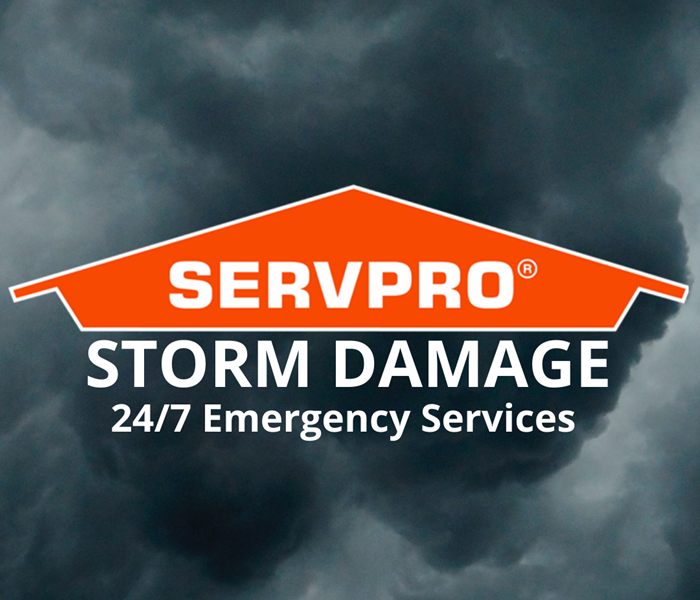 24/7 Storm Damage Emergency Service
24/7 Storm Damage Emergency Service
The effects of a storm or a flood can be catastrophic! You need to act quickly, and you need a professional that has experience with storm damage. SERVPRO Elmhurst Professionals have the training, equipment, and resources to manage any major disaster and can respond quickly to storm and flooding situations.
What do we provide?
- 24 hour Emergency Service
- Highly Trained Water Damage Specialists
- Resources to Handle Storms and Disasters
Regardless of the Storm Damage, We Can Help!
SERVPRO of Elmhurst can handle any size disaster, regardless of the type of storm. Our Disaster Recovery Team can respond rapidly with additional resources during major storms and disasters.
- Flooding caused by heavy rains
- Tornadoes and wind damage
- Ice and snowstorms
Have storm or flood damage? Call us today! (630) 758-1701
SERVPROV of Elmhurst understands agents and adjusters
9/25/2021 (Permalink)
SERVPROV of Elmhurst understands your situation. You have the responsibility as an agent or adjuster to keep claims costs low while still providing the best service to your customers.
Our Claims Information Center provides you quick and accurate information required to make informed decisions, such as:
A Complete Electronic Job File.
- First Notice of Loss.
- Detailed Estimate.
- Digital Loss Photos.
- Scanned Forms and Paperwork.
- All delivered by email or hard copy.
Online Access to All Files.
- New Assignments.
- Pending Jobs.
- Completed Jobs.
Informative Reports to Improve Results
Performance Comparison to Industry Standard.
When you call SERVPRO of Elmhurst, we'll send only qualified vendors to your customer's location. As a result of our dedication, we provide:
- A Customer Care Center to ensure that the claim is handled quickly.
- Best practices and employment process programs.
- Qualification criteria for National Accounts and annual compliance checks.
- Crew and vehicle standards.
- Insurance requirements.
- File documentation requirements.
- Quality assurance program.
Call SERVPRO of Elmhurst today! (630) 758-1701
Water damage can decrease your home value!
9/24/2021 (Permalink)
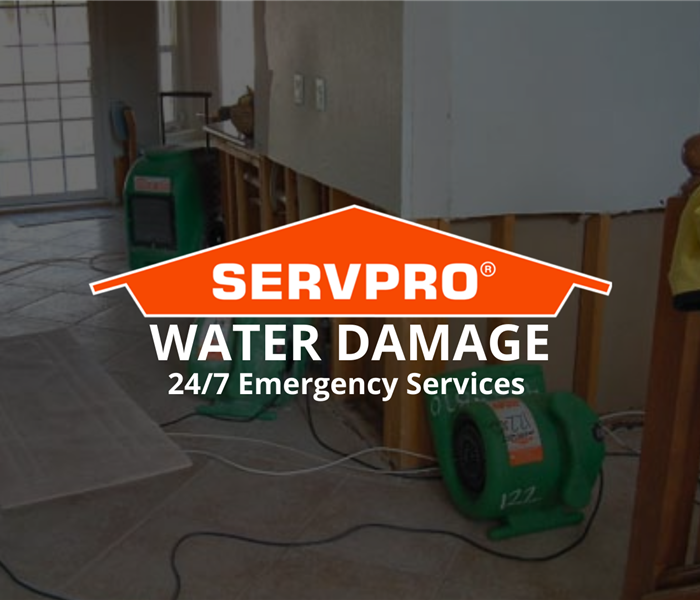 SERVPRO of Elmhurst franchise professionals specialize in water damage restoration.
SERVPRO of Elmhurst franchise professionals specialize in water damage restoration.
With everything that might affect the value of your home, trying to sell your home can be a very hard process. Water damage and the hassles that come with it are one of the things that few people consider damaging a home's value.
Here are types of water damage that decrease the value of your home:
- Structural Issues
- Foundation Issues
- Mold
Structural issues from water damage
When a storm or flood causes significant water damage to your home, the structural integrity of your property may be compromised. Finding and repairing these structural flaws in your home's walls, floors, ceilings, and crawl spaces can help avoid your home's value from plummeting.
It's critical to thoroughly evaluate your property for any structural damage, such as decaying wood, sagging beams, wall cracks, and broken electrical fixtures.
Foundation issues from water damage
If you've experienced water damage from a flood or a busted pipe, it's possible that the water has harmed your foundation. Floods can cause irreversible damage to the foundation of a home with a basement.
This is likely to be the most expensive aspect of repairing your property after water damage, but it is also the part that will have the most impact on its worth. Detecting foundation problems early reduces the cost of repairs. The longer the foundation damage goes untreated, the worse it will get.
Mold from water damage
Mold can form in the walls and carpets if there is water in your home due to a flood or a sewer backup. It can soften your home's materials, causing long-term harm to your walls' drywall, studs, and insulation. Mold thrives on your home's wood and drywall before spreading to the materials it consumes.
Contact SERVPRO Elmhurst today if you have any water damage or concerns! (630)758-1701
Sewer back up from a recent storm
9/18/2021 (Permalink)
If you're worried about sewage backup in your, Elmhurst, IL, home then you may be wondering what mitigation steps you can take to keep your property safe. Here are three things you can do to help protect your residence against potential sewer problems after a heavy storm.
1. Know The Risk in Your Area
When preparing your home against storm damage, it's important to know the risk level of your property. Keep track of storms in the area, know where your property is situated on the local watershed, and have an idea of the likelihood of sewer issues in your area. These things will help you have an idea of what the best mitigation measures are for your home.
2. Take Precautions Before a Storm Arrives
Before backup flooding occurs, there are some steps you can take. You may want to have a floor drain plug or standpipe installed in basement areas, or consider the installation of a sump pump. It's also a good idea to have your sewage system inspected regularly to ensure that everything is functioning correctly before an issue arises.
3. Be Prepared for a Cleanup
Even with the best precautions it's still possible for sewer damage to occur to you home. As such you may want to have a plan in place to take care of any sewer cleaning up that may be required. Have the number for a restoration service on hand, know where the water turn off valve and your electric box are located in your home so that these can be shut down in the event of an emergency, and have access to proper safety gear such as goggles and gloves.
When preparing your home against sewer backup it's important to know what the risk factor of your area is. Knowing this can allow you to take the proper precautions before a storm even occurs. You may also want to have a plan prepared in case these precautions can't protect your property 100 percent. If you have any questions your local restoration team may be able to help.
Hurricane Season 2021
9/13/2021 (Permalink)
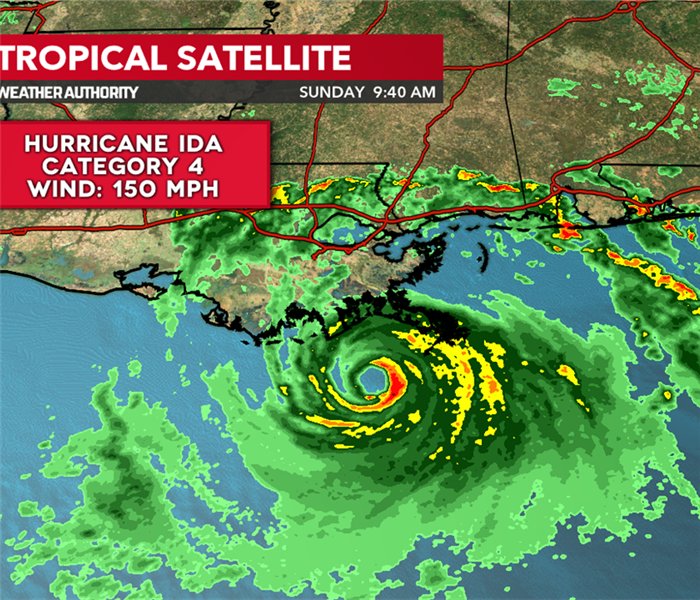 Have a plan and be prepared!
Have a plan and be prepared!
Hurricane season is upon us! Experts say that the hurricane season starts in May and lasts all the way until November on average. Each year is different. However, as on Friday September 10th, it has officially marked its peak of hurricane season for the Atlantic Basin. We have seen during this year there has been 13 named storms, and 5 of those reached a hurricane status and 3 of which became major hurricanes. Here is a list of the 13 hurricanes so far..
1. Ana: Formed near Bermuda on May 22nd
2. Bill: Formed off the East Coast on June 14th
3. Claudette: Formed in the northern Gulf of Mexico June 19th
4. Danny: Formed along the East Coast near Charleston, South Carolina on June 28th
5. Elsa: Formed in the central tropical Atlantic on July 1st
6. Fred: Formed in the eastern Caribbean on August 10th
7. Grace: Formed in the central tropical Atlantic on August 14th
8. Henri: Formed near Bermuda on August 16th
9. Ida: Formed south of Jamaica in the Caribbean on August 26th
10. Julian: Formed far out in the Atlantic on August 29th
11. Kate: Formed in the central, open Atlantic on August 30th
12. Larry: Formed in the far eastern Atlantic on September 1st
13. Mindy: Formed in the northeaster Gulf of Mexico on September 8th
With the knowledge of knowing we have officially hit the peak of hurricane season, here are some tips on how to be prepared for a hurricane in your area.
- Make a plan: If evacuation is necessary, turn off all utilities and follow community disaster preparedness plans. Make sure you select a common meeting place for all family members. Also make sure you have an evacuation plan for your pets.
- Secure the exterior: Trim any large trees and shrubs. Bring in all outside patio furniture, potted plants, bikes and toys inside.
- Install storm shutters: These will protect your windows, doors and skylights with appropriate shutters or impact-resistant glass.
- Check wall hangings and art: Make sure all wall hangings are secure and take notes about your art collection and any existing damage.
- Move your cars: Keep your cars to higher ground or park them in your garage against the garage doors.
- Power up: Fill up your car's gas tank, make sure all cell phones are fully charged, test your generator and always have plenty of fuel ready in case the power goes out.
- Store important documents: Make sure to keep important documents, such as legal papers, birth certificates, marriage license, insurance policy information, and any valuables in a safety deposit box in the closet of your home.
- Prep an emergency kit: You will need to gather any flashlights, portable radio, batteries, non-perishable food, bottled water, cash, blankets, toiletries and clothing.
- Identify a shelter room: This area should be on the first floor in the central part of the house that has no windows.
We here at SERVPRO understand that when disaster strikes, you don't know what will be left from the aftermath. We are always here to help with any mitigation or reconstruction services you may need!
National Preparedness Month
9/13/2021 (Permalink)
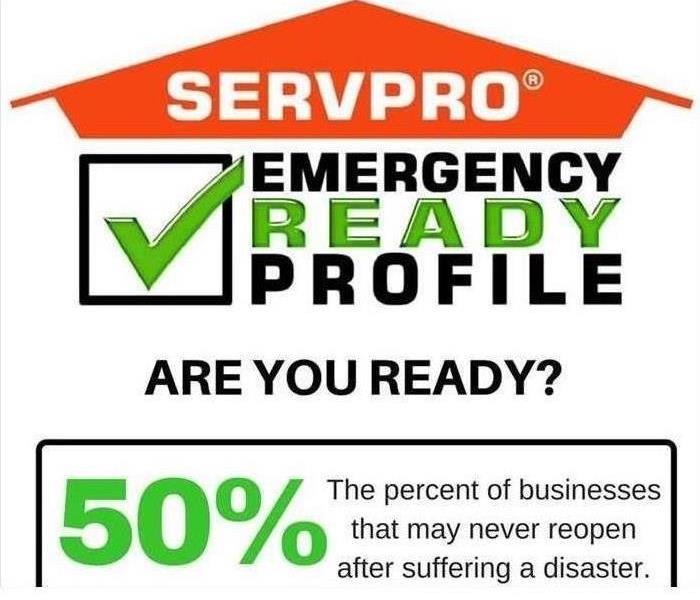 Be prepared!
Be prepared!
As a business owner, insurer or property manager, you are a leader in your community! Therefore, you have the opportunity to set an example to others around you. September is National Preparedness Month (NPM), and this year we are encouraging you all to join your community in preparing for emergencies and disasters. You can do so by leading the efforts to encourage your community to become more prepared as a whole. Disasters WILL HAPPEN, and not only do they devastate neighborhoods, but entire communities including local businesses of all sizes.
As an employer in your community, having a business continuity plan can help protect your company. It can also maximize your chances of recovery after a disaster takes place. There are 3 simple steps to take.
1. Plan to stay in business
2. Encourage your employees to become ready
3. Protect your investment
There are many supporting resources available that can begin to prepare your business for a disaster. We here at SERVPRO can help your business with our Emergency READY Profile (ERP). Here are some of the advantages of our ERP program.
- A no-cost assessment of your facility.
- A concise profile document that contains only the critical information needed in the event of an emergency.
- A guide to help you get back into your building following a disaster.
- Establishes your local SERVPRO franchise professional as your disaster mitigation and restoration provider.
- Identification of the line of command for authorizing work to begin.
- Provides facility details such as shut-off valve locations, priority areas, and priority contact information.
Preparation is KEY to making it through any size disaster, whether it is a small water leak or a large fire. The best time to plan is not when the event happens, but well before it takes places. No one ever plans on a disaster, but you now can plan for it and be prepared. Call us today to set up your very on Emergency READY Profile!
Commercial Cleanup
9/13/2021 (Permalink)
If you can’t summon help quickly, a fire can quickly sweep through your Elmhurst, IL, office and leave a trail of devastation in its wake. Fire damage can be severe and make it impossible for you to resume work duties in your building. Ironically, the very water firefighters use to eliminate the fire can also cause major problems. Trained professionals have the equipment and skill to clean up both types of damage.
Thorough Inspection
When you call a professional disaster cleanup crew to your office, the team won’t jump right in and start working without a plan. The company will evaluate the effects of the fire damage in order to come up with an effective strategy. The technicians will do the following:
• Make note of which areas of your building were affected.
• Determine the extent of the damage.
• Decide what areas and items you can salvage and which ones you must replace.
• Establish a plan of attack that will yield the most complete, time-effective results.
Remove Standing Water
A fire hose can pump out hundreds of gallons of water while a firefighter is battling a blaze. It’s no wonder water can wreak havoc in your office after a fire. A technician will use wet vacuums and other specialized water removal equipment to make sure there is no leftover water on your floor or on furniture or other objects. Next, the team will dry the areas with dehumidifiers and high-powered blowers.
Clean and Sanitize
Sucking up water and drying the area isn’t enough to mitigate water damage. The professionals will also use chemicals to thoroughly sanitize any areas where there had been water. This will minimize the chances of mold growth.
Fire damage and water issues go hand in hand after a fire. By understanding the process the pros use, you can have peace of mind and confidence that your office will be in good hands.
Disaster Plan for Your Business
7/8/2021 (Permalink)
 Have a plan!
Have a plan!
When it comes to owning a commercial business, you need to make sure you have a disaster plan in place. Natural disasters don't give you a warning to get out in time, and sometimes you only have minutes to act fast. One natural disaster that most people are not prepared for are earthquakes. Here are 6 steps to prepare you if an earthquake where to take place.
1. Assess the Earthquake Risk of Your Building
You need to get a clear picture about your business' earthquake risk factors. You need to know how ready or NOT ready your business is. It is recommended that all businesses perform risk assessments that find the strong and weak points of your plan. You should also schedule a consultation with an experienced firm to elevate the structural integrity of the building.
2. Create a Disaster Plan
These should be created and distributed to all of your employees beforehand. It is important to include ALL of you employees as you are developing a disaster plan. This way they if they notice any signs of an earthquake, they will know exactly what to do. Some of the things your disaster plan should include are:
- Contact information for all employees
- Communication plan
- Talk with employees with disabilities and make arrangements
- Hotline or text message system
- Schedule regular earthquake response drills to practice
- Emergency kit
- Safety checklist
3. Identify Your Building's Potential Structural Issues
Every business is different, and there is no one-size-fits-all approach. You will need to evaluate every aspect of your business and make preparations that are unique to your building's property. You need to understand the risks and take specific actions to help prevent earthquake disasters for your business, and to also protect your staff.
4. Bring in Expert Advisors
You can't afford to waste your time on hearsay or just anyone's word. Your business, life, and the lives of your employees and customers depends on doing things correctly and being truly prepared. Make sure you choose a reputable earthquake retrofitting contractor based on years of experience and high ranking results. This way it can translate to lives and business saved in those areas.
5. Develop a Comprehensive Emergency Communications Plan
Keeping your business in business after an earthquake often depends on effective communication. Be sure you have a plan in place that takes everyone into account. This includes your employees, your customers and your suppliers. Make sure you set up a backup communications plan that enables you to keep lines of communication open, even if you are unable to access your building. Make sure you employees know who to contact before hand so they aren't calling people they shouldn't have to call. Maintain an emergency contact list with police, fire, ambulance, hospital and other emergency services that employees know how to access quickly. Also, have your insurance company and attorney's numbers in a secure place.
6. After the Earthquake
Remember that it might not be readily apparent whether your building is safe after an earthquake takes place. There are usually aftershocks for hours and days afterward. Be sure to contact an experienced expert first for an earthquake damage safety assessment before you allow employees and customers back into the building.
Fire Safety Craft Event
6/1/2021 (Permalink)
 Craft day for the daycares!
Craft day for the daycares!
SERVPRO of Elmhurst recently teamed up with the Hillside Fire Department to help bring fire safety awareness to the children in the Hillside community. Chief Carling at the Hillside Fire Department donated coloring books, fire fighter hats, stickers, and training exercises for the children to do one day. We then reached out to our local daycares in the Hillside area to see if this is something they would be interested in doing one day as a craft/fire safety drill day. THEY LOVED IT! They wore their fire hats and badge stickers, while coloring in what they should do if a fire were to take place. They then ran through a fire drill, as well as practiced stop, drop and roll! They were able to keep all the fun crafts / goodies that SERVPRO and the Hillside Fire Department provided. Because of COVID the fire departments are not able to do their fire safety awareness days with the local schools, so this was the perfect way to keep getting awareness out to the young children in the community. Following the event, Chief Carling reached out to us about doing a press release in the Hillside Harold because he absolutely loved the event and the pictures that the daycare sent over to us. Be on the look out in the Hillside Harold to read more about our event!
1 Year Anniversary!
5/3/2021 (Permalink)
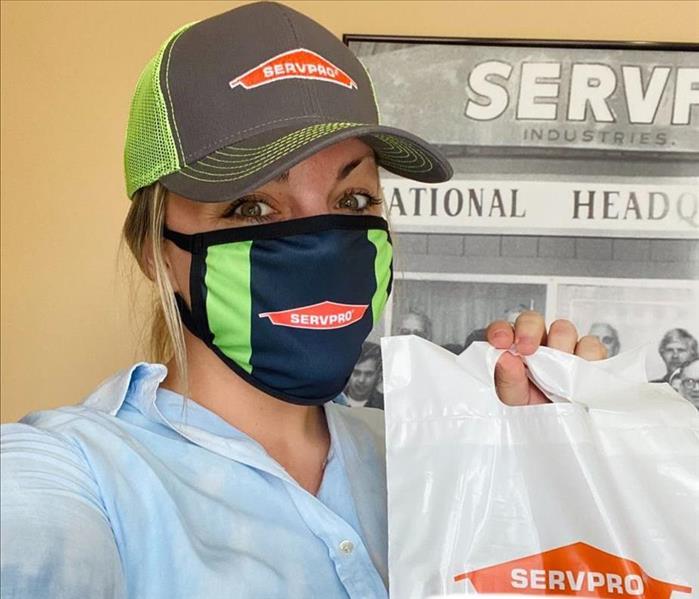 Thank you!
Thank you!
When thinking about what I wanted to do with my life as an undergraduate at DePaul University, I wasn't too sure. I had secured my Associate's Degree in Sociology and Psychology, and was entering my master's program at DePaul. This was when I decided to change my studies to marketing, and dive deeper into that field. After graduating with MS from DePaul, I was approached by a friend to look into working for the marketing team at SERVPRO. I had zero knowledge when it came to what SERVPRO did outside of the basic gist of the company. On top of that, I then was trying to work through a pandemic!! What a crazy time it was, but I recently hit my one year anniversary here at SERVPRO and I decided to reflect on the past year. During the pandemic, I was able to train more and get better knowledge of what SERVPRO does day in and day out. As things started to open back up, I was confident in my marketing and sales ability to tackle the daily routes. I now have a terrific relationship with all of our local first responders! We work alongside them when it comes to free COVID sanitations to their departments in order to keep them safe, and with community events by bringing fire safety tips and tricks. I have built so many wonderful and beautiful relationships during my one year anniversary, and some have even become friends that I hangout with on the weekends. I can't thank my marketing team and owner enough for giving me the opportunity to develop not only my work skills, but also as a person. THANK YOU SERVPRO!
Spring Cleaning!
4/2/2021 (Permalink)
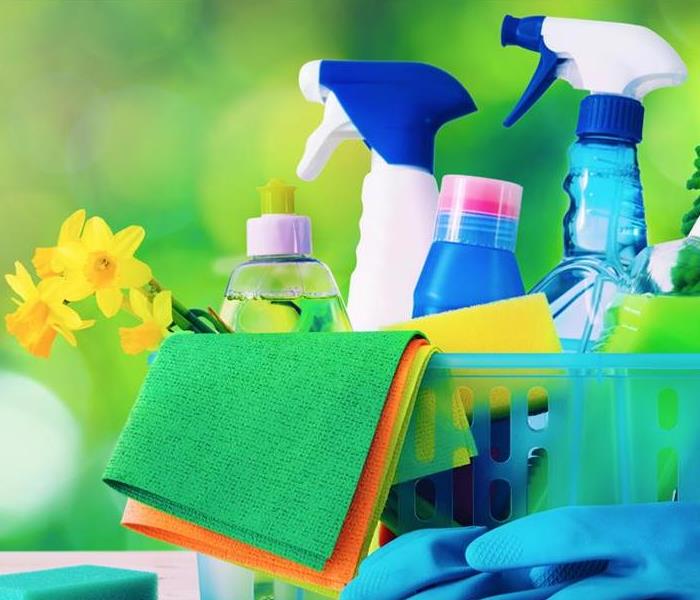 Call us today 630-758-1701
Call us today 630-758-1701
Spring cleaning time is here again, and a great opportunity to clean and organize your living spaces.
Here are some great tips to freshen up your home and make is sparkle:
Wipe off a dirty faucet.
To get rid of lime buildup, make a paste of 1 teaspoon vinegar and 2 tablespoons salt. Apply to sink fixtures and rub with a cloth.
Tidy up a toilet.
Pour a cup or more of diluted white distilled vinegar into the bowl. Let sit several hours or overnight. Scrub well with a toilet brush and flush.
Eliminate odors.
Swab plastic containers with a cloth dampened with vinegar.
Freshen up the fridge.
Clean the shelves and walls with a solution of half water and half vinegar.
Battle litter-box odor.
Cat litter can leave behind an unwelcome smell. Eliminate it by pouring a half-inch of white distilled vinegar into the empty litter box. Let stand for 20 minutes, then rinse with cold water.
Steam away a microwave mess.
Fill a small bowl with equal parts hot water and vinegar, and place it in the microwave on high for 5 minutes. As the steam fills the microwave, it loosens the mess, making clean up a breeze.
Remove wax.
If you get melted candle wax on your wood furniture or floors, gently wipe it away with a cloth soaked in a solution of equal parts white vinegar and water.
Erase crayon.
If your kids get crayon marks on the walls or floor, dip a toothbrush in white vinegar and gently scrub. The vinegar breaks down the wax, making for an inexpensive, nontoxic way to clean up after children.
Restore showerhead pressure.
If your shower-head gets clogged with mineral deposits, soak it for 15 minutes in a mixture of ½ cup vinegar and 1 quart water.
Another great do it at home cleaning solution is baking soda. Baking soda is great to freshen up stale and stinky smells in the home.
Here are some tips from Better Homes and Gardens for uses of baking soda around the house:
Stale-smelling sponges
Soak these kitchen staples in baking soda and water to freshen them up so you can use them a little longer.
Musty upholstery and carpets
Deodorize the soft, cushy places around your house by sprinkling surfaces with baking soda, letting it sit for 15 minutes, and then vacuuming it up.
Grimy toys
Naturally fight the effects of your little one's grubby hands by wiping them with a sponge dipped in a baking soda and water solution.
A mildew-y bathroom
Scrub your tub, tile, sink and shower curtain with a damp sponge and baking soda. Rinse to reveal gleaming surfaces.
A messy grill
Combat a summer's worth of cookout grime by sprinkling some baking soda on your grill-cleaning brush before you scrub away.
Finally, one of my favorite non chemical cleaning items is to use lemon. Lemons are a natural, mild disinfectant, and a quick trip to the store and you have a powerful cleaning weapon with no worries about chemicals.
According to thekitchn.com, lemons are "nature's little hand scrubbers". Here are some of their useful tips on how to use lemon in your spring cleaning:
Clean Wood Cutting Boards
Apply salt: Sprinkle the cutting board with coarse salt.
Scour the surface: Using a lemon half with the cut side down, scour the surface, squeezing slightly to release the lemon juice as you go.
Let sit, then scrape off: Let sit for 5 minutes, and then scrape the gray, dirty liquid into a small bowl using a bench scraper, and discard.
Rinse: Give the surface a final rinse with a clean wet sponge.
What to expect with the unexpected
4/2/2021 (Permalink)
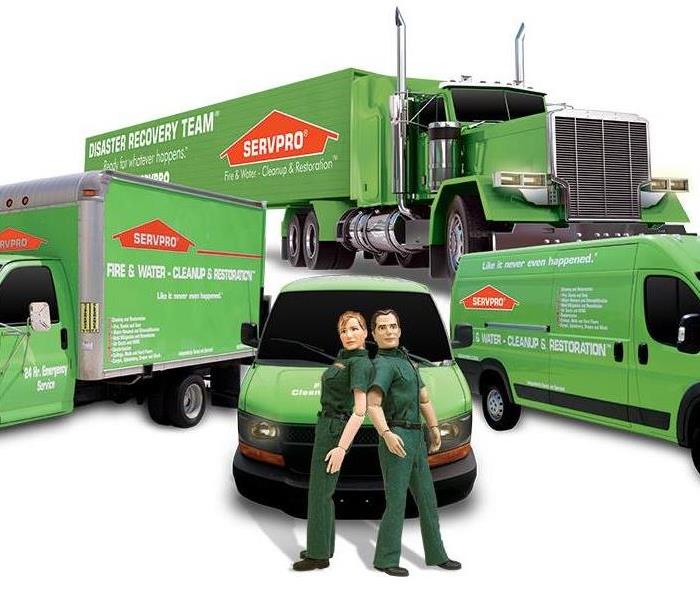 Call us today 630-758-1701
Call us today 630-758-1701
SERVPRO of LaGrange Park/North Riverside is available 24 hours a day for water emergencies, large or small. When you are dealing with water damage, immediate action is crucial. A delay of just a few hours can greatly increase the severity of the water damage.
We Answer the Phone Ready to Help
We understand that when you call us, you may be feeling confused, stressed, and vulnerable. You need an expert to guide you through this crisis. SERVPRO of LaGrange Park/North Riverside has the specific water damage training and experience to help you through this tough time. We specialize in water damage restoration—in fact, it's the cornerstone of our business.
What to Expect
When you call, we will ask several questions regarding your water damage emergency. These questions will help us determine what equipment and resources to bring, including how many trained SERVPRO Professionals may be needed.
Our SERVPRO Representative will ask several questions:
- Your name and contact information
- Your insurance information (if applicable)
- The street address of the water-damaged home or business
- When did the flooding or water damage occur?
- What caused the water damage (if known)?
- Is there electricity available (on-site)?
Smoking in the home
3/12/2021 (Permalink)
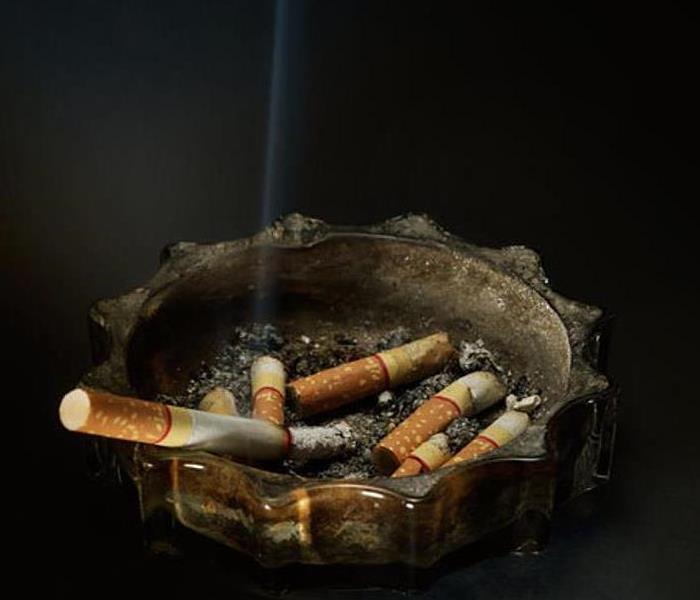 Emergency Response Service 24/7
Emergency Response Service 24/7
According to the National Fire Protection Association, smoking materials that include cigarettes, pipes, and cigars started an estimated 17,200 home structure fires. This was reported from U.S. fire departments. Amongst these 17,200 estimated fires, these fires cause 570 deaths, 1,140 injuries and $426 million in direct property damage. It was also reported that smoking materials caused 5% of reported home fires, 21% of home fire deaths, 10% of home fire injuries, and 6% of the direct property damage. According to the NFPA, most deaths in home smoking-material fires were caused by fires that started in bedrooms or in living rooms, family rooms or dens. It is also a face that the risk of dying in a home structure fire caused by smoking materials rises with age.
With that being said, it is encouraged to use smoking materials outside of the home. Designate a "smoking area" such as the garage or outside. This will help eliminate the risk of a fire starting in the actual home.
Spring Thaw
3/12/2021 (Permalink)
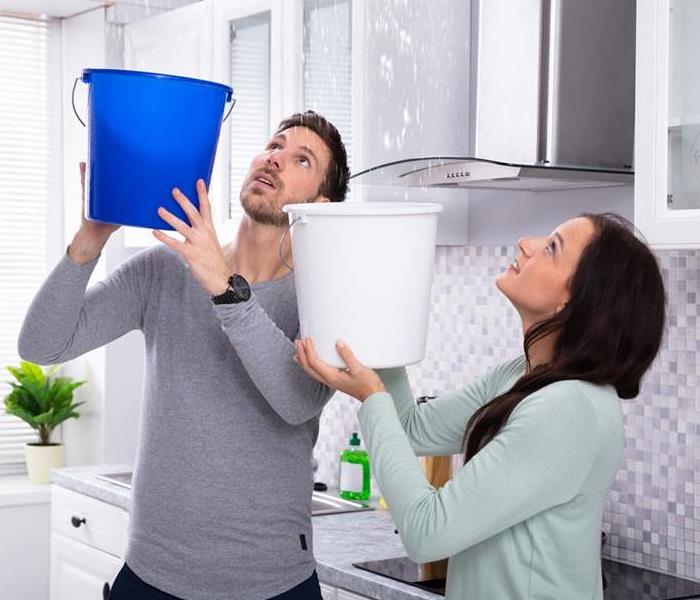 Here are some tips!
Here are some tips!
As we begin to enter Spring season, the process of snow melting can cause water damage to homes and businesses. This will then lead to flooding. It could be minor or major, but still cause water damage problems. Here are some ways to help prevent water damage as we enter this spring thaw out season. Now, you may not be able to prevent water damage under ever circumstance, but you can prepare your home ahead of spring-thaw months to prevent common causes of damage.
1. Basement pumps- install a sump pump or sewer backflow value and keep a battery-operated backup in case of power failure. Also, make sure to consider installing a water alarm that warns when water is accumulating in your basement.
2. Basement storage- Make sure to keep valuable items out of your basement. Removing any electronics or stored valuables from your basement prior to spring-thaw warnings could prove to be an important ounce of prevention.
3. Debris removal- Be sure to remove debris from window wells, gutters and downspouts.
4. Doors and windows- Check for any leaks around doors and windows.
5. Exterior walls- Keep all exterior walls of your home well painted and sealed.
6. Flood drains- If you have flood drains, make sure they work properly.
7. Foundation cracks- Make sure to inspect your foundation for cracks that will allow water seepage and initiate repairs.
8. Fuel tanks- Permanently anchor any fuel tanks.
9. Grading- inspect the grading around your home and make any changes. Design the grading to encourage the water to flow away from your home.
10. landscaping- Make sure to trim trees and bushes away from your home and do not store wood or compost piles nearby.
11. Roof- Keep your roof in good repair. Unless a tree falls on your roof during a storm, most insurers expect you to maintain your roof to prevent water leaks caused by snow melting or torrential downspouts.
Whether you are able to control the situation or not, we here at SERVPRO are always here to help you get your home or business back to like the disaster never even happen. That is way we are always here to help!
Frozen Pipes
1/31/2021 (Permalink)
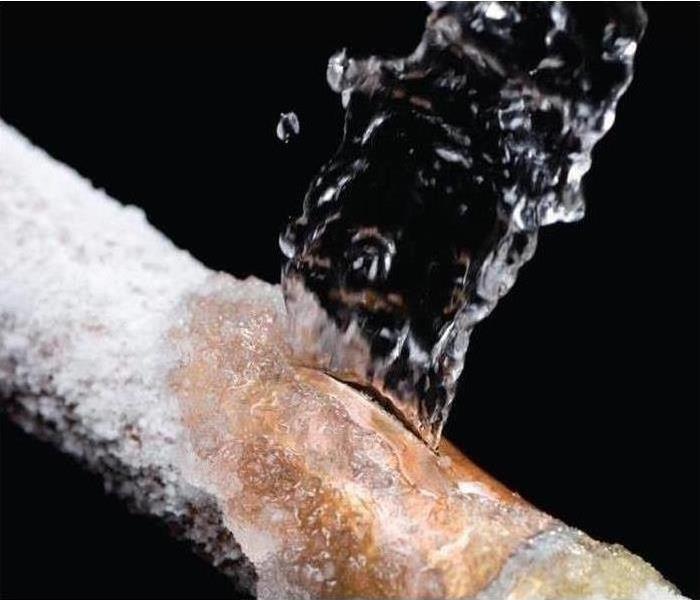 Frozen Pipe
Frozen Pipe
Thawing a frozen pipe the correct way is crucial to minimizing the damage. In order to thaw a frozen pipe, you need to first determine which pipe or pipes are frozen. You can do this by turning on the faucets, and if no water comes out or only a slight trickles out, then you have a frozen pipe. Before you begin attempting to thaw a frozen pipe, you need to open the faucet that the pipe feeds water into. You need to make sure to open both the hot and cold handles. This then will help relieve pressure in the system, and then will allow the water to escape once you begin to thaw the pipe. When beginning to thaw the pipe, you should always start near the faucet then work your way down to the blockage. This will help ensure that the melting ice and steam is able to escape through the open faucet. If you start the thawing process closer to the blockage, the melting ice could get stuck behind the blockage, creating more pressure in the pipe and increasing the chances the pipe will burst. When it comes to thawing the frozen pipe, you could use a hair dryer, heat lamp or portable space heater, hot towels, or electrical heating tape. If the frozen pipe is enclosed, you will need to either turn the heat up in the property, infrared lamp, or cut out a section of the wall to thaw out the frozen pipe/pipes. Remember NEVER attempt to thaw a pipe using an open flame. This can not only damage the pipe, but it can also start a fire in your property. If the frozen water pipe does burst, the first thing you should do is shut off the main water line into your property. This then will prevent additional water from flowing and damaging your property. Then you will need to call a professional, like SERVPRO, to help fix the problem. Therefore, in order to help prevent frozen pipes make sure to keep the heat on in the home, allow faucets to drip slightly, keep all interior doors open, seal up holes and cracks, add extra insulation, and remove exterior hoses and shut off interior valves feeding those hoses.
Continuing Education Classes
1/29/2021 (Permalink)
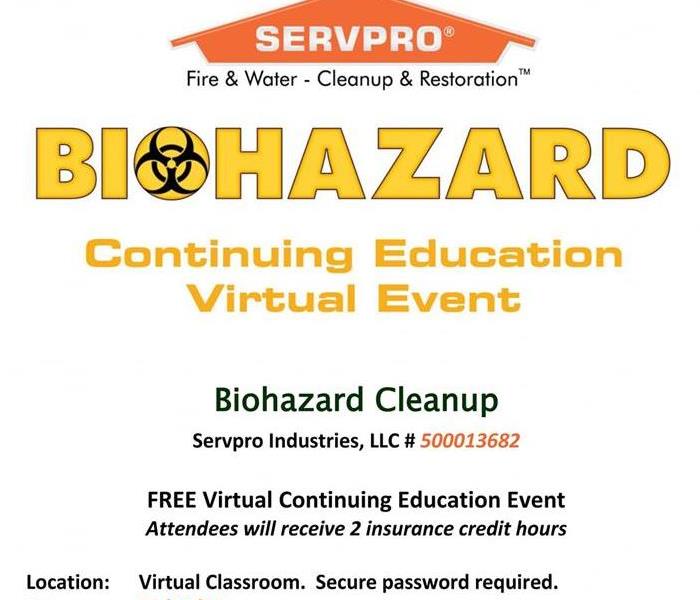 Upcoming Class!
Upcoming Class!
Every year, SERVPRO of Elmhurst provides continuing education in the areas of water, fire and mold mitigation. Education increases the opportunity for the community of professionals responsible for helping you when disaster strikes: The more you informed the community of first responders, the better able to help limit damage, save important personal belongings and control costs during a time of crisis.
At SERVPRO of Elmhurst, we work with adjusters, insurance agents, real estate agents, brokers, home inspectors, and office professionals by providing state-sanctioned Ethics Classes. Raising the bar when it comes to how people are treated especially in the time of need to protect their homes and personal belongings is essential to the insurance claim process.
Our goal is to make it like it never happened. As a recent client said, "the whole clean up and insurance process was as painless as it could have been."
Check in with us on our upcoming classes. We are now offering virtual CE classes!
Toys for Tots
1/22/2021 (Permalink)
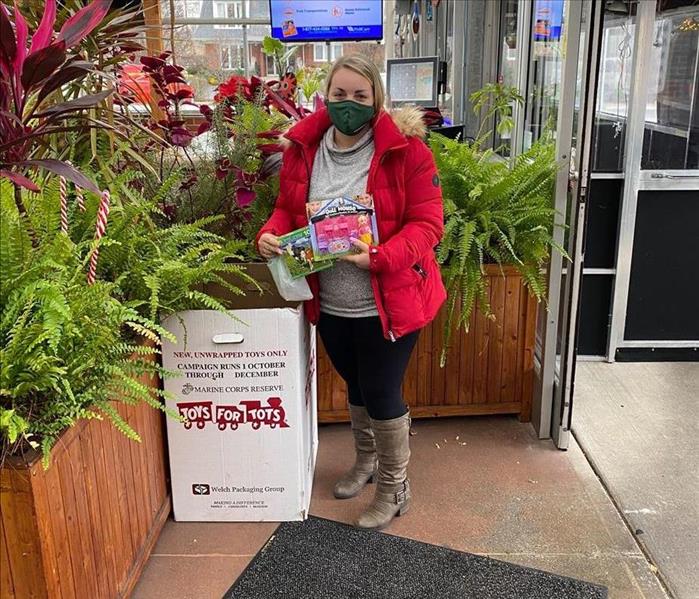 Worldwide Donation
Worldwide Donation
Toys for Tots is such a huge donation event that happens every year around Christmas time. The mission of the Marine Toys for Tots Program is to collect new unwrapped toys and distribute those toys to less fortunate children at Christmas. The primary goal is to help bring the joy of Christmas and send a message of hope to America's less fortunate children.
In order to better execute the program, in 1991 the Marine Toys for Tots Foundation was created at the behest of the Marine Corps. It is an IRS recognized 501(c)(3) not-for-profit public charity group. It is governed by a board of directors, all of whom are veteran Marines and successful business leaders from throughout the nation. The foundation's professional staff is headquartered in the Cooper Center, which is located just outside of the Main Gate of Marine Corps Bass about 35 miles south of Washington D.C..
The Marine Toys for Tots Program collected and distributed 19 million toys to 7.3 million less fortunate children in the past year allowing them to experience the joy of Christmas and receive a message of hope that otherwise would not have been there. This community action program took place in over 800 communities covering all 50 states, the District of Columbia, Puerto Rico, and the Virgin Islands.
We here at SERVPRO of Elmhurst, Arlington Heights/Prospect Heights, and Lagrange Park/N. Riverside, took part in helping donate over 30 toys to 15 different drop off locations this year. We want to help do our part in the community by giving children in need the feeling of joy on Christmas when it comes to unwrapping presents and seeing an awesome toy. This was such a humbling experience for our team, and cannot wait to take part again next year!
Commercial Property
1/10/2021 (Permalink)
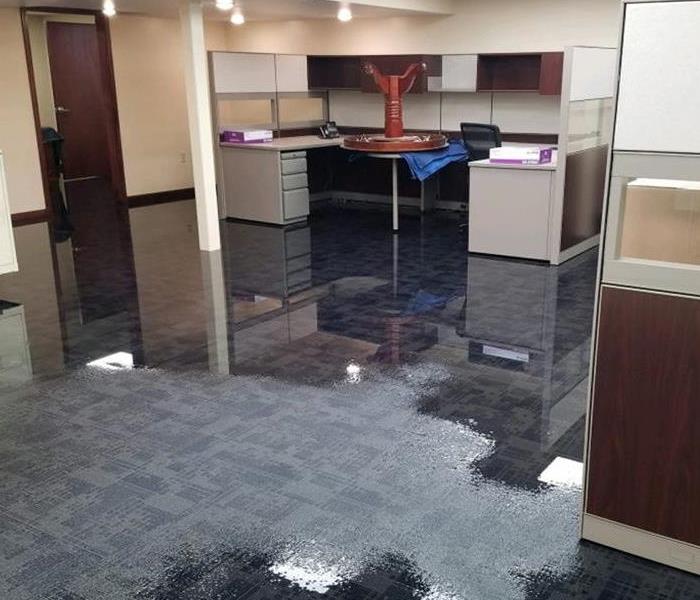 Commercial Property
Commercial Property
You want your business to make as much profit as possible, but you may be losing money without even realizing it. Leaks from damaged pipes, as well as other areas, are a common source of trouble in many buildings. It is important to perform regular inspections to make sure everything is in top condition. Here are a few problems that might end up costing you money.
1. Damaged Roofing
Leaking pipes are not the only potential source of excess water. The roof is an important part of the structure of your business, as it protects you from severe weather and keeps the inside of the building dry. However, if you do not properly maintain your roof, you could end up with a lot of damage. In some cases, the structure of the building may weaken or a mold growth might develop. Make sure to regularly check the condition of your building and perform repairs as needed.
2. Broken Appliances
Another common source of water is from broken appliances. The damage here can range from a small leak to a lot of flooding. One way to prevent this is to test your equipment regularly to ensure it is in proper working condition. As items begin to age and break down, replace them to prevent any significant problems.
3. Pipes and Plumbing
Damaged pipes can sometimes be a hidden source of wasted water and money. If you are not performing regular maintenance, a persistent leak could end up costing hundreds or thousands of dollars in extra water bills. Leaks can also indicate aging pipes that could cause a lot of damage if not replaced.
Performing regular maintenance in your building is a great way to locate problems and prevent big issues from leaks or damaged pipes. If you do experience damage, however, a water restoration company can perform necessary repairs to your building and belongings.
Winter Storms
1/7/2021 (Permalink)
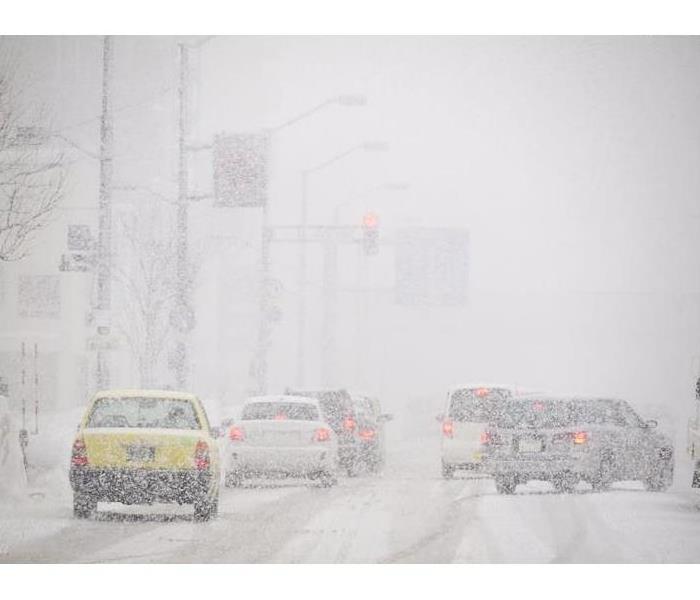 Be prepared!
Be prepared!
Protecting your home is vital in the winter months. A frozen water pipe can burst and flood your house. An ice dam in your gutter can cause water to seep into and saturate an interior walls of your home. Here is a list from Nationwide insurance that they advise their homeowners on during the winter months to prepare their homes for the cold.
- Clean out the gutters, disconnect and drain all outside hoses. If possible, shut off outside water valves.
- Insulate walls and attics, and caulk and weather-strip doors and windows.
- Repair roof leaks and remove tree branches that could get weighed down with ice or snow and fall on your house – or your neighbor's. (Avoid liability for the latter.)
- Wrap water pipes in your basement or crawl spaces with insulation sleeves to slow heat transfer.
- Consider an insulated blanket for your hot water heater.
- If you have a fireplace, keep the flue closed when you're not using it.
- Have a contractor check your roof to see if it would sustain the weight of a heavy snowfall.
- Make sure your furniture isn't blocking your home’s heating vents.
- During cold spells, keep cabinet doors open to allow warm air to circulate around pipes, particularly those in the kitchen and bathrooms.
- Keep a slow trickle of water flowing through faucets connected to pipes that run through unheated or unprotected spaces.
- If your house will be unattended during cold periods, consider draining the water system.
- Avoid ice dams– where water from melted snow refreezes in the gutters and seeps in under the roof, soaking interior walls. Here’s how:
- Ventilate your attic.
- Insulate the attic floor well to minimize the amount of heat rising through the attic from within the house.
- Consider having a water-repellent membrane installed under your roof covering.
If you do find that you have damage to your home, the Insurance Information Institute has published some tips on what to do in the case of a winter storm and managing the damage to your home.
- Take pictures of the damage immediately. If you have "before" pictures, that's even better. Those pictures will help ensure that your insurer cannot claim that the problem was preexisting.
- Make temporary repairs to keep the damage from getting worse but hold on to all of your receipts.
- Don't make pricey repairs before the insurance adjuster arrives.
- Don't assume something is not covered. Take out your policy. Most weather-related damage like burst pipes, a collapsed roof and ice dams are covered.
- Call a reputable company to come and help with any damages to your home. Choose a company that will work with your insurance company.
SERVPRO of Elmhurst is here to help in your time of need for all your winter storm damage needs. Give us a call at 630-758-1701. We work with your insurance companies to make it “Like it never even happened.”
Lending a helping hand
1/5/2021 (Permalink)
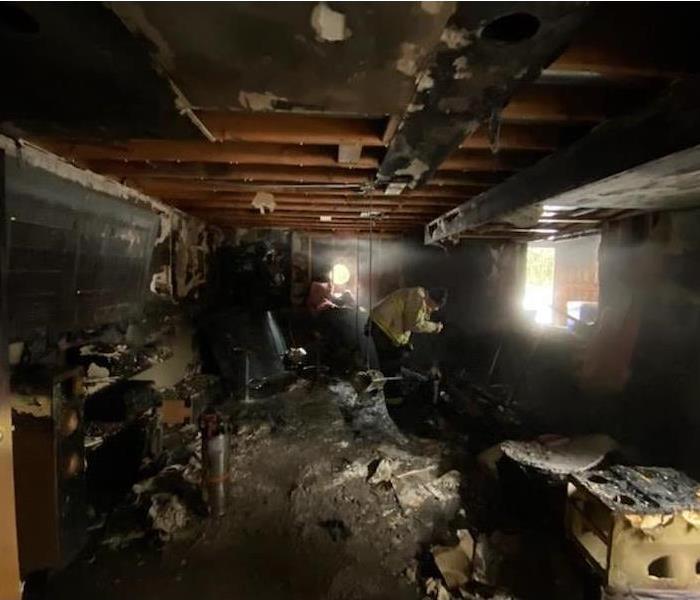 Residential Fire Damage
Residential Fire Damage
We have a really great relationship with our local fire departments, and follow their social media pages. After scrolling through our daily feed, we came across the Addison Fire Department's post about a local fire. What stood out about this post was that our local fire department and other FDs went to help with this major residential fire that took place. The AFPD responded to a house fire, and the smoke detectors did their job by alerting the family of the fire. They were all able to escape safely. They were very thankful for the help from the Wood Dale FPD, Elmhurst FD, and Itasca FPD for coming out to help. The family had told the firefighters that there were two guinea pigs in the home, and they where able to find and save them. They guinea pigs received O2 therapy and vigorous rubbing, and both were successfully resuscitated. The fire started in the basement, and the heat and smoke rose up throughout the house. They enforced to make sure your smoke detectors are working, and the batteries are changed! They also stated to make sure you keep your bedroom doors closed when sleeping, and try not to risk your life to save a pet. That is what the firefighters are for, and they will do their best to rescue them.
The main take away from this message was to always make sure to test your smoke detectors at least once a month, and the batteries should be replaced at least once or twice a year. Also, a huge shoutout to our local fire department for helping out a different fire department in order to get everyone out safely, along with the pets.
What can happen after an snow/ice storm
1/5/2021 (Permalink)
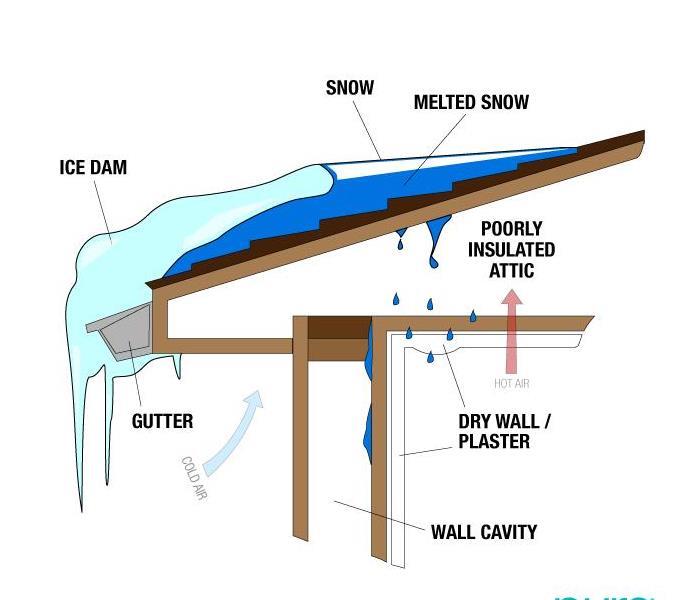 Be aware!
Be aware!
When looking at roofs this winter, icicles hanging along them may look beautiful but can be very dangerous. This is because the icicles forming and snow on the roof can lead to ice dams. This is thick ridges of solid ice that build up along the eaves. Dams can tear off gutters, loosen shingles, and cause water to back up and pour into the building or home. In result, this can lead to peeling paint, warped floors, stained and sagging ceilings. Also, soggy insulation in the attic, which loses R-value and becomes a magnet for mold and mildew.
Here are some ways in order to prevent ice dams. The first is to use heated cables. Attach these with clips along the roof's edge in a zigzag pattern, and the heated cables help prevent ice dams that lift shingles and cause leaks. This solution allows you to equalize your roof's temperature by heating it from the outside instead of blowing in cold air from the inside.
Next is to blow in cold air. Hacking away at ice dams with a hammer, chisel, or shovel is BAD for your roof. Also, throwing salt on them will do more harm to your plantings than the ice. Therefore, take a box fan into the attic and aim it at the underside of the roof where water is actively leaking in. This targeted dose of cold air will freeze the water in its tracks.
You can also rake it by pulling off snow with a long-handled aluminum roof rake while you stand safely on the ground. A rake with wheels will instantly change the exterior temperature of your roof without damaging shingles.
De-icing methods deal with diminishing the damage after the dam has formed. Fill the leg of a discarded pair of panty hose with a calcium chloride ice melter. Lay the hose onto the roof so it crosses the ice dam and overhangs the gutter. You can use a long-handled garden rake or hoe to push it into position. The calcium chloride will eventually melt through the snow and ice and create a channel for water to flow down into the gutters or off the roof.
Lastly is a permanent fix for ice dams. Getting ride of ice dams for good is simple. Just keep the entire roof the same temperature as the eaves. This is done by increasing the ventilation, adding insulation, and sealing off every possible air leak that might warm the underside of the roof.
1. Ventilate Eaves and Ridge
- A ridge vent paired with continuous soffit vents circulates cold air under the entire roof. Both ridge and soffit vents should have the same size openings and proved at least 1 square foot of opening for every 300 square feet of attic floor. Place baffles at the eaves to maintain a clear path for the airflow from the soffit vents.
2. Cap the Hatch
- An unsealed attic hatch or whole-house fan is a massive opening for heat to escape. Cover them with weather stripped caps made from foil-faced foam board held together aluminum tape.
3. Exhaust to the outside
- Make sure that the ducts connected to the kitchen, bathroom, and dryer vents all lead outdoors through either the roof or walls, but never the soffit.
4. Add insulation
- More insulation on the attic floor keeps the heat where it belongs. To find how much insulation your attic needs, check with your local building department.
5. Install sealed can lights
- Old-style recessed lights give off great plumes of heat and can't be insulated without creating a fire hazard. Replace them with sealed "IC" fixtures, which can be covered with insulation.
6. Flash around chimneys
- Bridge the gap between chimney and house framing with L-shaped steel flashing held in place with unbroken beads of a fire-stop sealant. Using canned spray foam or insulation isn't fire safe.
7. Seal and insulate ducts
- Spread fiber-reinforced mastic on the joints of HVAC ducts and exhaust ducts. Cover them entirely with R-5 and R-6 foil-faced fiberglass.
8. Caulk penetrations
- Seal around electrical cables and vent pipes with a fire-stop sealant. Also, look for any spots where light shines up from below or the insulation is stained black by the dirt from passing air.
Understanding the lifecycle of ice damming is key. It starts with the birth, and it is the breakdown of the conditions that lead to the formation of ice dams. First, heat collects in the attic and warms the roof, except at the eaves. Next you move into the growth, and snow begins to melt on the warm roof and then freezes on the cold eaves. Finally is maturity, and ice accumulates along the eaves, forming a dam. Meltwater from the warm roof backs up behind it, flows under the shingles, and into the house.
Life with a smoke detector – noisy peace.
12/1/2020 (Permalink)
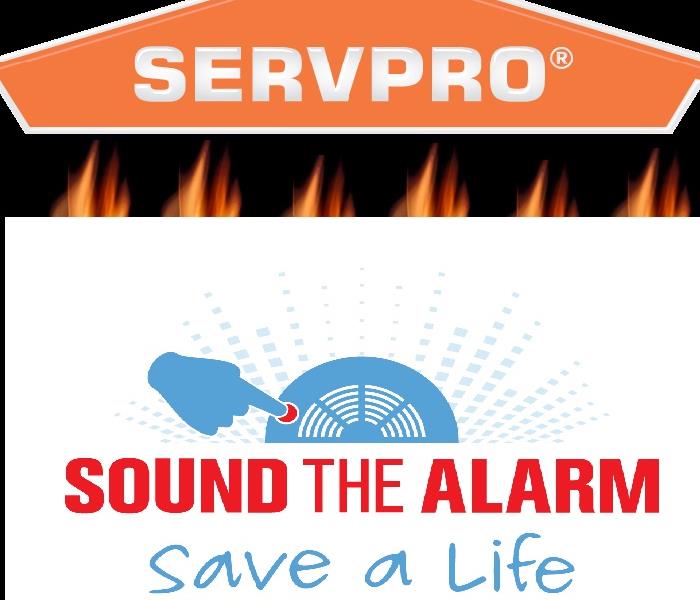 Follow the program
Follow the program
Almost 3,000 people every year die for a structure fire in the United States of America, that is 8 on average each day. That is like removing a ball team each day, everyday of the year. Not good, but with a few tips, maintenance and smoke detectors installed the number can be cut in half.
Smoke alarms should be tested once a month by pressing the TEST button. Smoke alarm batteries should be replaced in accordance with the manufacturer’s instructions, at least once a year. If an alarm “chirps” or “beeps” to indicate low batteries, they should be replaced immediately. Occasionally dust or lightly vacuum the exterior of the alarm to remove dust and cobwebs. Smoke alarms should be replaced in accordance with the manufacturer’s instructions, at least every ten years. Never paint over a smoke alarm.
What WATER can Do – Time to get on it.
12/1/2020 (Permalink)
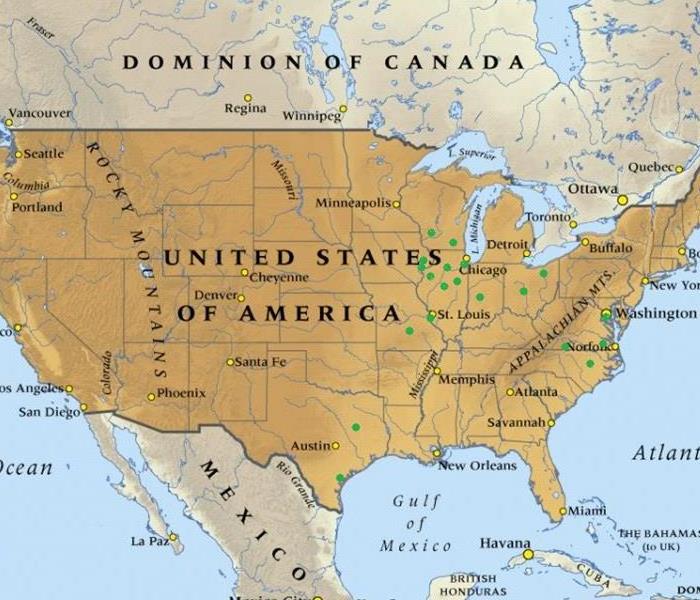 We are ready, are you?
We are ready, are you?
Within Minutes
- Water quickly spreads throughout your property, saturating everything in its path.
- Water is absorbed into walls, floors, upholstery, and belongings.
- Furniture finishes may bleed, causing permanent staining on carpets.
- Photographs, books, and other paper goods start to swell and warp.
Hours 1 - 24:
- Drywall begins to swell and break down.
- Metal surfaces begin to tarnish.
- Furniture begins to swell and crack.
- Dyes and inks from cloth and paper goods spread and stain.
- A musty odor appears.
48 Hours to 1 Week:
- Mold and mildew may grow and spread.
- Doors, windows, and studs swell and warp.
- Metal begins to rust and corrode.
- Furniture warps and shows signs of mold.
- Paint begins to blister.
- Wood flooring swells and warps.
- Serious biohazard contamination is possible.
More Than 1 Week:
- Restoration time and cost increase dramatically; replacing contaminated materials and structural rebuilding may be extensive.
- Structural safety, mold growth, and biohazard contaminants pose serious risks to occupants.
After fire cleanup
11/3/2020 (Permalink)
Smoke and soot is very invasive and can penetrate various cavities within your home, causing hidden damage and odor. Our smoke damage expertise and experience allows us to inspect and accurately assess the extent of the damage to develop a comprehensive plan of action.
Smoke and soot facts:
- Hot smoke migrates to cooler areas and upper levels of a structure.
- Smoke flows around plumbing systems, seeping through the holes used by pipes to go from floor to floor.
- The type of smoke may greatly affect the restoration process.
Different Types of Smoke
There are two different types of smoke–wet and dry. As a result, there are different types of soot residue after a fire. Before restoration begins, SERVPRO of LaGrange Park/North Riverside will test the soot to determine which type of smoke damage occurred. The cleaning procedures will then be based on the information identified during pretesting. Here is some additional information:
Wet Smoke – Plastic and Rubber
- Low heat, smoldering, pungent odor, sticky, smeary. Smoke webs are more difficult to clean.
Dry Smoke – Paper and Wood
- Fast burning, high temperatures, heat rises therefore smoke rises.
Protein Fire Residue – Produced by evaporation of material rather than from a fire
- Virtually invisible, discolors paints and varnishes, extreme pungent odor.
Our Fire Damage Restoration Services
Since each smoke and fire damage situation is a little different, each one requires a unique solution tailored for the specific conditions. We have the equipment, expertise, and experience to restore your fire and smoke damage. We will also treat your family with empathy and respect and your property with care.
Have Questions about Fire, Smoke, or Soot Damage?
Call Us Today – 630-758-1701
What you did and didn't know about tornadoes
11/3/2020 (Permalink)
The Websters Dictionary defines a tornado : "A tornado is as a rotating, funnel-shaped cloud that extends from a thunderstorm to the ground with whirling winds that can reach 300 mph. Damage paths of tornadoes can be in excess of one mile wide and 50 miles long."
According to the study done by The Weather Channel. Each year in the U.S., 1,200 tornadoes on average kill 60 people, injure 1,500, and cause roughly $400 million in damages, putting long-term average tornado losses on par with hurricanes.
There are many misconceptions in regards to tornadoes. Here are some facts from tornadofacts.net
Tornado Safety Related Myths
- Southwest corner of your home/building/shelter is the safest location - In 1887 John P. Finley wrote a book on his observations of his tornado research. While he published some ground breaking information on tornadoes he also helped created this tornadoes myth. John believed that tornadoes only traveled in a northeast direction and that derby they created would be carried in the direction of its propagation. The 1997 F5 Jarrell tornado is a prime example of his misconceptions since that tornado moved in a south-southwesterly direction. It's recommended that you always seek shelter in the lowest floor of a building, preferably under an I-beam or staircase, regardless of the type of building you're in.
- Open all the windows in your home when a tornado warning is issued - This is an extremely dangerous myth because it takes away critical minutes that could be used to reach shelter. It used to be widely believed that you needed to open your windows during a tornado to equalize pressure and prevent your house from exploding. A violent tornado will only have a 10% drop in pressure which isn't anywhere near enough to cause your home to explode. Ignore your windows and seek shelter immediately when a tornado warning is issued.
- A highway overpass is an excellent tornado shelter - This myth gained huge traction in 1991 when a TV crew survived a tornado unharmed by sheltering under a overpass in El Dorado, KS. This event had nationwide coverage with video of the event and that helped perpetuate this myth to a dangerously high status. The conclusion for scientific evidence from the Oklahoma outbreak in 1999 actual proved that overpasses are actually one of the worst places to seek shelter during a violent tornado; mostly due to the wind tunnel effect that can accelerate flying derby speed even during weak tornadoes.
- You can outrun a tornado via a vehicle - The theory behind this myth is a vehicle can travel faster than the average tornado, but the key phrase is average. There is no way for someone to know the travel and wind speed of a tornado just by looking at it. Plus the flooding, hail, and flying derby from a tornado can put someone in a vehicle in danger. The official directive from the National Weather Service is if you spot a tornado nearby to abandon your vehicle and seek shelter in a nearby building, culvert or ditch.
- A brick or stone building can protect me from a tornado - While a brick or stone building can provide better protection during tornado a violent only can easily turn a brick or stone building into a pile of rubble. It's recommended that you always seek shelter in the lowest floor of a building, preferably under an I-beam or staircase, regardless of the type of building you're in.
- If a tornado isn't coming directly towards me I'm safe - In the past it was common belief that a tornado would only travel in a northeasterly direction. While it's true that most tornadoes will move northeast this is most due to the direction the storm is traveling. Tornadoes are erratic, unpredictable, and can come from any direction. A prime example is the 1997 F5 tornadoes that struck Jarrell, TX which traveled southwest.
When a major storm hits, it may overwhelm local restoration companies. SERVPRO of La Grange Park / North Riverside can scale our resources by accessing the equipment and personnel of 1,700 Franchises. We can also access Disaster Recovery Teams that specialize in major storms and catastrophic events.
Safety tips for the upcoming holidays
11/2/2020 (Permalink)
Per the National Fire Protection Association, nearly 47,000 fires occur during the winter holidays claiming more than 500 lives, causing more than 2,200 injuries, and costing $554 million in property damage. The National Fire Protection Association also states that on average, one of every 22 home fires started by Christmas trees result in death.
The website www.redcross.org/homefires, has several good home safety tips for the holidays to keep your home safe. We at SERVPRO LaGrange Park/North Riverside wanted to share some of those tips with you to ensure a safe holiday season.
- Place Christmas trees, candles, and other holiday decorations at least three feet away from heat sources like fireplaces, portable heaters, radiators, heat vents and candles.
- Purchase flame retardant metallic or artificial trees. If you purchase a real tree, make sure that it has fresh, green needles that aren’t easily broken. Keep live trees as moist as possible by giving them plenty of water.
- Make sure that light strings and other holiday decorations are in good condition. Do not use anything with frayed electrical cords and always follow the manufacturer’s instructions.
- Always unplug tree and holiday lights before leaving home or going to bed.
- Never use lit candles to decorate a tree. Always extinguish candles before leaving the room orgoing to bed.
- Use only sturdy tree stands designed not to tip over. Keep curious pets and children away from Christmas trees.
- Keep anything that can catch on fire—pot holders, oven mitts, wooden utensils, paper or plastic bags, food packaging, and towels or curtains—away from your stove top.
- Designate one person to walk around your home to make sure that all candles and smoking materials are properly extinguished after guests leave.
The following video also shares other great ideas to keep in mind this holiday season.
Holiday Fire Safety
Have a safe and wonderful holiday season from your friends at SERVPRO Elmhurst.
Thermal Imaging
11/2/2020 (Permalink)
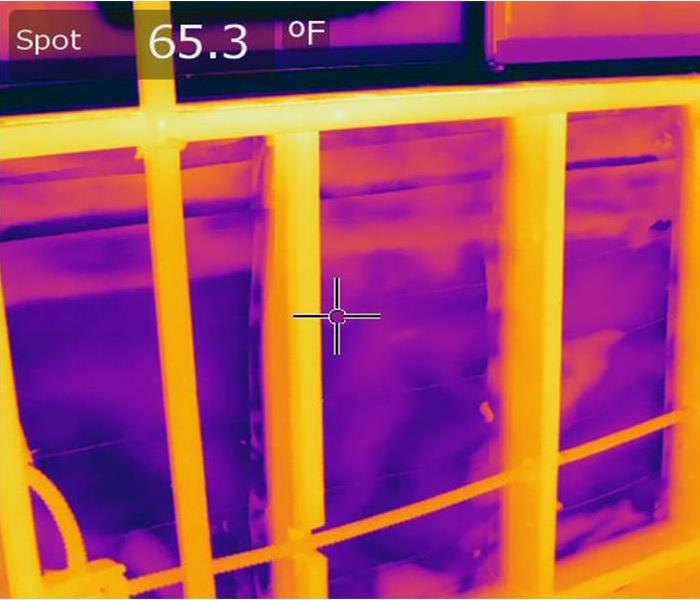 Finding the invisible
Finding the invisible
SERVPRO has many tools they offer for their customers. I recently came across a new tool that was used to detect water, and it was our thermal imaging camera our crew has. The thermal temperature screening provides a range of solutions.
Thermal cameras are important because they identify elevated body temperatures. In our case, it can show to us the level and amount of water that is in floors or walls that may not be noticeable because it is underneath. They are designed to detect and measure the invisible infrared radiation emanating from objects, frequently referred to as a "heat signature". The hotter an object is, the more radiation it releases. The thermal camera sensor array will detect infrared frequencies, converting the data to electronic signals, which can then be viewed as colored images that vary with the level of heat being emitted.
Unknown water in a home can cause major damage that can cost you a lot down the road. With that being said, having our team come in with our thermal imaging will allow our team to get to the problem faster because we are able to see something that you may not. This is why here at SERVPRO, we always go by our saying of being "faster to any size disaster" .
Call us today!
10/1/2020 (Permalink)
A basement can flood at any time, although flooding most often occurs during heavy rainfall. Basements are inherently prone to flooding because they are the lowest level of a building and are normally built partly or entirely below ground level. There are a number of reasons why your basement could flood, including:
- A blocked or failed sewer lateral pipe
- Heavy rain causes surface water to pool around your home
- Storm sewer backup
- Sanitary sewer backup
- Foundation drainage failure
- Water supply-line break or hot-water tank failure
- And many more
Have Questions about Basement Flooding?
Call Today – SERVPRO of Elmhurst
If flood water is not handled quickly and properly, it can jeopardize your health and safety, and cause severe damage to your home’s structure. Remember, the longer you wait, the worse the problem will get.
The bottom line: a flooded basement can jeopardize your health, safety, and your home’s integrity. It’s worth making a call to SERVPRO of Elmhurst and let our trained, professional crews handle the situation safely and correctly. We have earned the trust of hundreds of homeowners, business owners, and property professionals.
We are Flooded Basement Specialists:
- We are Available 24 hours/7 days per week
- We’re a Preferred Vendor to many National Insurance Companies
- We Bill The Insurance Directly – One Less Thing For You To Worry About
- Our Technicians are Highly-Trained in Water Restoration Techniques
- We use s500 IICRC Restoration Standards
- Advanced Inspection and Extraction Equipment
Basement Flooded? Call Us Today 630-758-1701 – SERVPRO of Elmhurst is Ready To Help!
FEMA!
10/1/2020 (Permalink)
Some buildings are more at risk of flooding than others in Elmhurst, IL. The Federal Emergency Management Agency, or FEMA, aims to prepare every individual to handle any natural disaster that might affect him or her, and floods are no exception. There is a wealth of flood preparation knowledge you can find from this agency, including a flood risk map that shows you exactly how likely your home is to be affected by a flood. You should take the time to learn:
1. Which flood zone your home is located in
2. What flood insurance options you have
3. Where you fall on the flood insurance rate map or FIRM
4. The elevation of your property
5.What the evacuation plan is for your area
Flood Insurance
It is a good idea to have water damage covered by your insurance policy, but you may not realize that water damage and flooding damage is not the same thing. Water damage is caused by things like burst pipes or leaky roofs, but the damage caused by external factors like tidal waves or mudslides fall into a different category. Most people do not need flooding insurance, but if you are in a high-risk area, it might be beneficial. The National Flood Insurance Program, or FEMA NFIP, is a special program FEMA offers that provides affordable flooding damage insurance.
What To Do
FEMA also has recommendations for what to do during a flood. You should be intimately familiar with the evacuation plan in your area and have all the supplies you need before a flood happens. You should have plenty of canned food, bottled water, a first aid kit, and general tools. It might be good to have a flooding damage restoration company in Elmhurst, IL already in mind so you can start the process of repairing as soon as possible. Flood water contains contamination, so it is not safe to return to your home no matter how minor the damage is.
Here to help!
10/1/2020 (Permalink)
For commercial properties, there are few events that are more of a setback than fire damage, except for maybe the water damage introduced from extinguishing the fire. The fire season is getting longer and hotter in Stone Park, IL. A fire and water restoration service can get your business back on its feet after a fire of any size; acting quickly is the key.
What To Expect From a Restoration Service
To help you navigate fire damage (and ensuing water damage) with the least heartache, a fire and water restoration business provides the following:
1. A prompt response: When you first call, professionals will ask questions to accurately pinpoint which of their specialists to send out.
2. Damage assessment: You will be visited by experts in fire and water damage assessment. They will look behind the scenes of your commercial property, from electrical and structural elements (roof, floor, walls and beams) to pipes and beyond. They will also assess visible damage to components such as fabric, paint, computers, paper goods, hardware, electronics and furniture.
3. Structural triage: The first priority is to stop further damage. This means temporarily, but immediately, using wood or tarps to patch holes in roofs, walls, windows, pipes, and doors so that your belongings aren’t further ruined by leaks, weather or thieves. The restoration experts have the know-how and the equipment.
4. Restoration: Professionals work fast and have the resources. You want assurance that all problems are fixed by professionals who know what they’re looking for. The goal is to get back to pre-fire normalcy, “Like it never even happened.” Fire is dramatic, but both fire and water damage are often cosmetic. Items that don’t have to be discarded can often be cleaned with the right equipment and techniques.
5. A final walk-through: Experts will guide you through an evaluation of your facility to lessen the chance of being in the path of a future fire.
A quick response after fire damage is key to getting your business up and running again. Further compromise to your assets can be mitigated by hiring the right people, right away.
Dry Paint Faster
9/29/2020 (Permalink)
Have you ever been at a children's event and heard someone say "it's like watching paint dry"? Well, we are going to help you to understand how to make paint dry faster! Whether you are going to repaint the home to make it more beautiful than it already is or have an upcoming event or you are just ready for a change, here are some ways to make the job move along faster. Using thin coats, boosting the flow of air, dehumidifying the space, or using air movers can all help to dry the paint faster.
1. Make sure you are using the correct paint for the job that you are doing.
2. Apply a thin coat of paint
3 Use an air mover
4. Heat the space
5. Reduce the humidity
All of these are ways to make the drying of paint move along faster than just kicking back having a cold one, watching paint dry. It might not be as fun but we know that the faster you get the painting done the more time you have to spend with loved ones!
Ways to Reduce Your Water Waste
9/29/2020 (Permalink)
Water is wasted waiting for the shower or sink to warm up, on the slow leak you have in the toilet bowl that you never knew about and from sprinkling your lawn every day. With some of the newer developments surrounding water usage throughout the world, it may be a good time to really think about how you can cut down on the water you waste. There are a whole bunch of things you can do, but let's start with some basic first steps that make a big impact.
1. Take shorter showers
- Reduce your shower time and try to avoid baths when you can. Most baths use 35-50 gallons of water, but showers can use only about 25, especially if you have a low-flow shower head. If you don't have one, consider investing in one. Especially if you're renting, a new head is a great way to revamp your whole shower routine.
2. Stop Pre-Rinsing Dishes
- Unless something is seriously burnt on, try really hard not to pre-rinse. It is an enormous waste of water, and most dishwashers are powerful enough that there's no need to. Also, try to use the dishwasher when you can. It actually uses less water per dish than hand-washing does, which means it's good for the environment and you.
3. Check for leaks in the pipes
- Don't forget to check the outdoor faucets and pipes too. Hopefully you'll notice if you've sprung a leak somewhere inside, but it can be easy to miss an outside one. Keep an eye on them, and do a check at least every six months. Also, keep an eye on your water bill. If you notice that it's gone up, then you might be leaking somewhere.
4. Only run full loads of laundry or dishes
- There are only so many items you have that get washed on the delicate cycle. However, you can still fill it up. Just add in some stuff that can take a rougher washing, but isn't too dirty. Making sure you have a full load each time means chores go faster, detergent gets used more effectively and you'll never run out of clean underwear again.
5. Check your toilet for leaks
- Add some food coloring to the tank before you go to bed. When you use it in the morning, see if any of the colored water has leaked into the bowl. If so, it's a hidden leak that should be fixed in order prevent major water damage.
6. Stop wasting water in the sink
- Just think about how long you leave the water running while you brush your teeth. Also, make sure you don't have a leaky sink. This site even has a drip calculator to help you calculate how much water is wasted from your sink. You may be surprised at how much water a single leaky faucet loses.
7. Watch how you water
- It's not necessary to have your irrigation system set to go off twice a day, every day. The grass doesn't need it that much. If you really feel you must water your lawn, just water the dry spots instead of the whole thing. You can check the hose for leaks as well.
8. Reuse water
- It's not always a feasible goal to stop wasting water entirely. However, you can cut down drastically by saving and reusing the water you can. Instead of letting it all run down the drain, capture some of it. You can save water from washing your hands or rinsing vegetables and fruits to use on your lawn or to water potted plants. On average, each person loses about 10 gallons a day to leaks. That is a completely fixable waste, and one that would help your pocketbook.
How can lint cause a dryer fire?
9/29/2020 (Permalink)
 Make sure to check your lint vent!
Make sure to check your lint vent!
Very few people realize the danger of clothes dryer fires. However, according to the U.S. Consumer Product Safety Commission, there are an estimated annual 15,500 fires, 10 deaths and 10 injuries due to clothes dryer fires. Several hundred people a year are also subjected to carbon monoxide poisoning from improper dryer vent setups. The financial costs come to nearly $100,000,000 per year. In some cases faulty appliances are to blame, but many fires can be prevented with proper dryer venting.
Lint accumulation and reduced airflow feed on each other to provide conditions ripe for a fire. Lint is a highly combustible material, which, interestingly enough, is one of the ingredients in a recipe for home-made fire starters. A number of dryer vent problems contribute to this. Most clothes dryers were in the basement. However, nowadays many newer homes tend to have dryers located away from an outside wall in bedrooms, bathrooms, kitchens and hall closets. These new locations mean dryers tend to be vented longer distances and vents are generally installed with sharp turns and bends to accommodate the structure of the home. As a result, dryer vents are harder to reach, and also create more places for lint to gather. The ideal solution is to have short, straight, dryer duct venting. However, a dryer vent booster, while not the ideal approach, can improve your dryer venting in cases where your venting is longer and/or has more bends than it should. In addition to creating a fire hazard, if the venting is too long and/or has to many bends, it will cause your dryer to take much longer than necessary to dry loads.
Commercial Cleanup!
9/29/2020 (Permalink)
If you can’t summon help quickly, a fire can quickly sweep through your Elmhurst, IL, office and leave a trail of devastation in its wake. Fire damage can be severe and make it impossible for you to resume work duties in your building. Ironically, the very water firefighters use to eliminate the fire can also cause major problems. Trained professionals have the equipment and skill to clean up both types of damage.
Thorough Inspection
When you call a professional disaster cleanup crew to your office, the team won’t jump right in and start working without a plan. The company will evaluate the effects of the fire damage in order to come up with an effective strategy. The technicians will do the following:
• Make note of which areas of your building were affected.
• Determine the extent of the damage.
• Decide what areas and items you can salvage and which ones you must replace.
• Establish a plan of attack that will yield the most complete, time-effective results.
Remove Standing Water
A fire hose can pump out hundreds of gallons of water while a firefighter is battling a blaze. It’s no wonder water can wreak havoc in your office after a fire. A technician will use wet vacuums and other specialized water removal equipment to make sure there is no leftover water on your floor or on furniture or other objects. Next, the team will dry the areas with dehumidifiers and high-powered blowers.
Clean and Sanitize
Sucking up water and drying the area isn’t enough to mitigate water damage. The professionals will also use chemicals to thoroughly sanitize any areas where there had been water. This will minimize the chances of mold growth.
Fire damage and water issues go hand in hand after a fire. By understanding the process the pros use, you can have peace of mind and confidence that your office will be in good hands.
Storm Team- Iowa
9/1/2020 (Permalink)
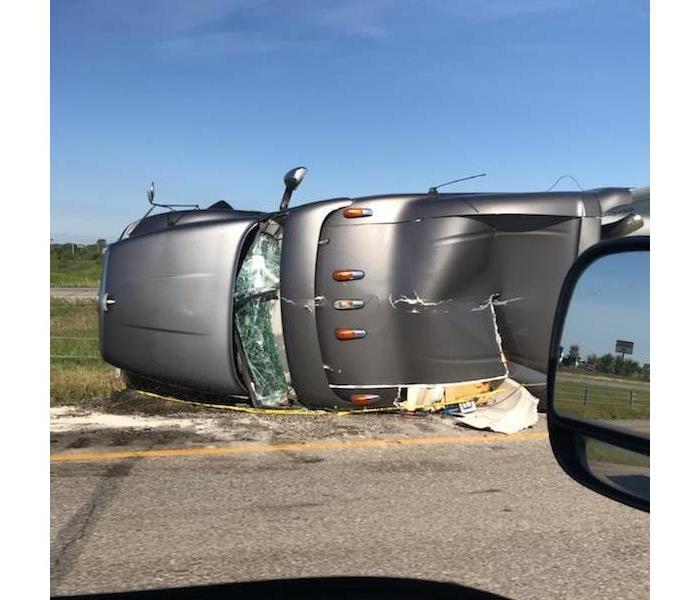 Our team out helping the damages that struck Iowa!
Our team out helping the damages that struck Iowa!
Over the past couple weeks, our storm team here at LaGrange Park/N. Riverside has been out assisting those who were hit with damage from the bad storm that went through Iowa. Our team has been working on a major project at one of the local hotels nearby. Our commercial large loss division is composed of the best of the best in restoration. Our commercial operations manager has been supervising the job every since we started down in Iowa. Our team was about to dispatch trained production professionals, and cut costs through the strategic placement and oversight of temporary labor. Once our team got word there was going to be a major storming rolling through there, we had a team ready to go the day before. After the storm hit, out team drove over 3 hours to get out to the location where the commercial property was. On the way, our team was able to see all the damage first hand driving through Iowa. Our team described it almost as a "scary scene in a movie". There was semi-trucks turned over on the highway, full grown trees pulled out of the ground, entire roofs taken off of homes, broken homes, and many more disasters that put tears to their eyes. Our team knew that they needed to help fix Iowa, and be able to make it strong again. To this very day, our team is still out in Iowa assisting the major commercial loss that has taken place, and they will continue to work in order to get the operation up and going again. We here at SERVPRO are always faster to any size disasters!
Costs from water damage
9/1/2020 (Permalink)
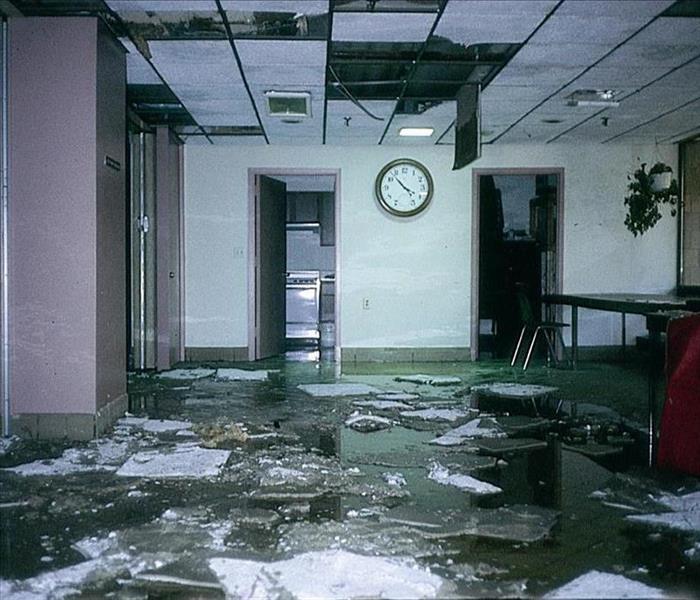 Call our SERVPRO team today!
Call our SERVPRO team today!
When it comes to owning a business or a home, water damage can be one of the most costly things there is. You can not only lose out on days or weeks of productivity, but you could also find yourself repairing or replacing valuable equipment like electronics, tools and inventory. This is where the costs come into play.
- On average, water damage from a sink will run $7,000.00 for each instance
- For toilets, that number ranges between $2,000.00 and $10,000.00
As we can see, this can add up very fast! Here are some causes of water damages, and what you can do to help prevent them.
1. Appliances and Equipment
- Air conditioners, water heaters or anything that uses tubes, pipes, gaskets or filters to operate has the potential to leak. The best thing to do is to regularly look over and maintain your equipment. If you notice anything that concerns you, such as rust, cracks, bulges or signs of moisture, call SERVPRO.
2. Roofing
- Make sure you're checking your roof regularly. If you've got a pond up there, your drainage isn't working effectively. Keep in mind that every inch of water weighs in at around 5 lbs. Be sure to look for any damage to your perimeter like flashing, roof membrane or roof penetrations like drains, pipes and gas lines.
3. Pipes and Drains
- Your plumbing system is susceptible to stoppages, clogs and damage. If a crack develops, it could dump 250 gallons of water per day on your facility. Look for outward signs of moisture, blue stains, rusting, and cracking and bulging. If you're having plumbing work done or you have a cut pipe for any reason, check for scale buildup. You can also try a pipe camera to get a good look at what's going on inside your system.
4. Sprinkler Systems
- Many commercial buildings are outfitted with sprinkler systems, which are great for minimizing fire damage, but not so great for water damage when they malfunction. Always check your sprinkler system for signs of damage or rust, and replace them regularly to make sure they are functioning properly.
5. Mother Nature
- Natural disasters like hurricanes, severe thunderstorms and flash flooding can do untold damage to your business. You can control how ready you are for it though. Keeping your gutters clear, installing barriers and storing sensitive files and electronics at a higher level are all things you can do to keep the damage minimal. Consult with a SERVPRO professional to get your ERP set up and ready in case something like this were to happen.
Common Causes of Commercial Building Fires
9/1/2020 (Permalink)
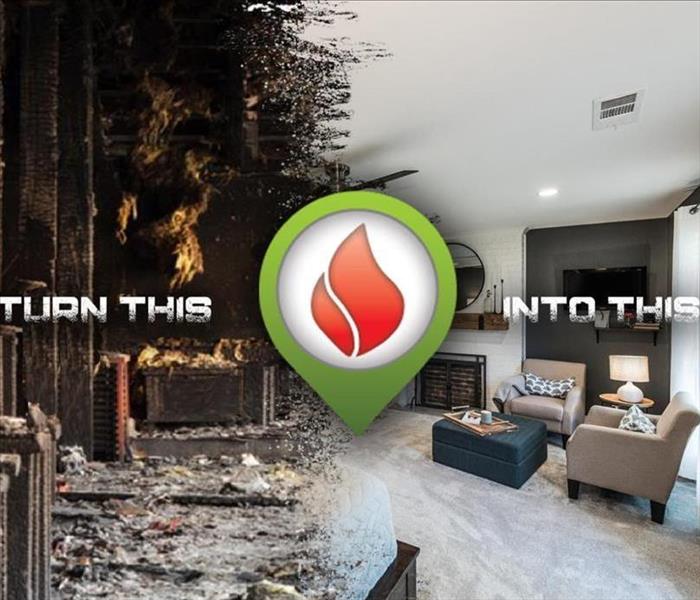 Make sure to check all heating sources!
Make sure to check all heating sources!
We usually don't think of a fire destroying our business or office building. We are more worried about less concrete threats. This includes a downward trending economy, high customer churn rate, the struggle to retain talented employees, legal issues, etc. However, nonresidential building fires killed 65 people, injured 1,425 and created $2,461,400,00 in damage between 2004 and 2013.
In order to prevent a dangerous and costly fire, the time of day fires are most likely to occur in your building depends on what type of business you're in. An office building is a bit different from a manufacturing plant. Ex: In an office building, fires are most common during regular work hours. Incidence of fires peaks in the early evening hours between 3-6pm.
Therefore, the most common causes of commercial building fires are as follows.
1. Cooking Fires
- 29.3% of nonresidential fires from 2013 were cooking related. In fact, 1 in 4 office building fires were related to cooking equipment. These types of fires do tend to account for less damage, but they are easily preventable with fire protection systems such as alarms and fire extinguishers.
2. Intentional
- This accounts for almost 10% of fires, and tends to cause the most damage. Intentional fires also result in more civilian injuries and deaths. Unlike cooking and heating fire, it's most common for intentional fires to be started between 3pm and midnight. A few common locations to be aware of in the building are bathrooms, trash bins, garages, and open areas like a lawn or field.
3. Careless Acts and Human Error
- 9.2% of commercial fires were unintentional results of careless acts. This is somewhat of an 'other' category. Some examples include accidentally leaving space heaters or other heat producing equipment on, carelessly discarded cigarette butts igniting fires, and plugging too many things into the same extension cord.
4. Heating Fires
- Heating fires account for 9% of all nonresidential building fires. Central heating units, fireplaces, water heaters, and other heating appliances and systems should be regularly inspected to prevent fires. It is important to move any flammable materials and furniture away from heat sources.
Preparing your home for a major storm
9/1/2020 (Permalink)
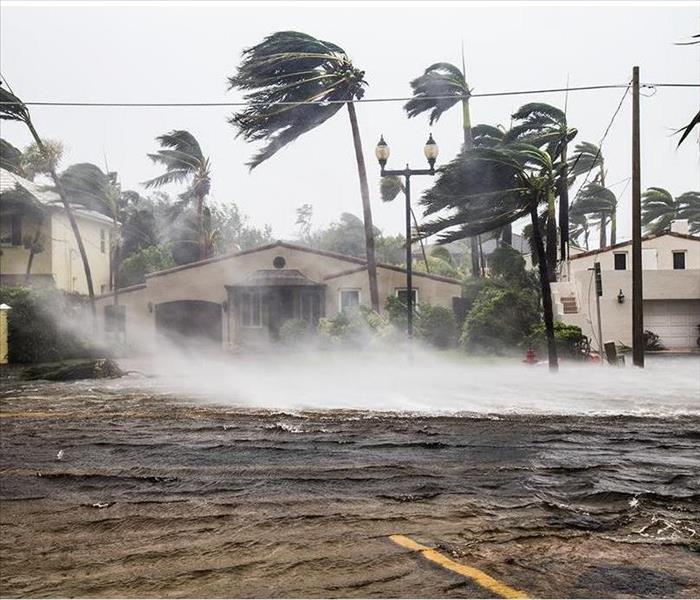 Make sure you have a plan!
Make sure you have a plan!
Being a homeowner, you do not know what mother nature is going to throw at you. Therefore, you always need to be ready. You can take preventative measures to help reduce damage if and when a severe storm hits.
1. Clear limbs and trim trees
- During a storm, dead tree limbs can get loose and cause damage to a home's exterior or even puncture a window. Heavy rain can also cause trees with shallow root systems to pull out of the ground.
2. Secure fences
- Ensure that your fences are properly secured to help prevent them from being lifted up and thrown against the house by heavy winds.
3. Secure furniture
- Heavy winds can cause items like patio furniture and large toys to damage the exterior of your home. It's a good idea to anchor outdoor furniture or bring it indoors before a storm hits. You should also move anything in your yard that can become flying debris inside your house or garage.
4. Check gutters
- Help prevent damage inside your house by having downspouts drain away from your home and clear your gutters of any debris.
5. Protect the critical areas
- Wind is a major threat to your roof, windows, doors and garage doors. Either you or a building contractor can build and install temporary protection, such as approved wind shutters or plywood on windows and coverings for patio and entry doors, strengthen and stiffen garage doors, and install heavy duty door hardware.
6. Protect your valuables
- Protect mementos in waterproof containers and/or take the items with you if you evacuate. Inventory valuables and contents in the home with pictures or video. Note the approximate value of each item and the date of purchase. You can also send an inventory to a family member outside your region for safekeeping. Also, make sure important documents, such as an insurance policy or mortgage papers, are stored in a safe deposit or fire safe box.
7. Stock a basic emergency kit
- A true emergency can leave you without basic services, including electricity, water, gas or sewage, for a few hours or a few days. Stock your family's emergency kit with enough food, water and supplies to carry all of you through at least three days. Also make sure to restock your kit once the emergency has passed.
8. Create a family emergency plan
- Staying connected is of the utmost importance during an emergency. Designate an out-of-town family member or friend to be your check-in person in case local phone lines are down. Make sure every member of your family knows that contact's number and has a way to reach him or her. Ideally a cell phone and charger or a prepaid calling card. Also, choose a local place where your family members should meet if they are separated when an emergency strikes and your home is unsafe. This might be a landmark or even a parent's workplace.
Certified: SERVPRO Cleaned Program
7/23/2020 (Permalink)
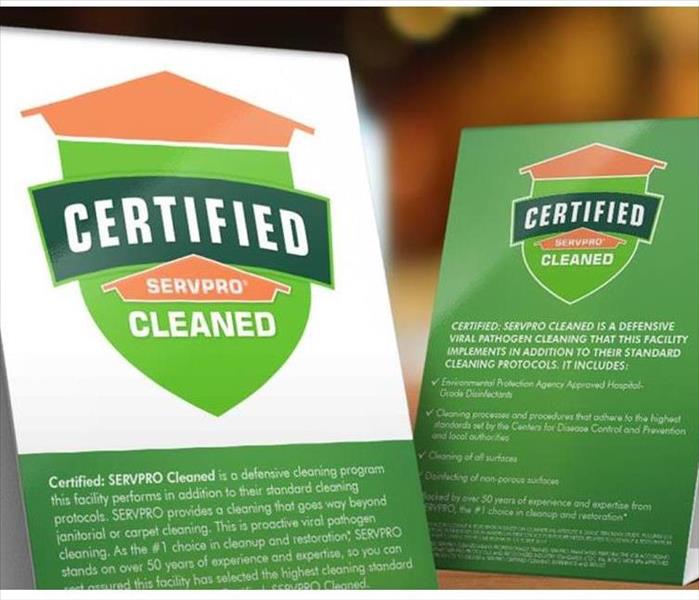 Get set up today!
Get set up today!
We as a company have recently introduced our new program Certified: SERVPRO Cleaned, and it is designed to provide our communities with a way to know that a structure has been cleaned, sanitized, and disinfected. This is also a cleaning and disinfecting program that we here at SERVPRO have to offer for our commercial property owners in order to address the current COVID-19 pandemic. We ensure that when businesses choose SERVPRO, their customers, employees, and community are rest assured that they have selected a higher standard of cleaning.
This program is set up with 3 unique steps called the 3 C's. These 3 C's include Consult, Clean, and Certify.
Consult deals with the process of talking to each businesses personally because not all businesses are the same. A SERVPRO professional who understands the business will create a custom cleaning program to meet their specific needs. The specific program will be developed based on a range of factors including business type, size of space, amount of high frequency touch points, foot traffic, and congestion points. Therefore, they will know that the clean they receive is customized to their unique needs.
Clean is based on the specific needs of their business, and their location will undergo a thorough expert cleaning rooted in the pillars of People, Process, and Product.
-People: SERVPRO professionals are uniquely prepared during this unprecedented time to clean and disinfect homes or businesses according to the protocols set by the CDC. We have years of experience in dealing with biological contaminants, and we will go beyond the scope of work that needs to be done.
-Process: SERVPRO professionals are trained to perform proactive or emergency responsive cleanups that involves facility or structure cleaning and disinfection. This would include cleaning of porous and non-porous surfaces, disinfecting of non-porous surfaces, cleaning and disinfecting of equipment, tools and supplies used for cleanup, and disposal of hazardous materials. We also recommend a frequent cleaning depending on what CAT it is in. We want to make sure that people are getting back to business as soon as possible if there is a known COVID-19 case involved.
-Product: Our program has more than 100 exclusive professional cleaning products to meet any need. This includes our proprietary cleaning agent, SERVPROXIDE, which is a hospital-grade disinfectant that carries the Environmental Protection Agency's lowest toxicity category and is NSF certified for sanitizing surfaces in and around food processing surfaces.
Certify deals with the our credibility as the premier biohazard cleaning company in the country to their business. This then allows assurance to their employees and customers that only SERVPRO can deliver. Once the business has been cleaned, they will gain access to propriety signage, digital emblems, and other collateral that communicates that they've selected the highest standard of cleaning available to protect their employees and customers. We also have the option to add the date, so then their guests will know that their location is being cleaned regularly.
SERVPRO professionals have been on the front lines of proactive and reactive COVID related cleanups, and we are here to help as businesses begin to reopen and to also help them stay open!
Here to help!
6/3/2020 (Permalink)
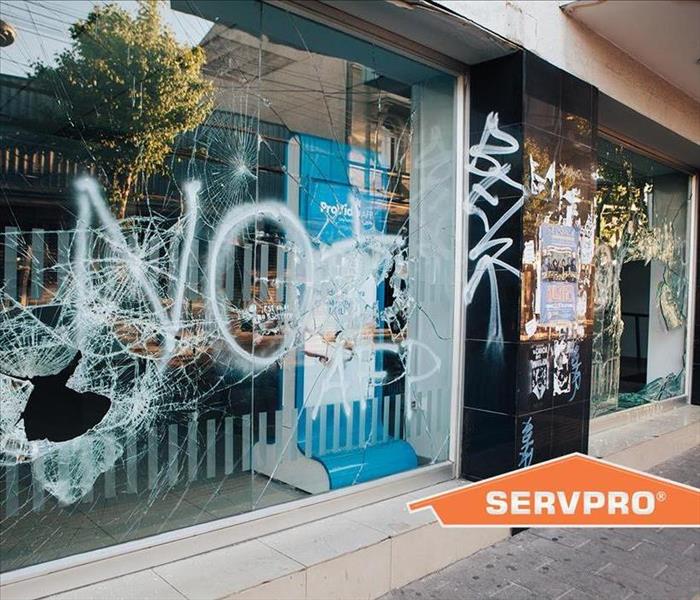 Damage on building.
Damage on building.
We here at SERVPRO want you to know that we are here to help during this time. Our immediate board up services will help your business by not taking anymore damage to it. Not only that, but it will also give you a peace of mind that your business is safe for the time being. This also leads into the next step of the reconstruction process to your business. We can help you get your business looking back to the way it should be. The final step that needs to be taken is our cleaning and sanitizing services to your business. We do not know who has been in and out of the building due to the looting, and COVID-19 is still present in our world today. We understand that your business is important to you, and you have been dealing with major obstacles recently. However, let SERVPRO give you that peace of mind, and help you get your business back up and running like it used to. We are all in this together!
Internship at SERVPRO
5/7/2020 (Permalink)
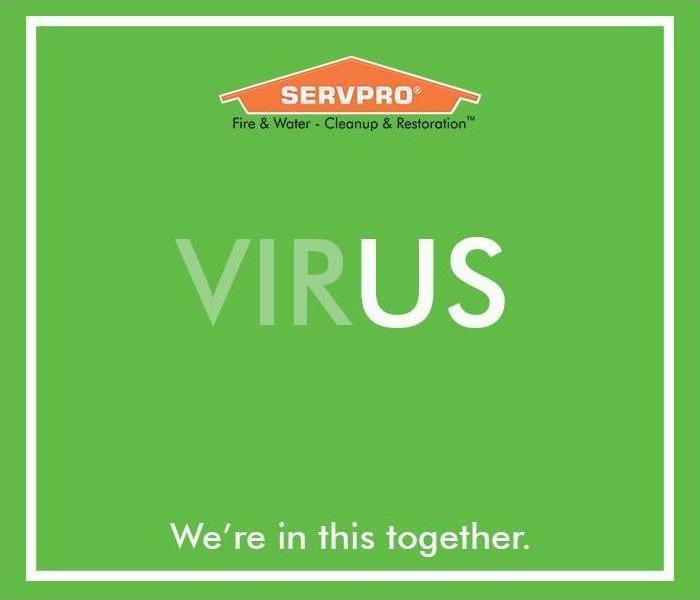 We are all in this together!
We are all in this together!
The company that I am interning for is SERVPRO of Elmhurst/Arlington Heights & N. Prospect/Lagrange Park & N. Riverside. The office location is located in Broadview IL, and the areas that are listed are the territories that our marketing team is allowed to market in. SERVPRO is a franchise that is owned and operated by personal owners. We have over 1,700 locations across the United States. Our company focuses on fire, water and mold restoration and mitigation for disasters that strike homes, buildings, businesses, etc. We are also currently doing cleaning and disinfecting for COVID-19 with our Vanquish product and fogging system. As far as what I do as an intern at SERVPRO, I work alongside the marketing and sales team. Our job is to go on daily routes around our territories and market SERVPRO to insurance agents, restaurants, hotels, churches, retail stores, etc. You name it, SERVPRO can help! However, one major struggle we are having during this time is not being able to go out on our daily routes to market and sell because of the current pandemic we are in. Therefore, all the team members are in the office and are brainstorming ideas on how to market SERVPRO from behind a computer screen. Some ideas we have come up with is marketing through social media. This is mainly my job because the other members don’t care for it, and I actually really like it. I have access to all the social media accounts like Instagram, Facebook, LinkedIn, Twitter, etc. Every day I come in and do daily posts on all the accounts in order to ensure we are getting the SERVPRO name out on the Internet more. Especially now since everyone is at home with the stay-at-home order in place, they are constantly on their smart devices. I also have been doing blog entries on the SERVPRONet website about my internship here at SERVPRO. SERVPRONet is a personal website for SERVPRO employees to access that has updated news for everyone, marketing tools, sales techniques, and so on. I also have been attending weekly WebEx meetings with the SERVPRO marketing headquarters with all different SERVPRO franchises across the country. They show us helpful tools to use while being stuck at home or in the office. Another major event that our company has been doing is free cleaning and disinfecting for our first responders. Our team members have been going out and doing cleaning and disinfecting to the vehicles and offices of police and fire departments in our territories. This has given our company major recognition on social media websites, and we are even building relationships that we didn’t have before. I love what I do here at SERVPRO and I have learned so many different techniques about marketing and sales that I never knew before. This has given me so much more confidence when approaching new people, and building up my relationship skills. I have developed a different side of professionalism that I didn’t know I had before, and it is truly amazing to see the growth I have gained because of SERVPRO. The employees I work with treat everyone like family, and it is very welcoming when you walk in the door every day. I always have a smile on my face when I enter in the morning, and then when I leave in the afternoon. I love coming to work every day, and that is exactly how it should be. Thank you SERVPRO for letting be on this internship journey with your company!
Cleaning & Disinfecting for COVID-19
4/1/2020 (Permalink)
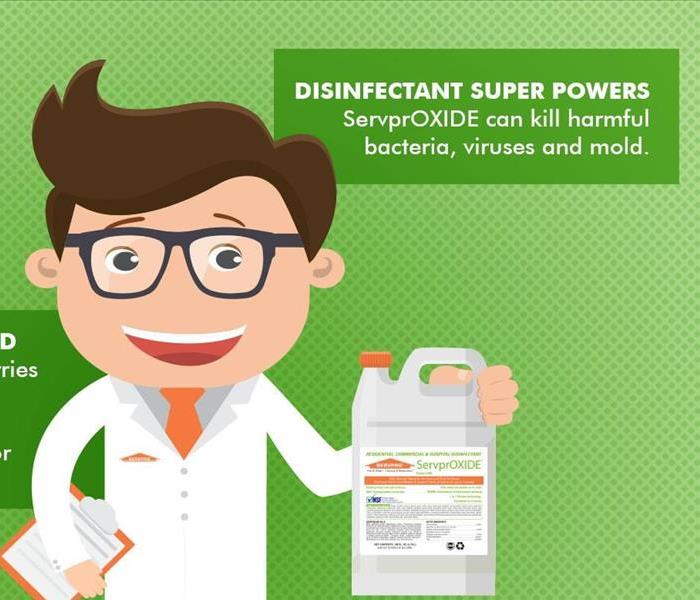 The product that is used for the cleaning and disinfecting. We want to help do our part by stopping the spread of the virus!
The product that is used for the cleaning and disinfecting. We want to help do our part by stopping the spread of the virus!
Hello,
We have been out servicing 911 call centers, trucks, distribution warehouses and distribution offices that are keeping our stores stocked with supplies and know that our Police and Fire Departments also need to be out to protect our communities but also need to stay free from a spread of the SARS-CoV-2” COVID-19 .
We here at SERVPRO wanted to let you all know that we are currently are open to help combat the spread of the virus. SERVPRO, with direction from the CDC have put together protocol to deal with “SARS-CoV-2” COVID-19 pro-actively (pre-positive test) and reactively (post-positive test).
These general guidelines are broad in scope and are not-specific protocols. Any protocols from federal, state, local agencies, or an industrial hygienist would supersede these guidelines. A CAT system has been designed for the different calls as it relates to “SARS-CoV-2” COVID-19.
CAT1: Proactive cleaning only CAT2: Person under investigation (PUI) or possible exposure CAT3: Confirmed, positive case
The protocol for CAT 1 is attached along with the SDS sheets, Chemical information, approval forms and rates for the services. We know that it is ever changing at a rapid rate and is very volatile. If you are in need of any services please reach out to us and we will do our best to help answer any questions or perform any work.
CAT 2 and CAT 3 – Protocol:
The Centers for Disease Control and Prevention (CDC) is closely monitoring an outbreak of respiratory illness caused by a novel (new) coronavirus (named “SARS-CoV-2”) that was first detected in Wuhan City, Hubei Province, China, and spread to dozens of countries throughout the world. This is an emerging, rapidly evolving situation and the CDC will provide updated information as it becomes available, in-addition to updated guidance.
https://www.cdc.gov/coronavirus/2019-ncov/community/organizations/cleaning-disinfection.html
Cleaning and Disinfection After Persons Suspected/Confirmed to Have COVID-19 Have Been in the Facility
Timing and location of cleaning and disinfection of surfaces
- At a school, daycare center, office, or other facility that does not house people overnight:
- It is recommended to close off areas used by the ill persons and wait as long as practical before beginning cleaning and disinfection to minimize potential for exposure to respiratory droplets. Open outside doors and windows to increase air circulation in the area. If possible, wait up to 24 hours before beginning cleaning and disinfection.
- Cleaning staff should clean and disinfect all areas (e.g., offices, bathrooms, and common areas) used by the ill persons, focusing especially on frequently touched surfaces.
- At a facility that does house people overnight:
- Follow Interim Guidance for US Institutions of Higher Education on working with state and local health officials to isolate ill persons and provide temporary housing as needed.
- It is recommended to close off areas used by the ill persons and wait as long as practical before beginning cleaning and disinfection to minimize potential for exposure to respiratory droplets. Open outside doors and windows to increase air circulation in the area. If possible, wait up to 24 hours before beginning cleaning and disinfection.
- In areas where ill persons are being housed in isolation, follow Interim Guidance for Environmental Cleaning and Disinfection for U.S. Households with Suspected or Confirmed Coronavirus Disease 2019. This includes focusing on cleaning and disinfecting common areas where staff/others providing services may come into contact with ill persons, but reducing cleaning and disinfection of bedrooms/bathrooms used by ill persons to as needed.
- In areas where ill persons have visited or used, continue routine cleaning and disinfection as in this guidance.
How to Clean and Disinfect
Surfaces
- If surfaces are dirty, they should be cleaned using a detergent or soap and water prior to disinfection.
- For disinfection, diluted household bleach solutions, alcohol solutions with at least 70% alcohol, and most common EPA-registered household disinfectants should be effective.
- Diluted household bleach solutions can be used if appropriate for the surface. Follow manufacturer’s instructions for application and proper ventilation. Check to ensure the product is not past its expiration date. Never mix household bleach with ammonia or any other cleanser. Unexpired household bleach will be effective against coronaviruses when properly diluted.
- Prepare a bleach solution by mixing:
- 5 tablespoons (1/3rd cup) bleach per gallon of water or
- 4 teaspoons bleach per quart of water
- Products with EPA-approved emerging viral pathogens claims are expected to be effective against COVID-19 based on data for harder to kill viruses. Follow the manufacturer’s instructions for all cleaning and disinfection products (e.g., concentration, application method and contact time, etc.).
- For soft (porous) surfaces such as carpeted floor, rugs, and drapes, remove visible contamination if present and clean with appropriate cleaners indicated for use on these surfaces. After cleaning:
- If the items can be laundered, launder items in accordance with the manufacturer’s instructions using the warmest appropriate water setting for the items and then dry items completely.
- Otherwise, use products with the EPA-approved emerging viral pathogens claims (examples at this link) that are suitable for porous surfaces
Thank you for your time and stay safe.
We are still open!
4/1/2020 (Permalink)
 Even during this pandemic, SERVPRO is open and here to help with any of your needs.
Even during this pandemic, SERVPRO is open and here to help with any of your needs.
SERVPRO of Elmhurst provides 24-hour emergency service and is dedicated to being faster to any-sized disaster in Elmhurst. We can respond immediately to your emergency and have the expertise to handle your restoration or cleaning needs.
- 24-Hour Emergency Service
- Faster to Any-Sized Disaster
- Highly Trained Restoration Technicians
- A Trusted Leader in the Restoration Industry
- Locally Owned and Operated
- Advanced Restoration and Cleaning Equipment
Have Questions? Call SERVPRO of Elmhurst 630-758-1701
Residential Services
Whether your Elmhurst home needs emergency flood damage or your upholstery cleaned, you can depend on us. Our technicians have extensive cleaning and restoration training and can make your property look its best. Learn more about our residential services:
- Water Damage Restoration
- Fire Damage Restoration
- Mold Remediation
- Storm Damage Restoration
- Cleaning Services
- Building/Reconstruction Services
Commercial Services
There's never a convenient time for fire or Water damage to strike your Elmhurst commercial property. Every hour spent cleaning up is an hour of lost revenue and productivity. When the need arises for professional cleaning or emergency restoration services we have the training and expertise to respond promptly with highly trained technicians to get your property back to business.
4 Important Steps for Fire Restoration
2/25/2020 (Permalink)
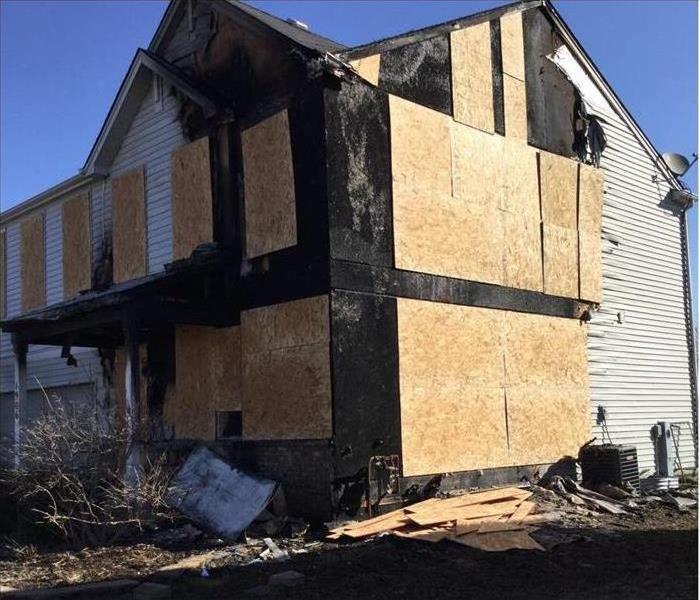 Board up services in a Berkeley, IL home
Board up services in a Berkeley, IL home
4 Important Steps for Fire Restoration
Home fires start for a number of reasons: an open flame that gets knocked over, an electrical malfunction, a forgotten stove burner or an escaped cinder from a fireplace. If you experience a home fire in Berkeley, IL, at some point the fire restoration process will begin. When you work with a professional fire remediation team you get a number of benefits such as a faster recovery process and reduced expenses. Here are some important things to keep foremost in mind.
1. Choose a Local Company. A fast response is important, and a local company can be on the scene in a matter of hours. Faster to Any Size Disaster means such things as smoke damage will be addressed quickly. An inspection and damage assessment will let you know the extent of the damage to your home.
2. Determine if Board-up and Tarp Services Are Needed. If the fire is a major one, your home will need to be secured from vandals and inclement weather. Cracked windows, broken doors and an open roof will need to covered up to prevent additional losses to property.
3. Remove Smoke and Soot Damage. Professional fire restoration technicians have the training and equipment to eradicate smoke odors and soot buildup in your home. Fire and water damage specialists will restore what items they can and replace what is necessary.
4. Continue With Cleaning and Repair. A thorough cleaning with the most effective cleaning agents continues the process. Certified damage cleaning techniques ensure your home is restored to its original condition. This will be done with as little disruption to your daily activities as possible.
The fire restoration process is designed to make your home livable again as quickly as possible. The goal is to make your home look "Like it Never Even Happened." A home fire is a challenging event to bounce back from, but it is achievable with help from experienced professionals.
Tips for Preventing a Leaking Toilet
2/11/2020 (Permalink)
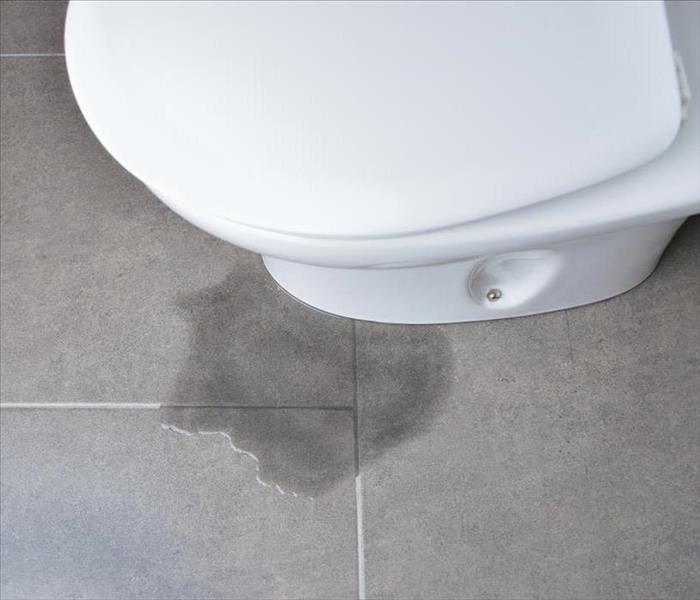 Leaking toilet in a Hillside, IL
Leaking toilet in a Hillside, IL
Of all the problems a homeowner might face, a leaking toilet is probably one of the least pleasant. Fortunately, there are a few simple steps that you can take to keep toilet trouble at bay and keep your bathroom running smoothly. Here are some helpful guidelines for properly maintaining your toilet in your Hillside, IL, home.
Watch What You Flush
One of the easiest ways to prevent a bathroom leak is to make sure that you’re only flushing human waste and toilet paper. Always avoid placing the following objects into your toilet bowl:
- Tissues
- Feminine hygiene products
- Dental floss
- Diapers
- Baby wipes
- Cotton swabs
Not only can these objects cause serious damage to your pipes, but some of them may also harm the environment. Additionally, it's a good idea to avoid flushing excessive amounts of hair down the toilet drain, as this can lead to a flooding or leaking toilet.
Clean Your Toilet Often
This might just seem like a basic hygiene tip, but it actually makes a big difference in terms of preventing clogs or leaks. When you clean your toilet, you have the opportunity to identify any problems that you may not have noticed otherwise. Be sure to clean your toilet thoroughly on a regular basis to diagnose potential plumbing issues, such as a bathroom leak.
Address Issues Promptly
In addition to regularly checking for problems, it’s vital to fix them as soon as possible. Toilet leaks in particular tend to cause water damage gradually, which means you might not notice that there’s a problem at first. Be sure to clean up your toilet often and call a plumber right away if anything seems wrong.
If you have a leaking toilet in your Hillside, IL, home, don’t ignore the issue. Keep your living space safe from all types of harm by calling for a water damage repair immediately.
How To Protect Your Wood Flooring
1/31/2020 (Permalink)
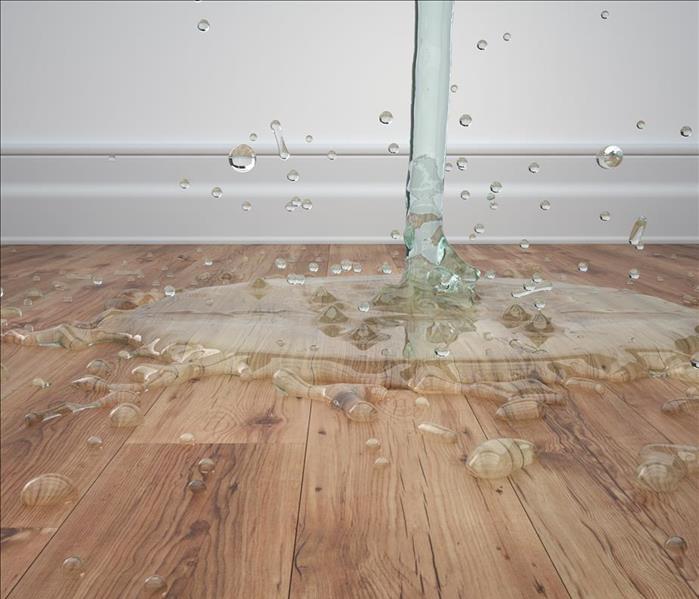 Water falling on wooden floor
Water falling on wooden floor
How To Protect Your Wood Flooring
Wood flooring makes your office building in Franklin Park, IL, look beautiful. It enhances the look of your lobby, making a great first impression when people walk through the door. When water from a pipe burst seeps into the floor, however, it can discolor it and cause it to swell. A quick response is vital to protecting your investment and keeping your floors gorgeous.
Make the Call
The first thing you should do when you have a large water loss seeping into your wood floor is call water restoration specialists. Making this call your first priority has several benefits:
- Starts remediation process faster
- Shows insurance company that you acted quickly
- Reduces chance of further damage
Once you make the call, you can expect technicians to arrive within hours to assess the damage to your building. Then they can make a plan for taking care of it.
Extract Standing Water
The sooner you can remove the standing water from the pipe burst, the less damage you will have in the end. If you have the equipment to pump water out of your building, you don't have to wait for the professionals to arrive. As long as you wear the appropriate protective gear, you can get the cleanup process started yourself.
Absorb Excess
Even a small amount of water can damage your wood floors. If water has seeped into the wet floor, it may already be causing the wood to swell and warp. To stop this process in its tracks, spread newspaper or kitty litter over the affected area. It will draw the water out of the wood and potentially save your flooring.
A pipe burst wreaks havoc on everything around it, but it can be especially damaging to a wood floor. By acting quickly, you can halt the damage and get the help you need to repair the problems you couldn't avoid.
The Co$t of Continuing Education
1/29/2020 (Permalink)
 So, if you think a no-cost class fits your pocketbook reach out to find out when our next class offering is. 708-240-4873.
So, if you think a no-cost class fits your pocketbook reach out to find out when our next class offering is. 708-240-4873.
When you are looking to further your education you have to take into account the cost of the education. Not only from the financial cost aspect but also time and life cost. We spend about:
- 2,100 days of our life in a car just going to and from work,
- 150 days: spent complaining,
- 115 days: spent laughing,
- 125 days: are used shaving,
- 140 days: spent being on hold,
- 1,950 days: we spend doing housework,
- 6,255 days: we use by being online,
- 27.4 days: spent cuddling and being romantic,
- 4,015 days: spent sitting in front of the television,
- 1,583.4 days: we spend eating,
- 12,389.6 days: spent at work,
- 136 days: women spend getting ready,
- 1,460 days: are spent being on the phone at work,
- 366 days: are spent being sick,
- 180 days: how long we end up waiting in line,
- 967.2 days: spent washing clothes,
- 9,490 days: spent sleeping,
- 160 days: spent smoking cigarettes on break,
- 2,555 days: how long we lie awake at night,
- 27.2 days: spent waiting for trains,
- 46 days: men spend getting ready
- 90.4 days: spent sunbathing.
Think about that for a moment because we are on the earth for about 10,658,000 days if we live to 80. It is so crazy! So, now you need to spend time furthering your education. "Is the squeeze worth the juice?" as I have heard it said before. We all want to take a class that is going to give us what we need, a class that is going to help us to produce, is fast and inexpensive.
Well, I have a great educational outlet for you. One where you will actually learn something takes 2 - 4 hours based on the class and you are fed a mid-morning snack and lunch. Sounds better than sitting in front of a computer after work!!?? So say hello to your new teacher. I am approved to teach 8 continuing education classes that as given to you at no-cost and will really open your eyes to what happens in the industry by hands-on learning and classroom time. So, if you think a no-cost class fits your pocketbook reach out to find out when our next class offering is. 708-240-4873.
The Power of a Good Claims Inventory System
1/22/2020 (Permalink)
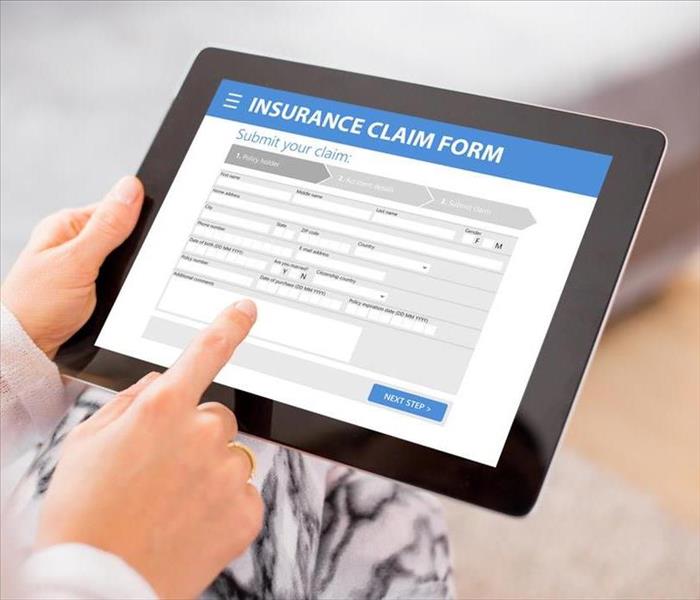 The power of good claims inventory system
The power of good claims inventory system
When a disaster strikes in Bensenville, IL, there are numerous aspects to the recovery process. The first part of the course is completing the restoration work in a safe and timely manner. At some point, though, the attention will turn to the insurance claim. Experienced insurance agents and adjusters know there is a right way and wrong way to complete the process. Good records must be kept throughout the cleanup. An itemized list of damaged contents should be put on worksheets where it is easy to read. There should be no missing information. All of this allows for a speedy claims process, allowing the insurance agent to better service his or her clients.
The SERVPRO Advantage
Even before a claim is started, a SERVPRO franchise has considered the relationship between a disaster mitigation team and the insurance industry. The goal is always to maximize the satisfaction of insurance companies and other parties. Guidelines exist to accomplish this, including:
- Background checks on all franchises and temporary workers
- Internal audits to monitor quality assurance
Open lines of communication between a franchise and the insurance company
- A requirement for completed job files for proof of work
With these standards in mind, an insurance claim should be a smooth process that provides clarity and verification of work and losses. Additionally, IICRC standards are followed to ensure the quality of the restoration.
The Claims Process Benefit
An orderly claims process involves good record keeping from the moment workers step on the property. This includes an inspection and damage assessment that results in an estimate of loss. Soon an itemized list of losses and damages is provided on Excel worksheets, as well as photo documentation of pertinent images. All paperwork is scanned and copied and is available in an electronic file or through hard copy. All of this work is designed to make the insurance claim easier for the agent and the business owner.
How To Avoid Mold in Your Restaurant
1/8/2020 (Permalink)
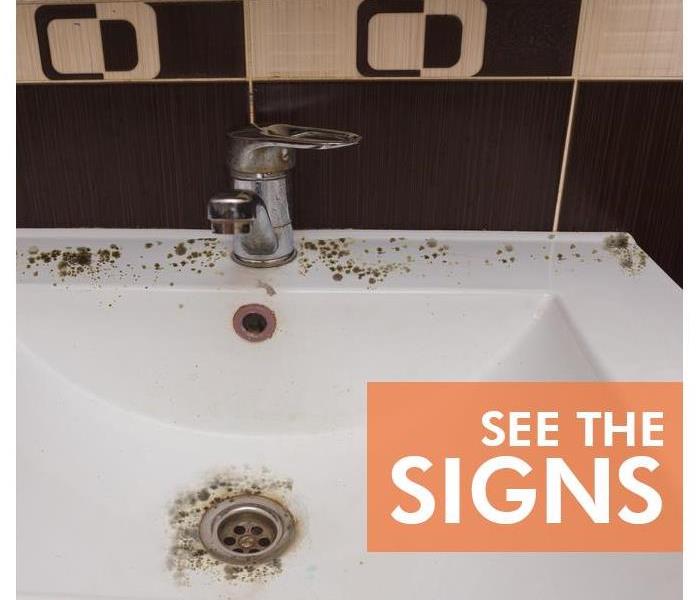 Visible signs of mold growth and moldy, musty odors are a sign of moisture or water damage.
Visible signs of mold growth and moldy, musty odors are a sign of moisture or water damage.
How To Avoid Mold in Your Restaurant
If you own and operate a restaurant, there are certain things you never want to hear. You don't want to hear a customer complain about the food, you don't want to hear about poor service, and you certainly don't want to find out there is mold growth. Few things could turn people away from your establishment faster than the sight of this fungus. Unfortunately, restaurants are a prime place for mold to invade and spread. If you are vigilant, you can prevent it from entering your place.
Places To Check
Mold loves places where there is high humidity, so start looking near sinks and in crawl spaces, cellars and closest for signs of growth. You may even spot mold in some of the following areas of your building:
- Bathrooms, including employee showers and locker rooms
- Behind and under refrigerators and other appliances
- Near the HVAC system
How it Grows
Water is one of the biggest culprits of mold development. Fungi and water go hand in hand, so be aware of any water damage you may have suffered in your Elmhurst, IL, restaurant. Leaky pipes can attract mold, as can overflowing sinks. Make sure you clean up water promptly and make any necessary repairs. A professional water damage restoration team can also help. These crews will not only remove water but will kill any bacteria left behind with powerful sanitizing agents.
Stop the Spread
If you ever detect mold growth in your facility, make sure you check your ventilation system. Proper airflow can reduce humidity, especially while you are doing dishes and preparing food. Properly refrigerate all items and dispose of materials before the expiration date. Conduct a thorough walk-through of the restaurant at the end and beginning of each workday.
Take the time and make the effort to stop mold growth. Your business can thrive as mold stops dead in its tracks.
How To Prepare Your Business for a Possible Fire
12/31/2019 (Permalink)
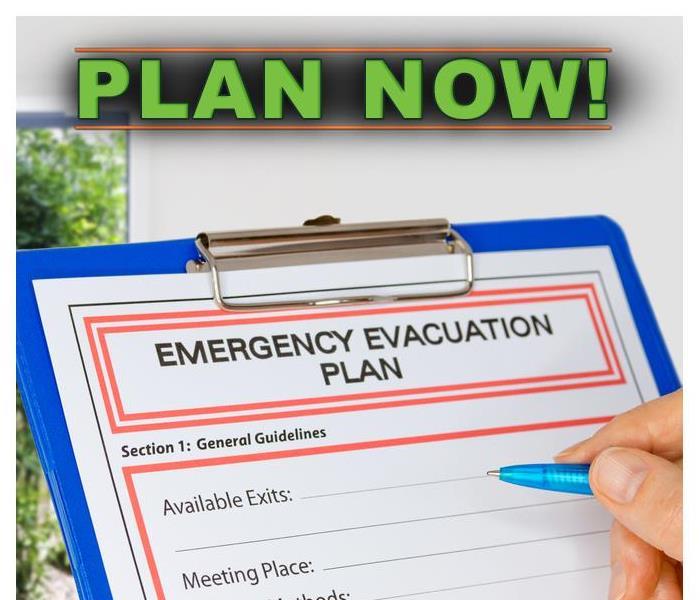 The best time to plan your evacuation route is now.
The best time to plan your evacuation route is now.
While you and your staff can prevent fires in the workplace, it can be helpful to prepare in case of one. By taking the right precautions against a potential business fire, you can keep the employees and yourself safe, as well as mitigate potential damage. Prepare your commercial location by taking the following actions.
Create a Fire Safety Plan
The most effective way to ensure the safety of the company is by creating a structured plan for everyone to follow. The plan is essential for fire preparation and should cover multiple areas.
- Fire prevention
- Equipment identification and use
- Evacuation
- Emergency response
Create guidelines that employees can read and follow clearly and easily. At the same time, they must be thorough and cover every situation, hazard and complication relevant to the fire. Also, hold training sessions with the staff so everyone has experience with the plan and knows what to do in case of emergency. It will reduce errors and prevent evacuation delays.
Clear All Obstructions
When planning an evacuation route for a business fire in Melrose Park, IL, you may notice that some of the most dangerous hazards are obstructions. The most common obstructions prevent your employees from using emergency exits or seeing extinguishers and other firefighting equipment in time. Encourage your staff to regularly observe these areas or objects and clear out anything blocking them. This can even extend outside of the building, such as cars blocking fire lanes.
Disable All Ignition Sources
Prevention is important as part of a fire preparation plan, so make sure the staff can spot and prevent fire ignition sources, including improperly stored chemicals, exposed electrical wiring and other flammable elements. Even if a fire already starts, it is important to account for these dangers, since their exposure to fire can lead to greater fire damage and increase the need for a commercial building restoration service.
Anticipating a business fire can save lives and reduce damage to your valued establishment. Create a plan for fire emergencies and have resources ready for your employees to use.
How To Temporarily Repair A Wind-Damaged Roof
12/23/2019 (Permalink)
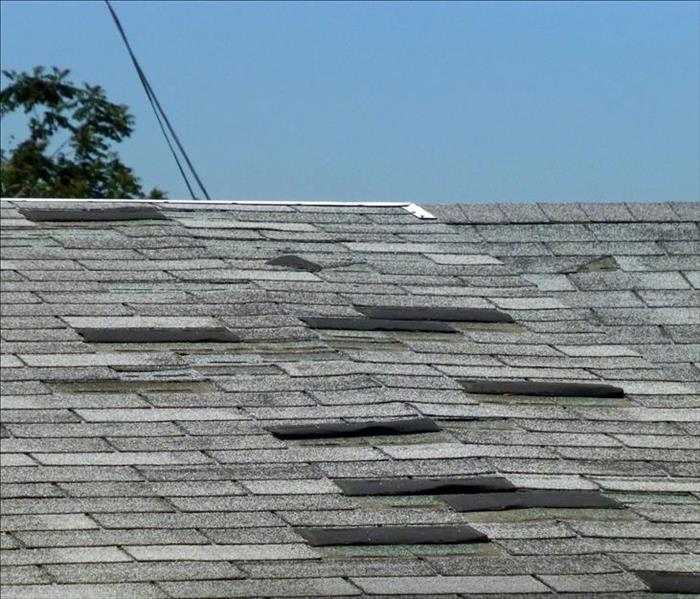 Missing shingles on roof
Missing shingles on roof
Three Steps To Prevent Roof Damage
A roof leak or other wind damage to the roof of your Schiller Park, IL, business can be a major headache. Fortunately, there are steps you can take to prevent further damage.
Signs of Wind Damage
It is important to address roof damage as quickly as possible. The following are some common signs of a damaged roof:
- Curling, lifted or missing shingles
- Damaged or absent chimney flashing
- Leaking roof
- Buildup of shingle granules in gutters
Few roofs are completely flat. Most have a variety of geometric features that affect where damage occurs. Wind damage is most likely to occur along the edges of the roof, at the corners and along the ridge line. Be sure to check those areas closely after heavy winds.
Temporary Roof Repair
Although you will need to permanently repair the roof, you may have to do a quick fix to prevent further damage or stop a roof leak. The following are three common temporary roof-repair methods:
- Tarp over or board up the damaged area
- Readhere curling or lifted shingles
- Make temporary shingles from sheet metal
Using tarpaulin or plywood to cover the affected area of your roof is generally inexpensive and fairly easy. If you just have a few damaged shingles, though, you may be able to readhere them with roofing cement. You will need a heat gun to soften the shingles and make them more malleable. You will also need roofing nails to secure the shingle. If you have missing shingles, you can make replacements fairly easily using sheet metal. Simply cut the sheet metal into the same shape as your regular shingles and install them as you would any other shingle.
Addressing roof damage as soon as possible can prevent further damage to both the roof and the interior of your business. However, if you do have water damage or mold growth from a roof leak, a certified restoration company can help you get your business back to normal quickly and safely.
Residential Water_20_Why Toilets Leak
12/6/2019 (Permalink)
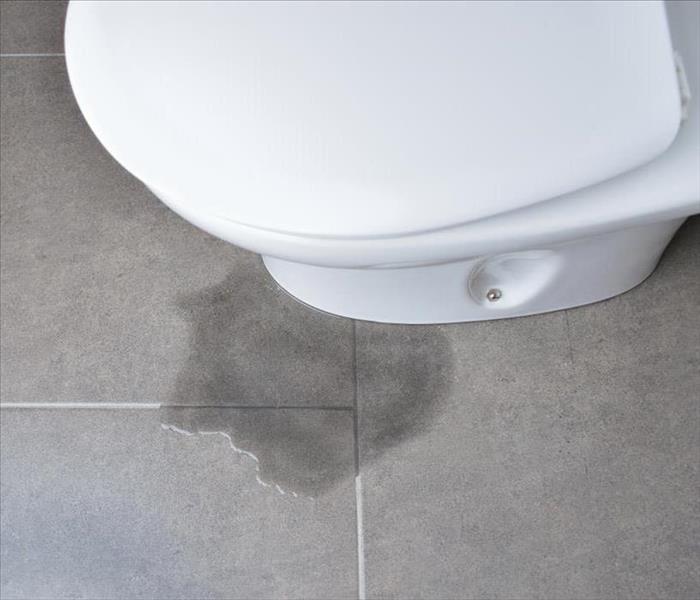 Leaking toilet in Stone Park, IL
Leaking toilet in Stone Park, IL
Residential Water_20_Why Toilets Leak
While the kitchen always seems to be the gathering place in the home, the bathroom gets a lot of foot traffic. When guests arrive, the last thing you want is for your home in Stone Park, IL, to have a leaking toilet. Besides the mess it leaves, if it goes unchecked, mold and rot can quickly make it smell like a dingy rest-stop.
Signs of Leak
When faced with a bathroom leak, it's not always a visible mess. Internal issues can make your water bill surge. Signs that you may have a problem include:
- The handle must be jiggled to get it to stop running.
- The toilet makes sounds even when not being used.
- To empty the tank, the handle needs to be held down.
- Water continues to trickle into the bowl after the flushing cycle.
The Main Culprits
Once you have determined you have a leaking toilet, it is important to take care of the problem as soon as possible. In addition to wasting water, the leak could eventually spread and damage nearby areas of the home. Below are some of the main causes of a leaking toilet.
Cracked Tank or Bowl – Although built for longevity, like most things, toilets aren’t immune to damage and aging. A barely noticeable crack will eventually lead to bigger problems.
Old Pipes – In older homes, the pipes leading to your bathroom can begin to rust and crack.
Worn or Loose Seals and Connectors – The internal workings of a toilet feature gaskets and everyday hardware. If those get worn or loosened, a leak can develop. The seal at the base of the toilet can also face the same problem.
Flush Valve and Flapper Issues – An improperly adjusted or broken valve can affect the overflow, leading to a tank constantly filling instead of draining properly. If the flapper isn’t doing its job to stop water, it will continue to fill the bowl.
Addressing a leaking toilet right away is the best way to avoid water damage. If the damage has already happened, count on a water damage specialist to get your home guest-ready.
Attack Mold Problems With Help From a Hygienist
11/27/2019 (Permalink)
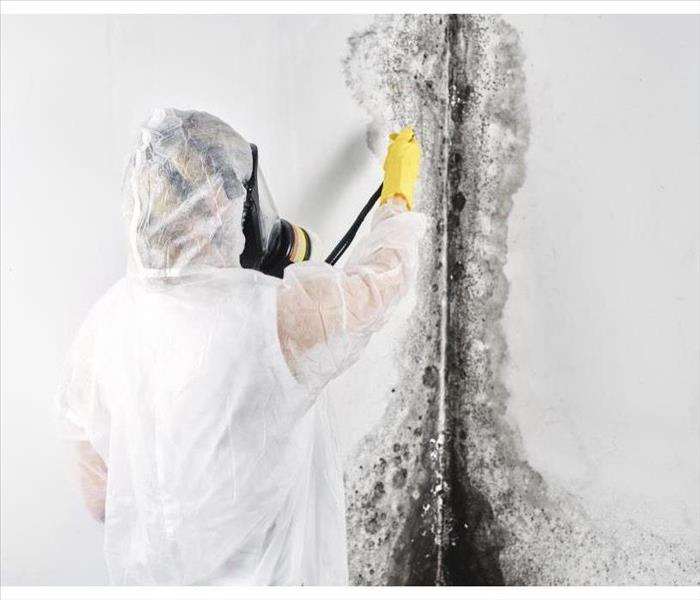 Turn testing and remediation over to mold damage professionals for reliable results.
Turn testing and remediation over to mold damage professionals for reliable results.
Attack Mold Problems With Help From a Hygienist
When you discover a mold problem in your Northlake, IL, home, you need to know whether it's worth paying for professional testing and professional mold cleaning services. After all, you could get a DIY mold kit at your local home improvement store. However, there are a few drawbacks to this route:
- Mold kits are notoriously inaccurate, often providing false negatives or positives. This means some homeowners don't treat existing mold problems while others pay for expensive treatments without cause.
- Mold exists everywhere; it is part of nature. If you get a positive reading, it could be testing positive when you don't really have a problem.
- While a test may provide correct results, it doesn't indicate how widespread or invasive the problem is.
- The Environmental Protection Agency recommends professional testing for air quality, mold, and property analysis.
Although you could try a store-bought test, you'll get better results when you work with a qualified hygienist.
What Do Hygienists Do?
Environmental hygienists are responsible for safety in homes and workplaces. They are trained to recognize the health consequences of various substances, especially if those affect the ventilation system. These hygienists have the training and tools to conduct the testing necessary to understand mold damage and can steer homeowners toward appropriate mold remediation. It's important to note that hygienists have access to laboratory facilities for completing their testing, thus delivering reliable, accurate results.
DIY Versus Professional Hygienists
A decision to try air sampling with a DIY kit can be an expensive mistake. Without the appropriate sensitivity to provide accurate, full results, those kits can be seriously misleading. A hygienist, on the other hand, understands what's at stake, is familiar with the risks associated with mold, and the ins and outs of dealing with black mold cleanup.
If you believe you have a problem in your home, don't put off mold cleaning. Don't leave your home and family at risk by attempting to DIY mold remediation. Instead, turn testing and remediation over to mold damage professionals for reliable results.
Understanding Fire Restoration
11/22/2019 (Permalink)
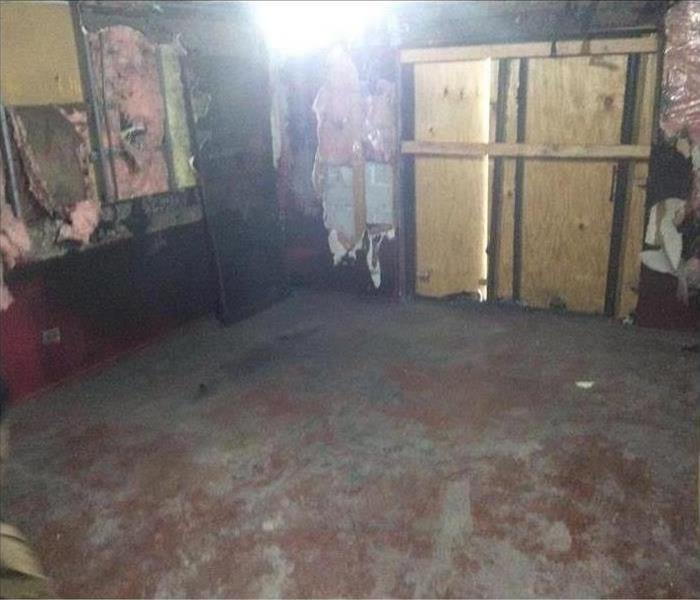 Fire restoration in a Berkeley, IL home
Fire restoration in a Berkeley, IL home
Understanding Fire Restoration
After a fire in your home, you have likely become familiar with the number of fire restoration companies and services in your area. However, you might be wondering what they do. The process of restoring your home is an involved one that likely requires five steps.
- Water removal
- Debris removal
- Smoke and soot cleaning
- Cleaning and sanitizing
- Restoration and rebuilding
Water Removal
Before any remediation or restoration service can begin damage cleaning, they must remove the excess buildup of water. While it might sound unusual when discussing fire damage, you must consider the efforts of emergency services in putting out the blaze. Fire hoses and suppression systems can leave an abundance of water, which can result in significant water damage if not dealt with immediately.
Debris Removal
After removing the water, a remediation team will begin the process of discarding the more significant elements of debris, such as furniture. You can accompany these teams into the property to sort through your belongings, as well.
Smoke and Soot Cleaning
Smoke damage is a challenging thing to alleviate. It is resilient and spreads through porous items and ventilation systems. Therefore, a restoration company will spend a significant amount of time cleaning any residue and odor from your home.
Cleaning and Sanitizing
A large portion of fire restoration services involves cleaning and sanitizing the property, even after the smoke and soot residue are gone. Therefore, before any rebuilding takes place, a company will spend a great deal of time with commercial cleaners and specialized HEPA-filtered vacuums.
Restoration and Rebuilding
Once the cleaning is completed by a fire restoration and remediation company in Berkeley, IL, they will begin the restoration and rebuilding phase. This is when the damaged property begins to look like your home again.
Fire restoration is a challenging and possibly a lengthy process, depending on the damage. However, when it is all said and done, you will have a home to return.
Choosing the Appropriate Fire Extinguisher
11/18/2019 (Permalink)
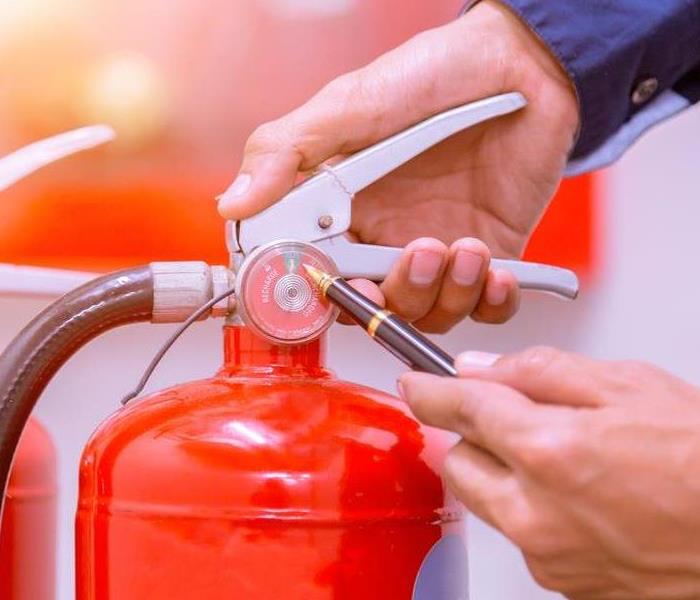 You need the very best help on the line as well.
You need the very best help on the line as well.
Choosing the Appropriate Fire Extinguisher
- Class A: This is the most common extinguisher and can be used to put out fires in ordinary combustibles such as cloth, wood, rubber, paper, and many plastics.
- Class B: Used on fires involving flammable liquids, such as grease, gasoline, and oil.
- Class C: Designed for fires involving appliances, tools, or other equipment electronically energized or plugged in.
- Class D: For use on flammable metals; often specific for the type of metal in question. These are typically found in factories.
- Class K: Intended for use on fires that involve vegetable oils, animal oils, or fats in cooking appliances. Generally found in commercial kitchens.
When fire or water damage puts the things that matter most on the line, you need the very best help on the line as well. That’s why knowing the easiest ways to contact SERVPRO is so important.
Just go to https://www.SERVPROelmhurst.com/to get the team that’s faster to any size disaster. We’re a leader in giving control back to homeowners, property managers, and even entire communities after the ravaging effects of water or fire. So, whether you’re responsible for 1,000 square feet or 100,000 –be ready for the worst with the very best: Your trusted, SERVPRO of Elmhurst team.
Common Causes of Sewer Backups and How To Avoid Them
11/12/2019 (Permalink)
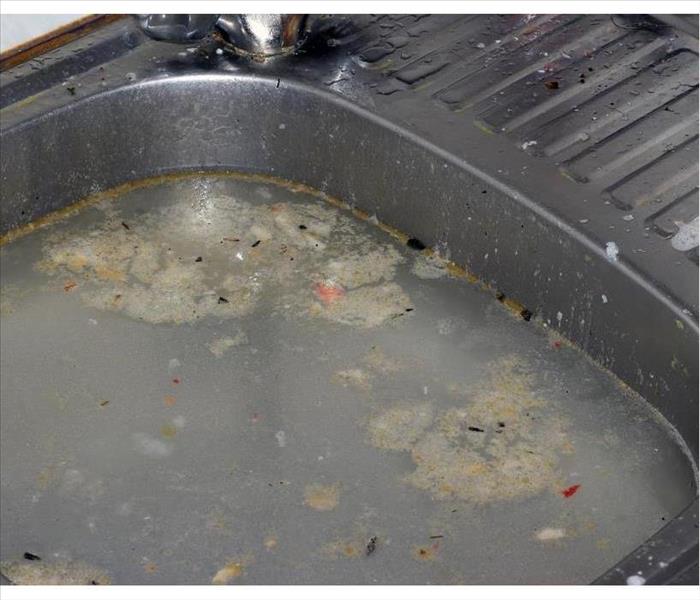 Clogged sink in a Hillside, IL home
Clogged sink in a Hillside, IL home
The 3 most Frequently Observed Sewage Problems
Nobody wants to come home to discover that there has been a sewer backup in his or her living space. Unfortunately, this can easily become a reality for many homeowners. Read on to understand the three most frequently observed sewage problems and what you can do to prevent them from taking place in your Hillside, IL, home.
Clogged Drains
More severe clogs usually take place in the main sewer line, while less serious ones tend to affect your drain. To determine whether there’s a clog in one of your drains, look for blockages in the following fixtures:
To stop these fixtures from becoming clogged, be sure to maintain them on a regular basis and use them appropriately. Pouring grease down your kitchen sink drain or overloading your garbage disposal can increase the risk of a sewer backup. Similarly, avoid flushing sanitary napkins and other bulky items down the toilet to keep all drains clear.
Collapsed Sewer Lines
In some cases, broken or collapsed sewer lines can lead to a sewer blockage. This typically takes place in older homes where the sewer lines are made of clay piping or cast iron, which are materials that tend to break down more quickly. If your sewer line has broken down or collapsed, you may want to consider replacing it with one made of plastic or a similarly reliable material to keep further problems from occurring.
Invasive Tree Roots
If your sewer backup isn’t a result of the above causes, you may want to inspect the tree roots on your property. Trees that are located directly above your sewer line can either crush the sewer line completely or extend into your pipes to form holes and clogs. Be sure to control the growth of your tree roots to keep sewer problems at bay.
Whether you have a bathtub backup or flooding, sewage problems can be serious. Call water damage experts immediately to take care of any kind of emergency.
Take Steps To Prevent Weather Related Flooding in Your Building
10/26/2019 (Permalink)
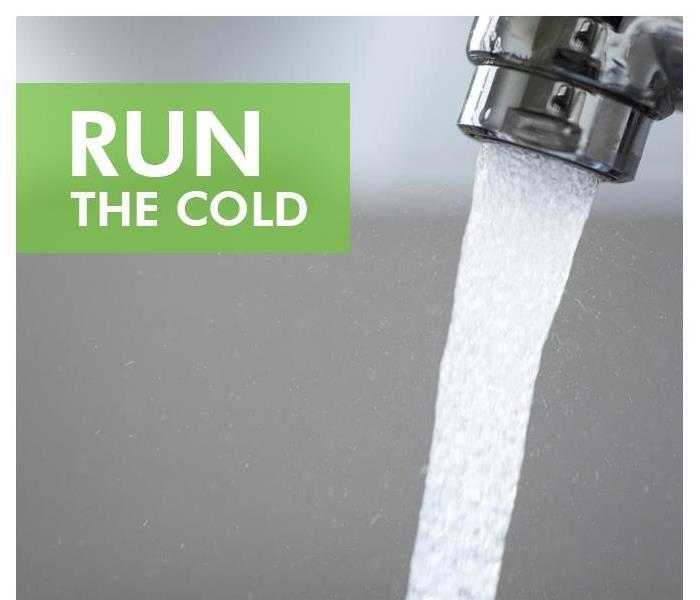 Keep faucets running at a trickle to keep water moving and prevent freezing
Keep faucets running at a trickle to keep water moving and prevent freezing
Take Steps To Prevent Weather Related Flooding in Your Building
When you run a business in Franklin Park, IL, you have a lot of line items to be concerned with. Flood damage does not need to be one of them. Severe storms can cause street level flooding or may cause water to back up in sewer drains. Heavy rain or hail can take a toll on your roof and allow leaks that work their way inside. Extreme cold may cause a burst pipe that could flood anywhere in the building.
An Ounce of Prevention
Storm damage can happen when a frozen pipe develops. Take a few steps to check your building’s risk or and even prevent weather related freezing. A little preparation may spare you from serious storm cleanup.
Check insulation levels in areas where plumbing is installed, both in the walls and in the roof/ceilings. If more is needed for your climate than is present, have more installed and consider insulated pipe sleeves for extra protection
Keep the area surrounding any plumbed areas warm enough to prevent freezing, or use heat tape in areas beneath the floors or in the ceiling
Keep faucets running at a trickle to keep water moving and prevent freezing
If needed, relocate problematic pipes from outer walls to prevent freezing
Close garage and bay doors when they are not being used to keep heat in
Thawing a Frozen Pipe
If you suspect a pipe is frozen, it is very important that you don’t turn the water on too quickly. If it doesn’t run easily, keep the faucet partially open and warm the area where the pipe is located until water flows freely. Allow water to run for a bit to melt ice and open lines.
When a burst pipe leaves you with standing water, be sure to call a professional water remediation service in Franklin Park, IL to help with proper flood cleanup and drying out. With some good prevention and skilled help, you can get back to business as usual.
SERVPRO of Elmhurst provides CE Ethics class
10/20/2019 (Permalink)
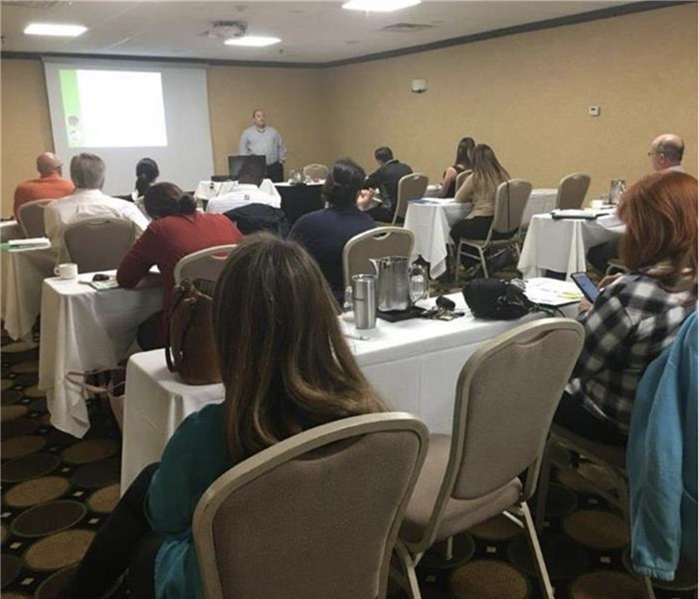 Our goal is to make it like it never happened.
Our goal is to make it like it never happened.
Every year, SERVPRO of Elmhurst provides continuing education in the areas of water, fire and mold mitigation. Education increases the opportunity for the community of professionals responsible for helping you when disaster strikes: The more you informed the community of first responders, the better able to help limit damage, save important personal belongings and control costs during a time of crisis.
At SERVPRO of Elmhurst, we work with adjusters, insurance agents, real estate agents, brokers, home inspectors, and office professionals by providing state-sanctioned Ethics Classes. Raising the bar when it comes to how people are treated especially in the time of need to protect their homes and personal belongings is essential to the insurance claim process.
Our goal is to make it like it never happened. As a recent client said, "the whole clean up and insurance process was as painless as it could have been."
How To Flush a Water Heater
10/18/2019 (Permalink)
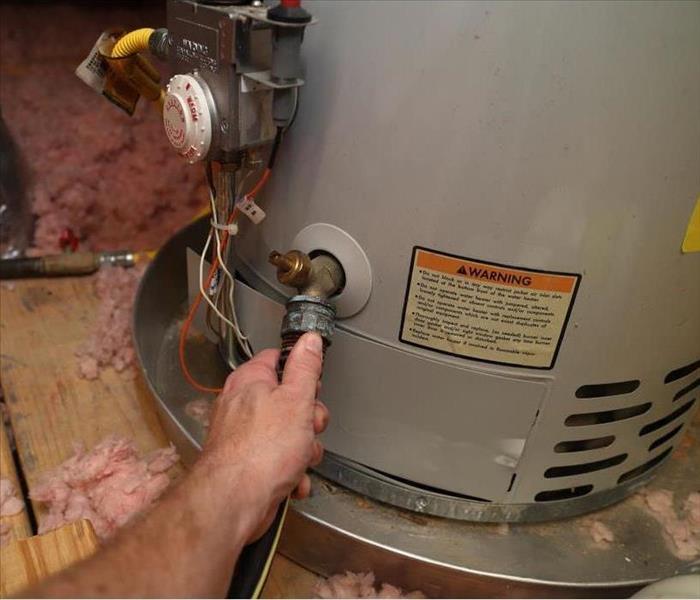 Unless you live in an apartment building, you almost certainly have a water heater in your Bensenville, IL, home
Unless you live in an apartment building, you almost certainly have a water heater in your Bensenville, IL, home
Unless you live in an apartment building, you almost certainly have a water heater in your Bensenville, IL, home. As part of routine home maintenance, you should flush the sediment from the tank once a year.
How To Do a Water Heater Flush
Fortunately, flushing the unit is a relatively straightforward task. The following steps will guide you through the process:
Put on work gloves to protect yourself from hot water. Locate a garden hose that will reach from the drainage spigot of the tank to an area outdoors that can withstand the hot water and sediment you will be draining.
Turn off the power to the unit. Additionally, you will want to turn off the thermostat and close the water supply valve.
Turn on the hot water in a sink and leave it running to prevent a vacuum from forming.
Connect the water hose to the drainage spigot on the tank. Then turn on the spigot and allow the water to drain until it runs clear or the tank is empty.
Turn the water supply valve back on to flush out any remaining sediment from the tank. Allow the water to drain until you do not see any sediment in the water coming from the hose.
Turn off the spigot, and disconnect the hose. Make sure the water in the faucet is running freely (indicating no excess air in the pipes).Then turn off the water that has been running in the sink. When the tank is completely full, turn the power back on to the heater and the thermostat up.
In about twenty minutes, check to make sure that you have hot water coming to the faucets in your house.
Hopefully, keeping your water heater maintained will help prevent plumbing problems. However, if you do experience residential flooding, a professional restoration company can help restore your home to its pre-flood condition.
4 Important Differences Between Mold and Mildew
10/9/2019 (Permalink)
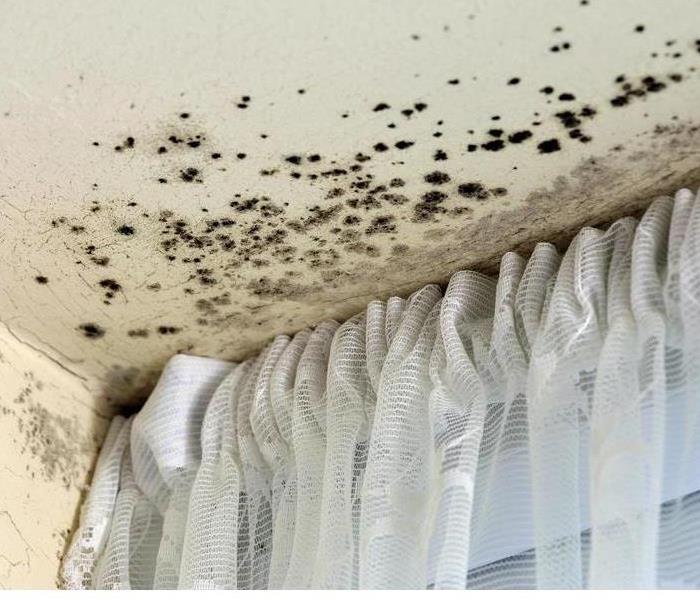 Knowing whether you have mildew or mold growing in your home is important for knowing how to tackle the problem.
Knowing whether you have mildew or mold growing in your home is important for knowing how to tackle the problem.
While often used interchangeably, mold and mildew are actually not the same thing. Understanding the differences between these two types of fungus are important for knowing how to effectively deal with mold damage in your home in Elmhurst, IL. Here are four essential differences between mold and mildew.
1. Appearance
When it first starts to grow, mildew will look white or gray on whatever surface it is growing on. Over time, mildew may start to turn yellow, brown or black. Mildew normally grows in flat patches and is fluffy or powdery in appearance. Mold, on the other hand, is often much darker than mildew and can be white, yellow, varying shades of green, blue, or black. It usually has an irregular growth pattern and looks either very fuzzy or slimy.
2. Location
While mold and mildew can be found on many of the same surfaces, mildew growth is most commonly found on plants and flat surfaces in your home. Mold can penetrate objects and make its way into drywall or floorboards, but mildew can only live on the surface. Both are attracted to moisture, which makes bathrooms and kitchens common breeding grounds.
3. Damage
If found in your home, mildew is more of an annoyance than a serious issue. Mildew is the most harmful to plants and crops. Mold damage, on the other hand, will become worse with time and can cause severe rotting to your home.
4. Treatment
You can easily clean mildew at home using a store-bought cleaner or natural mold killer and a cleaning brush. However, removing mold is much harder. For severe mold growth, you will need to get assistance from a mold remediation specialist.
Knowing whether you have mildew or mold growing in your home is important for knowing how to tackle the problem. Visit https://www.SERVPROelmhurst.com/ for more information on mold and mildew.
Basic Information About Renters Insurance and Fires
10/9/2019 (Permalink)
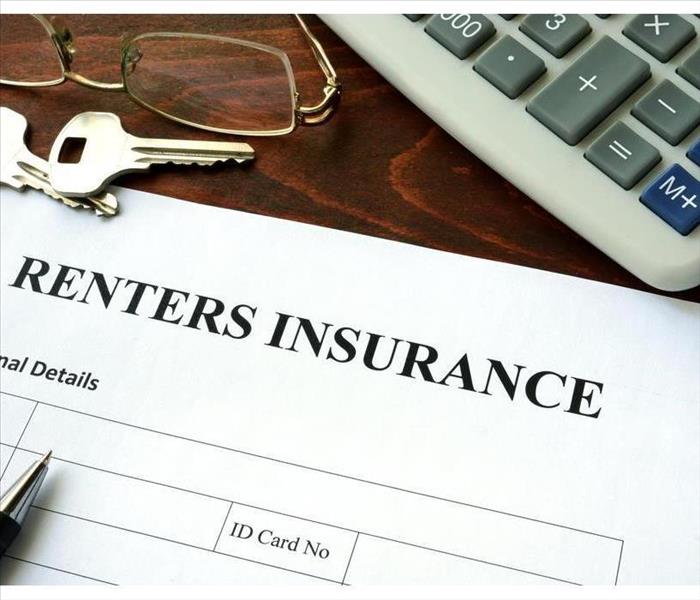 Renters insurance covers a variety of expenses after a fire so be sure to check your policy
Renters insurance covers a variety of expenses after a fire so be sure to check your policy
Basic Information About Renters Insurance and Fires
If you’ve ever experienced the devastating effects of a home fire, you’re likely aware of what your insurance covers. If you’ve never had to deal with fire damage, you’re probably not sure what’s included. Here is some basic information about the three types of coverage and how they relate to your renters insurance after a fire.
Personal Property
Under personal property coverage, fire is considered a covered peril. A peril is any type of unexpected event that results in your personal belongings being damaged or ruined. One thing you can do if you experience a home fire is call a fire restoration specialist to assist in fire damage cleanup. These professionals are Faster to any size disaster and can help clean and remove the prevalent smoke smell from your home. Once you’ve had your home cleaned, you’ll be able to determine what items need to be replaced under your personal property coverage.
Liability
Liability is another type of coverage under your renters insurance. This coverage applies when a fire causes injuries or damage to someone and their belongings due to the fire in your home. As with all types of coverage, limits apply so be sure to understand the specifics of your policy.
Additional Living Expenses
If you’re not able to live in your Elmhurst, IL, apartment or home due to fire damage, your insurance should cover additional living expenses. Fire restoration is essential after a fire and it may take some time until you’re able to return back home. This coverage could cover hotel and food expenditures above what you would normally spend.
Renters insurance covers a variety of expenses after a fire so be sure to check your policy. Personal property, liability and additional living expenses are three types of coverage you should include in your policy. Fire restoration is an important part of getting your home back to normal so contact a professional for assistance.
How to Manage Water Damage Restoration of your Home
10/8/2019 (Permalink)
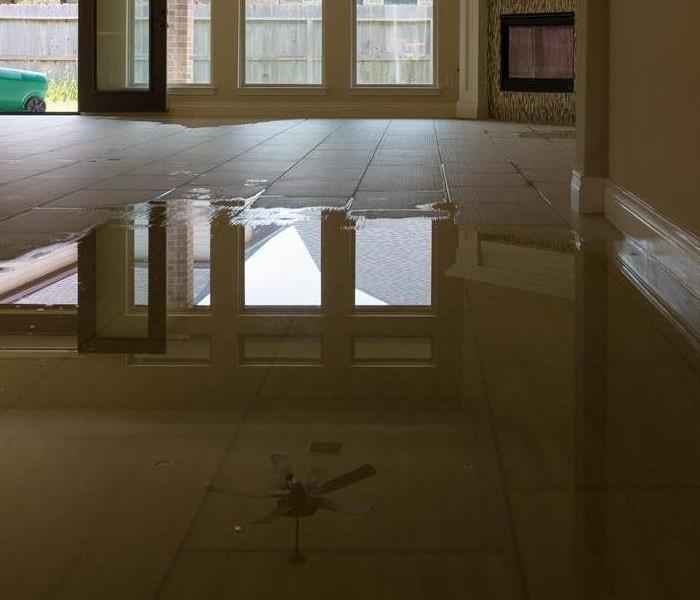 Water in home and water in business problems must be removed as quickly as possible.
Water in home and water in business problems must be removed as quickly as possible.
No homeowner should attempt to recover from a flood alone. They will find the house much easier to recover once they have called a water damage restoration and mitigation firm. The firm that does mitigation and water damage restoration knows specifically how to make the house look beautiful one again, and they will do all the work on their own. They will handle everything from water cleanup to repairs on the house, and this article explains how they will find their home returned to a proper condition.
#1: The Water Damage Assessment
There are many people who must have water damage assessed in their home before they may choose to begin repairs or recovery. The flood damage will be repaired by the water restoration and mitigation firm, and they will have many people come to the house to repair the house after the water is removed. The water in home issue is unique because the family cannot move in until after they have cleaned up. They will repair all water in home problems in a short time, and they will notice there are many ways to ensure that their home is cleaned.
#2: Air Movement and Drying
The drying and air movement process is one that must be handled by the company as soon as possible. A water restoration team knows all the mitigation methods, and they will run fans, open windows and use other mitigation techniques to ensure the house will be dry. Any flood damage or water damage must be repaired as soon as possible, and the water must be removed from the house using the traditional air movement and drying techniques that are used across the industry.
#3: Water in Business Problems
There are many water in business problems that may be handled the moment the mitigation company arrives at the house, and they will show the customer how water damage restoration is completed. Water cleanup may be completed in moments, and it will be a full process that involves the removal of all water damage and flood damage. The flood may be internal, and it may be external if there were storms in the area. Water cleanup may take some time, but it will be done using only the finest techniques.
#4: Moving Quickly
Water in home and water in business problems must be removed as quickly as possible, and someone who has an idea of how to handle all the water will know how to complete the process of water removal. The water cleanup process involves the air movement and drying that must be done, and there are many technicians who will arrive at the house to complete the job.
DIY Water Damage Restoration & Why It's a Bad Idea
10/6/2019 (Permalink)
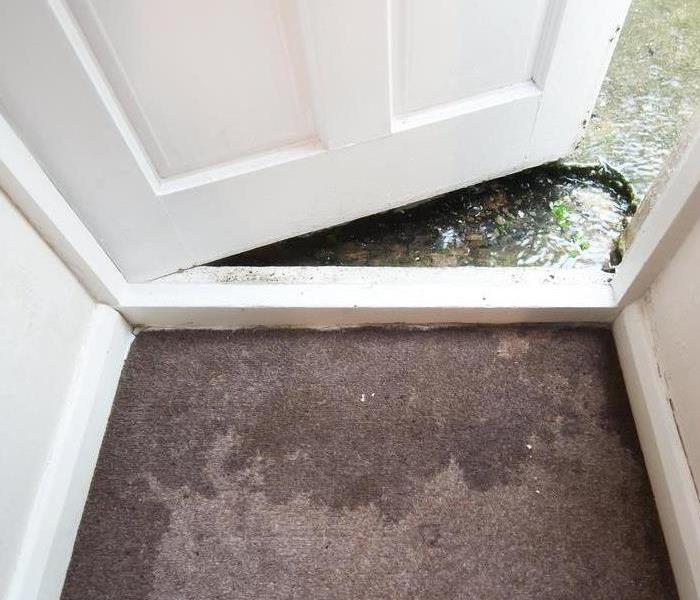 Attempting to perform your own water damage mitigation drying or mold remediation, it's definitely not something that should be attempted on your own.
Attempting to perform your own water damage mitigation drying or mold remediation, it's definitely not something that should be attempted on your own.
More and more people are becoming do-it-yourselfers. It seems that everyone with an internet connection is on YouTube trying to figure out how they can save money by performing services themselves.
While that is an excellent idea when you have to hook up a home theater system or mounting a TV to the wall, however, attempting to perform your own water damage mitigation drying or mold remediation, it's definitely not something that should be attempted on your own. You can rent dehumidifiers and fans, maybe even air filtration equipment, but there are consequences for not performing mitigation services properly. There have been circumstances where the homeowners have rented a few dehumidifiers attempting to dry out the property from a major size water damage job. We applaud their efforts, they don't have the proper training, knowledge and or tools to successfully perform this work. In fact, you need to know how to use the equipment and placement of the equipment or you end up causing more harm and spending more money than anticipated.
The next time you experience a water damage in your home or office, give the SERVPRO professionals a call. We'll help make it "Like it never even happened." For more information, please visit http://www.SERVPROElmhurst.com or call SERVPRO of Elmhurst at 630-758-1701.
EVERY SECOND COUNTS
10/5/2019 (Permalink)
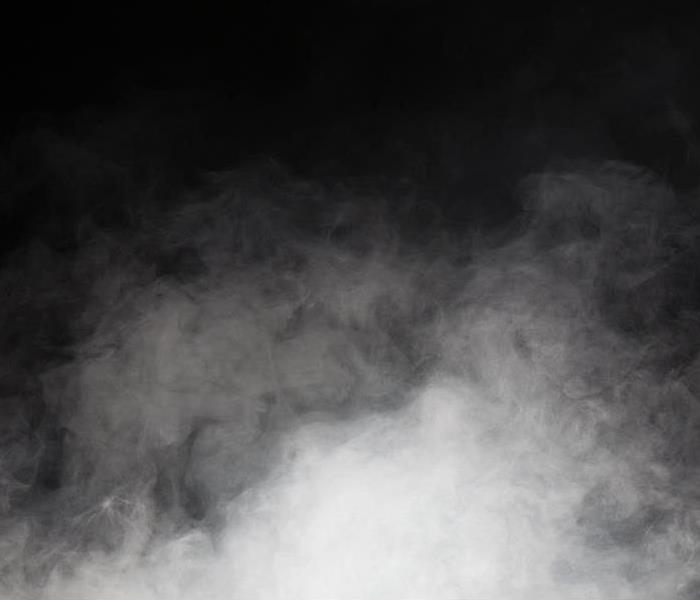 Practice your fire escape plan during the day and at nighttime.
Practice your fire escape plan during the day and at nighttime.
Every second counts during a fire. Fire experts agree; people have as little as two minutes to escape a burning home before it’s too late major fire, making it critical to be prepared and have an escape plan in place. A survey conducted by the American Red Cross shows only 26 percent of families and businesses have developed and practiced a fire escape plan. Once a plan is developed, it is critical everyone in the home or office understands the plan. The best way to do this is by practicing the escape plan at least twice a year. Increase your chance of surviving a fire by ensuring you have working smoke detectors in place, building an escape plan, and then practicing it. The following are a few suggestions to help you develop an emergency escape plan.
Draw a map of each level of your home or business and show all the doors and windows. Find two ways to get out of each room. Make sure all doors and windows that lead outside open easily.
Consider escape ladders for sleeping areas on the second and third floors. Only purchase collapsible escape ladders evaluated by a recognized testing laboratory. Store them near the window where they will be used.
Choose an outside meeting place a safe distance in front of your home where everyone can meet after they’ve escaped. Make sure to mark the location of the meeting area on your escape plan.
Teach children how to escape on their own in case you cannot help them. Plan for everyone in your home or office, with special considerations for elderly or disabled individuals. Practice your fire escape plan during the day and at nighttime.
IICRC Certified Firm
10/2/2019 (Permalink)
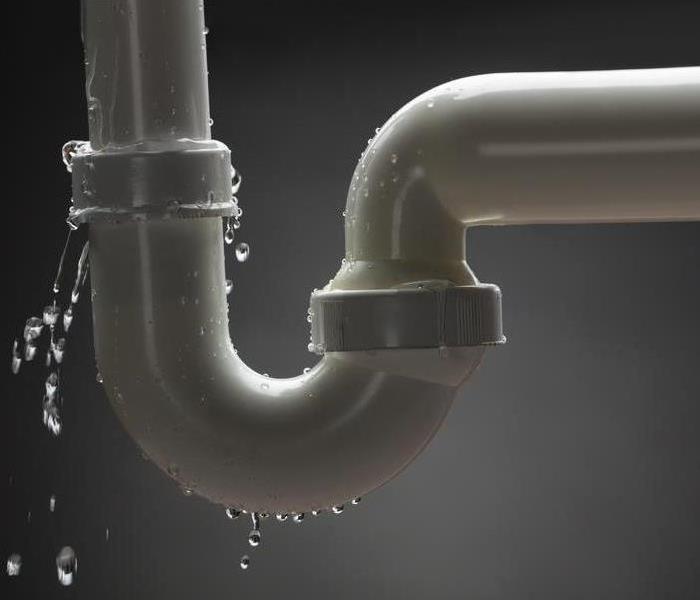 Every five years, the standards are reviewed and updated.
Every five years, the standards are reviewed and updated.
SERVPRO of Elmhurst is an IICRC firm. The Institute of Inspection, Cleaning and Restoration Certification (IICRC) creates the standards for the restoration industry and provides training and certification to restoration companies. IICRC Certified Firms have the right to display the IICRC Certified Logo.
IICRC Certified Firms must
* Present accurate information to consumers and conduct business with honesty and integrity.
* Require a technician on all jobs who have been formally trained and passed all required tests.
* Require a continuing education program to keep technicians up-to-date on the latest changes in the industry.
* Maintain liability insurance to protect all parties in the event of an accident.
* Maintain a written complaint policy and agree to Better Business Bureau or similar arbitration to resolve disputes, and accept the conclusions and recommendations of arbitration.
The IICRC Develops The Standards For The Restoration Industry
The IICRC has been the driving force in establishing the main industry standards and reference guides for professional carpet cleaning, water damage restoration, and mold remediation. These IICRC standards take years to develop and require the coordination of experts in the field: manufacturers, industry organizations, insurance professionals, training schools, contractors, and public health professionals.
Every five years, the standards are reviewed and updated. The water damage restoration field changes rapidly with advancements in technology and science, and therefore the standards must evolve to keep pace.
PLAN and PRACTICE your ESCAPE!
9/30/2019 (Permalink)
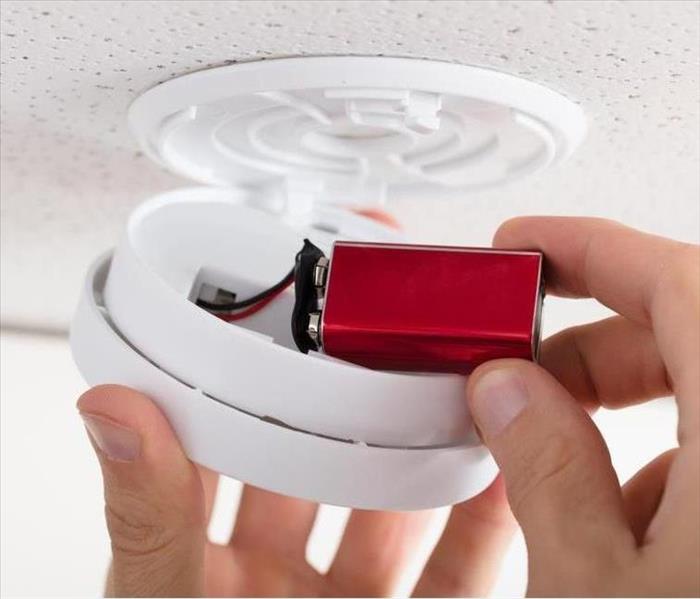 October is Fire Prevention Month and an excellent time to examine the emergency preparedness plans for your home and business.
October is Fire Prevention Month and an excellent time to examine the emergency preparedness plans for your home and business.
October is Fire Prevention Month and an excellent time to examine the emergency preparedness plans for your home and business, including your fire escape plan. Do you have a fire escape plan? Have you changed your smoke alarm batteries within the last year? Are you prepared if a disaster strikes?
The National Fire Protection Association (NFPA) sets aside a designated week each October to focus on fire prevention. The 2019 theme is "Not Every Hero Wears a Cape. Plan and Practice Your Escape!"
According to the NFPA, once the fire alarm goes off, "you could have less than one to two minutes to escape safely," yet only 8 percent of people surveyed said getting out was their first thought after hearing a fire alarm. Creating, implementing, and practicing a fire escape plan for your home or business may be the difference between safety and tragedy. Make a plan today! Escape planning and practice can help you make the most of the time you have, giving everyone in your home or business enough time to get out.
How do you define a hero? Is it a person who is courageous and performs good deeds? Someone who comes to the aid of others, even at their own personal risk? A hero can be all of those things! A hero can also be someone who takes small but important actions to keep themselves and those around them safe from fire. When it comes to fire safety, be a hero in your household or community.
In this issue of the September Restoration Newsline, we will cover several fire safety topics, as well as information on creating your fire escape plan.
SERVPRO of Elmhurst wants you to stay safe, informed, and prepared to help ensure you are ready for any disaster that comes your way.
Why Does Household Mold Keep Coming Back?
9/26/2019 (Permalink)
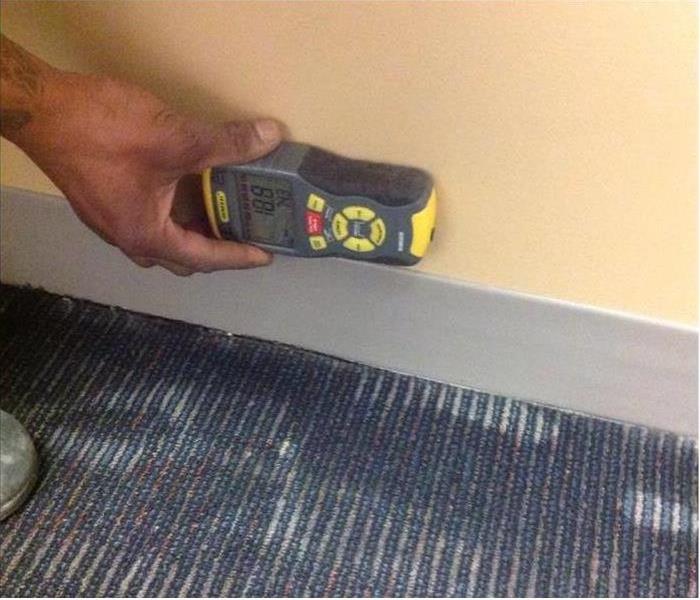 Checking for moisture in a Schiller Park, IL home
Checking for moisture in a Schiller Park, IL home
If you’ve spotted mold in your Schiller Park, IL, home, you’ve probably taken the next step and tried to remove it. Unfortunately, mold is resilient and tends to return after it’s cleaned. Keep reading to find out why household mold, such as black mold, keeps coming back and what you can do about it.
What Is Mold and How Does It Grow?
To understand why mold is so persistent, it’s important to look at its nature. Did you know that thousands of mold species exist? Fortunately, most types of mold are harmless and you’ll never notice them. Molds are actually a group of fungi that reproduce by airborne spores. The following warm, moist areas in your home are perfect places for spores to thrive:
- Basements
- Showers
- Carpets
- Ventilation ducts
With basic mold cleanup, it’s actually impossible to remove every tiny spore. This is why mold will return over and over again. When it comes to infestations of more damaging types of mold such as black mold, this can lead to extensive property damage.
What Can You Do?
An effective way to combat mold growth is to remove moisture sources. You may be able to contain some small areas of mold growth by cleaning. However, if you clean up the mold but fail to remove the moisture source, the mold will come back. Promptly fixing leaky plumbing and drying out water-damaged areas should help prevent growth.
Mold may also grow where you can’t see it, especially if there are leaks in the plumbing in your wall. If you think you might have mold in your home, contact a professional to perform an inspection.
By understanding how mold grows, you’ll be better equipped to tackle it. Because of the nature of mold, a simple cleaning is not enough to keep it from coming back. If you suspect your property has damaging molds, such as black mold, contact a professional mold remediation service in Schiller Park, IL, to properly handle the situation.
Maintain the Old Pipes in Your Rental Property
9/26/2019 (Permalink)
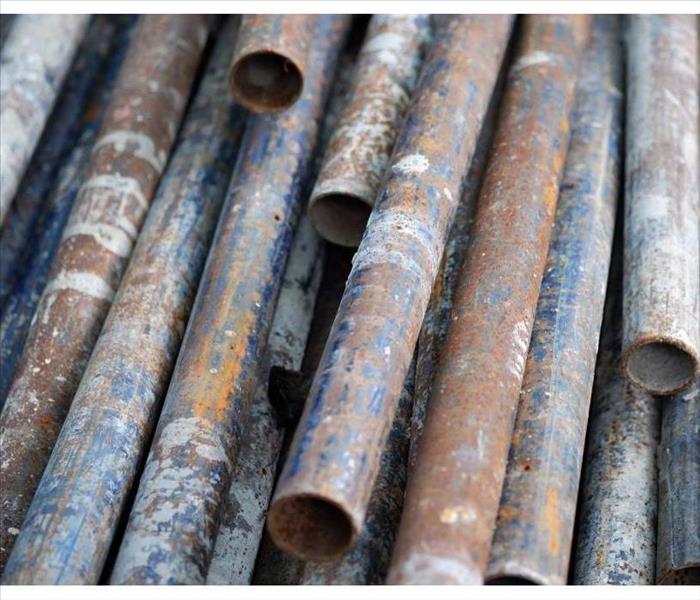 Maintain the old pipes
Maintain the old pipes
When property owners in Melrose Park, IL, take on an older house or complex, they are also liable for the problems with them. One of these issues is their plumbing system, which can sometimes consist of polybutylene pipes and have a greater tendency to deteriorate or clog. If you are considering renting out an older building, you should be aware of the risks associated with this system and prepare a maintenance routine to keep it functioning.
Potential Problems With Old Pipes
These old pipes are usually made of unreliable or outdated materials that create more problems than they solve. For instance, lead pipes can pollute the water, while rusty piping can make the water take an unpleasant smell and a brown color. A common issue with older houses and rental complexes, particularly those built between 1978 to 1995, is polybutylene piping. This material was popular because it was cheap and easy to install, but its interaction with chlorine creates brittleness and later, water damage. Commercial building restoration services can assist you should this incident occur.
Detect and Treat Clogs
Older pipes are prone to clogs and blockage, which are an inconvenience to tenants and clients in your property. There are several unclogging options for these old pipe systems.
- Snake or wire
- Plunger
- Chemical cleaners
- Enzyme and hot water mix
Determine the severity of the clog before attempting these treatments.
Maintain the Old Pipes
Replacing these pipes is not always a realistic option. Sometimes, the practical action is using a monthly maintenance routine while a permanent replacement is planned. Keep the pipes unclogged with an enzyme and warm water mix. Run hot water down, then pour the enzyme mix and let it sit overnight. Afterwards, flush it down with more hot water to flush the contents down.
The outdated pipes in your Melrose Park, IL, rental property, whether they are made of polybutylene or another material, can endanger the property and your rent business. Protect both by actively maintaining and repairing the plumbing system.
Can You Salvage Wet Building Materials After a Flood?
9/18/2019 (Permalink)
When water comes into your Elmhurst, IL, home from a broken bike, sewer backup, foundation problems or anything else, your first thought should be about the safety of everyone inside. Then, you probably start worrying about the integrity of the structure and what you can repair or salvage. Swelling wood, for example, is a typical result of flooding. Luckily, you can use many of your building materials again once crews clean up the water.
Where's the Damage
There's a lot at stake when floodwaters find their way into your house. Besides worrying about issues such as water pipe repair, there are a host of other areas of your property that may need attention from a flood restoration company. Some of these include:
Carpet and wood floors
Subfloor
Drywall
Cabinets
Furniture
Electronics
When Wood Swells
Swelling wood indicates an excessive amount of water in building materials and other areas. When this occurs, professional crews will have to tear out and replace the items. This usually happens with swelling in the sub-floor and with kitchen cabinets. Fortunately, expert restoration companies have the skill and experience to help get your home back into shape in a timely manner so you can feel comfortable resuming your regular daily activities.
Wet Wood
Supply line problems are a common cause of flooding in homes and buildings. If this happens where you live, there's a good chance that the drywall and areas of your home with wood will be wet. In many cases, crews can dry out and reuse the wood. The team will thoroughly sanitize the materials to reduce or even eliminate the risk of mold growth.
After water troubles, you don't have to give up hope that wet and swelling wood in your home will require complete replacement. If you hire a skilled company, the professional technicians can salvage much of the wet materials.
How Storm Damage Creates Basement Flooding
9/10/2019 (Permalink)
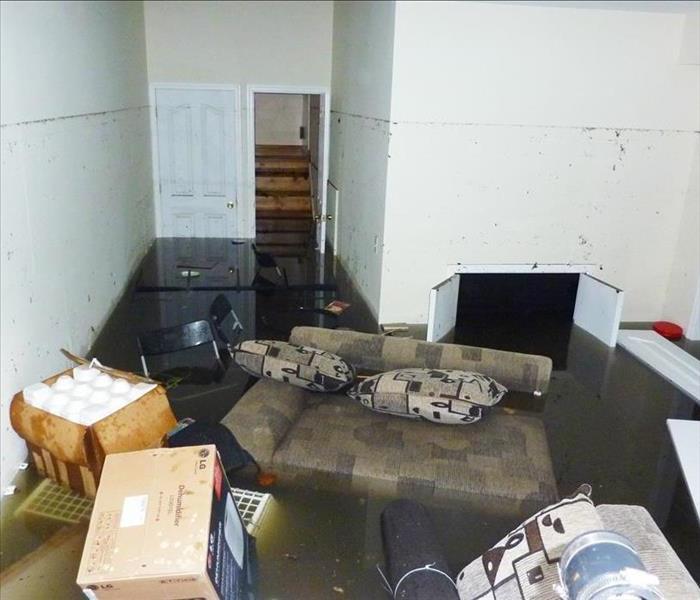 Flooded basement in Stone Park, IL
Flooded basement in Stone Park, IL
An intense storm can have a devastating impact on your Stone Park, IL, home. Sometimes, that aftermath is a flooded basement. Learning the causes behind such an incident can make the cleaning and restoration processes easier and help you prevent any further backups.
What Causes a Basement Flood?
Due to the position and structure of your residence’s basement, it is vulnerable to several types of flooding. Most of these floods manifest after heavy storms and rain, and they are usually caused by the following reasons:
- Sewer water buildup caused by clogging (waste, trash, roots, vandalism, etc.)
- Storm water backing up due to outdated drain design
- Excessive surface water caused by landscape slopes or blocked gutters
- Broken or defective pipes
- Extra groundwater from hydrostatic pressure
It is imperative to find the specific cause of a flooded basement as soon as possible. Finding the source will make it easier to call a professional to fix the problem and prevent further damage. Additionally, the less water you have in the basement, the easier it will be to clean up.
How Should You Handle a Sewage Backup?
Now that you have located and controlled the source of the flooding, it is time to clean the basement. First, immediately call utility companies such as your gas company and your electricity provider, since having these services active right now is potentially dangerous. Then, assess as much of the damage as possible. Finally, contact a storm damage restoration company and provide its employees with the assessed information. They can safely repair the damage to the basement in a safe and prompt manner.
A severe storm can reveal weaknesses in your home’s sewer system that can also leave behind a flooded basement. Even though this event can be overwhelming, taking quick action by identifying the source of the problem, recording the damage and contacting restoration professionals will stop the problem and return the basement to a safer, cleaner state.
How To Detect Mold in Your Air Ducts
9/9/2019 (Permalink)
Mold can be hiding in many different areas of your commercial building. One of the most common areas where mold is found is in a building’s air ducts. If you have a mold problem in your air system, it’s crucial to schedule an HVAC cleaning as soon as possible before the mold begins to spread to other parts of your building. To detect signs of mold in your Elmhurst, IL, business, follow these guidelines.
Understand Mold Growth
Before you can begin to address mold in your ducts, it’s helpful to understand what may be causing the problem. Mold growth in vents is typically a result of:
Vents not being sealed properly
Buildup of condensation
Trapped dirt, debris or dust
Fibers from insulation
Be sure to look for these materials when you open up your vents. Remember that if any form of moisture finds its way into your air ducts, it can further encourage mold growth and cause it to spread.
Look for Signs
Once you’ve ruled out the cause of mold, you can look for signs of it in your ducts. If you notice any black or white spots in the vents, it can indicate that there is a mold infestation and that an HVAC cleaning is required. In addition, a musty smell that comes from your air system may be a sign of mold. Be sure to stay aware of any clues that you come across and call for cleaning vents services if needed.
Call a Professional
If you suspect that there is a mold problem in your business, it’s best to have a professional inspect the building for any signs of it. Even if you think you have tracked down the source of mold in your building, it is likely that there are other contaminated areas that you may not be aware of.
Once a professional has detected the mold, he or she can remediate the issue with an HVAC cleaning. Don’t hesitate to call mold remediation specialists to bring your business back to life.
Double Disaster: How To Deal With Water Damage After a Fire
9/7/2019 (Permalink)
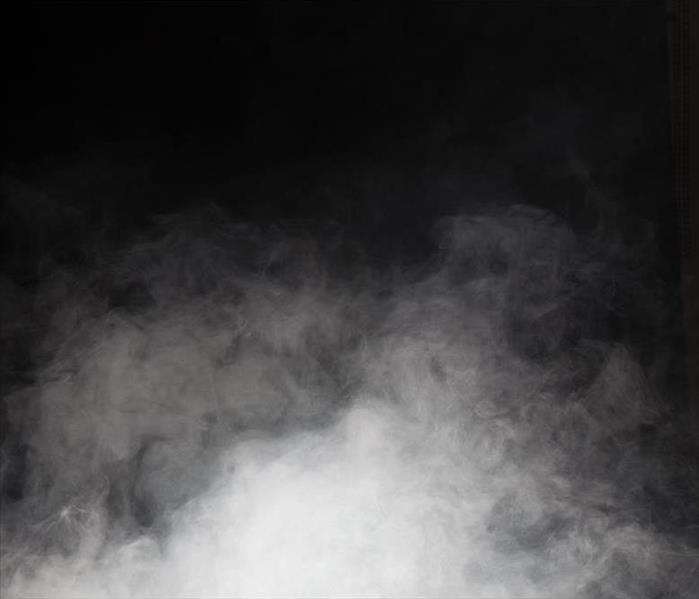 A quick response after fire damage is key to getting your business up and running again.
A quick response after fire damage is key to getting your business up and running again.
For commercial properties, there are few events that are more of a setback than fire damage, except for maybe the water damage introduced from extinguishing the fire. The fire season is getting longer and hotter in Stone Park, IL. A fire and water restoration service can get your business back on its feet after a fire of any size; acting quickly is the key.
What To Expect From a Restoration Service
To help you navigate fire damage (and ensuing water damage) with the least heartache, a fire and water restoration business provides the following:
1. A prompt response: When you first call, professionals will ask questions to accurately pinpoint which of their specialists to send out.
2. Damage assessment: You will be visited by experts in fire and water damage assessment. They will look behind the scenes of your commercial property, from electrical and structural elements (roof, floor, walls and beams) to pipes and beyond. They will also assess visible damage to components such as fabric, paint, computers, paper goods, hardware, electronics and furniture.
3. Structural triage: The first priority is to stop further damage. This means temporarily, but immediately, using wood or tarps to patch holes in roofs, walls, windows, pipes, and doors so that your belongings aren’t further ruined by leaks, weather or thieves. The restoration experts have the know-how and the equipment.
4. Restoration: Professionals work fast and have the resources. You want assurance that all problems are fixed by professionals who know what they’re looking for. The goal is to get back to pre-fire normalcy, “Like It Never Even Happened.” Fire is dramatic, but both fire and water damage are often cosmetic. Items that don’t have to be discarded can often be cleaned with the right equipment and techniques.
5. A final walk-through: Experts will guide you through an evaluation of your facility to lessen the chance of being in the path of a future fire.
A quick response after fire damage is key to getting your business up and running again. Further compromise to your assets can be mitigated by hiring the right people, right away.
How to Make a Water Damage Claim
9/5/2019 (Permalink)
Broken or bursting pipes in your Elmhurst, IL, home can create a big mess and a lot of damage. The good news is that you don’t need to handle it on your own. In most cases, your homeowner's insurance will cover much of the cost of repairs. Here are some steps that you should take when filing a claim.
1. Call Your Insurance Agent
The first thing that you should do is call your insurance company to inform them of the bursting pipes and begin your claim. Waiting too long to file a claim can result in coverage being denied, so you should do this as soon as you can.
2. Document the Damage
Your insurance agent will need to have documentation of the property in order to file your claim. You should make a list of areas of the home that have been affected as well as any belongings. Taking pictures of the water damage will help as well.
3. Prevent Further Damage
While you may not be able to fix broken pipes on your own, you should take any steps that you can to prevent damage from becoming worse while you wait for the emergency restoration company to begin repairs. This can include blocking off flooded rooms or relocating smaller belongings to a dry area.
4. Go Over Your Policy
In most cases, water damage will be covered by your insurance. It is still a good idea, however, to go over your policy to make sure you know all the details. This can make the process go more smoothly and allow you to get things back to normal more quickly.
As long as you have not neglected to properly maintain your property, the damage that results from bursting pipes and other accidents will most likely be covered by your insurance. Make sure to follow the proper procedures when filing a claim so that you are able to get the most from your policy.
What You Should Know About Chemical Drain Cleaner
8/27/2019 (Permalink)
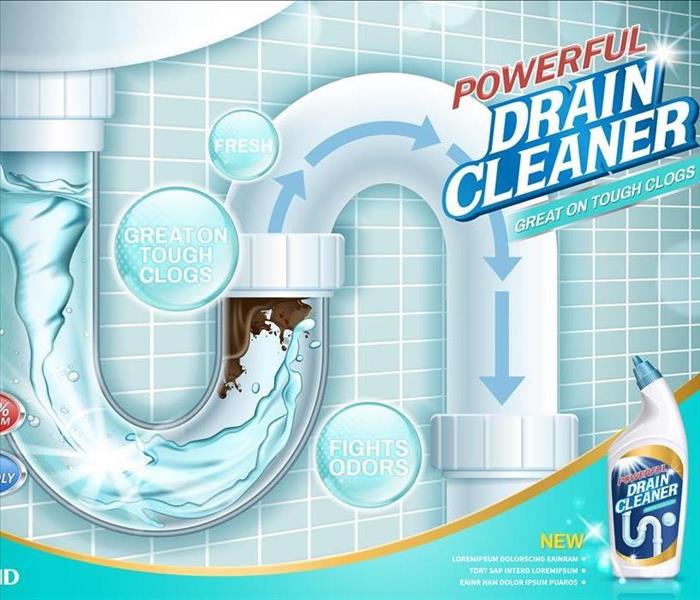 Chemical drain cleaners are not good for your pipes
Chemical drain cleaners are not good for your pipes
A clogged drain can be an extremely inconvenient issue as a homeowner in Northlake, IL, so you are probably looking for the quickest solution. If speed is your aim, chemical drain cleaning options may end up at the top of your list. However, there are factors other than timeliness to consider when choosing a solution.
Not Good for Your Pipes
Chemical drain cleaner is quick because it's powerful- so much so that it can damage more than just the blockage. If your pipes can't withstand the cleaner, you may end up with a bigger problem than you started with. Avoid using chemicals if you have certain plumbing situations, like:
- a completely blocked drain
- old metal pipes
- plastic pipes
Not Good for the Environment
If you are handling your clogged drain on your own, that means you are getting up close and personal with the process. Chemical cleaners are toxic to both humans and animals. You will need to make sure you are wearing the proper personal protective equipment. If these chemicals are introduced to the water supply, they can then move on to poison lakes, streams and wildlife. All of this also means that they are dangerous to keep inside your home.
There Are Other Options
When sewage cleaning, chemicals should only be used as a last resort. Mechanical methods exist, such as plungers or augers. There are also non-toxic biological drain cleaners that use enzymes or bacteria to eat through the clog. This may take a little longer, usually up to 24 hours, but is much safer for your pipes and your well-being. You can also call a professional service if you do not feel confident clearing the clog yourself. Be sure to ask about what method they will use.
As a property owner, you are likely to encounter a clogged drain eventually. You should understand your options so you can make an informed decision about what's best for your home and family.
The FEMA Recommendations for Flood Preparation
8/26/2019 (Permalink)
Major storms can leave your Bensenville, IL, home in bad shape, and you may expect that flood insurance will keep you covered. However, sitting back and waiting for the insurance adjuster to get back to you with good news could be a big mistake.
After a natural disaster or huge storm, adjusters are often busy with several homes. You could be waiting for a long time before the professional reaches your home.
While waiting, flood damage will get worse. As water seeps into the walls and floors of your home, mold has time to get established and spread throughout the home. Many flood remediation and home repair companies work directly with insurance companies. Waiting for an insurance adjuster could increase the costs of repair to your home. Take action right away to get the repair work started.
Hire a Public Adjuster
One step to consider taking is hiring a public adjuster. The adjuster sent by your insurance company represents the insurance company's best interests. A public adjuster works for your best interests. The work done by this professional may speed up the claim process with your flood insurance company and make sure you get as much coverage as possible.
Decide Whether To File a Claim
Sometimes people avoid filing claims if they believe that their premiums will increase as a result. In this case, homeowners may proceed to do repairs on their own without even involving the adjuster. However, if further damages occur as a result of that inaction, insurance coverage may no longer be effective. It's true that a "claims free" discount could be lost, but contacting the adjuster is a good way to determine whether to file the actual claim or not.
Get Started on Repairs
You can get a lot of work done while you're waiting for the adjuster from your flood insurance company to show up. Don't wait to contact repair and reconstruction professionals to avoid mold damage. Reach out to a public adjuster to represent you.
When to Use Commercial Flood Insurance
8/20/2019 (Permalink)
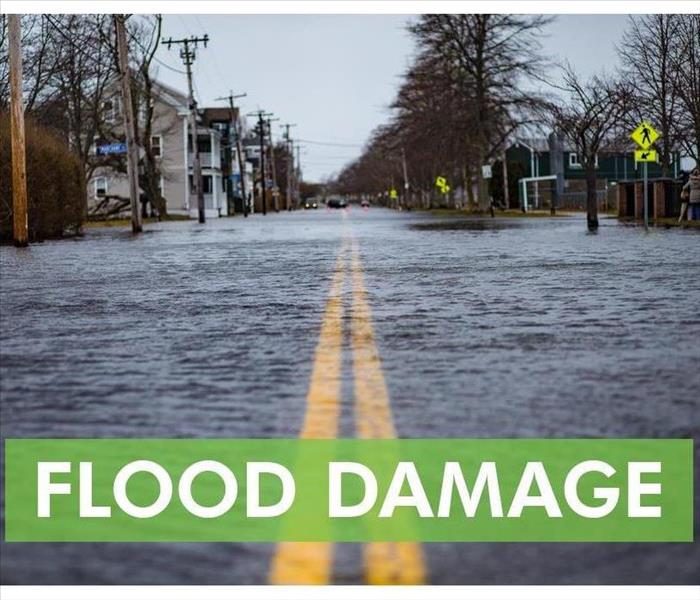 Flood insurance will be needed if your building is flooded due to storm surges
Flood insurance will be needed if your building is flooded due to storm surges
Flood insurance is something that every business owner should consider purchasing for their Berkeley, IL commercial property. An insurance plan that just focuses on restoring damage caused by a flood can literally save your business from having to close its doors after a devastating storm or other causes of floods.
Definition
As the name implies, flood insurance provides financial protection to your business if a flood occurs and damages your building. A flood is defined as an event that affects an extensive area, usually two acres or at least two buildings. Most often, flood insurance will be needed if your building is flooded due to one of the below causes:
- Storms and extreme weather: Heavy rains, snow melt, and storm surges
- Other acts of nature: Overflowing rivers and storm surges are often the result of a major storm, but regardless of the cause an overflowing natural body of water can cause devastating floods
- Man-made disasters: Broken levees and dams can also be devastating to nearby areas and have been known to strike without warning
Coverage
Remember that flood insurance will only cover your flood damage if the root cause is from an event outside of your particular building that affects more than just your space. If, for example, your building is flooded due to a burst pipe inside your own walls, you should turn to your general commercial insurance plan. Once it is determined that your building has been damaged by a flood, your insurance company will work with you to cover costs associated with the cleanup and restoration process. The overarching goal is to receive financial help that will get your business back to its previous operational state. A business is not required to purchase insurance specific to a flood unless it is located in a flood zone and is part of the mortgage requirements. However, a flooding catastrophe can happen anywhere at any time, so protecting your building against a flood can save your business from potential bankruptcy.
Treating Workplace Burns: The Do's and Don'ts
8/13/2019 (Permalink)
 Avoid popping burn blisters
Avoid popping burn blisters
Burns in the workplace are more common in some industries than others. Whether it be from fire damage or hot equipment, being prepared for these emergency situations can go a long way in keeping your employees safe and comfortable under unfortunate circumstances. If a serious burn takes place, here are some things to do (and not do) until Hillside, IL, medical personnel arrive.
What To Do
Move the injured individual away from danger. First and foremost, get everyone to safety. If there is fire damage in the building, try to get everyone outside to safer surroundings. This will prevent further injuries.
Elevate wounds. Keeping burns above heart level, when possible, can help to reduce swelling and keep pain at bay. Circulation is key to quickly addressing severely burned skin.
Make them comfortable. While you don't want to do anything too drastic in the case of a major burn, applying basic burn first aid can help the injured person to be more comfortable while you wait for help. Remove tight clothing or jewelry around the affected area. Apply a cool, clean cloth to blistering skin. Offer over-the-counter pain reliever and water to ease the pain.
What To Avoid
In addition to applying first aid, avoid these common mistakes that often make things worse:
Water submersion. Rather than submersing the individual with water, apply cool damp cloths or bandages only where the skin is affected. Water submersion may send the individual into shock or hypothermia if their body temperature drops too rapidly.
Popping burn blisters. When severe burns occur, it is common for the skin to bubble-up into red hot blisters. Although they may look irritated, never pop or break the skin intentionally. Doing so may lead to infection.
Ice cold water. While cooling the burn with cool compresses is recommended, ice cold water should never be used. After a burn occurs, very cold water can cause tissue damage to the already injured skin. Use lukewarm to cool water instead.
Facing the Aftermath
After the smoke has cleared and fire damage cleanup ensues, be sure to keep tabs on injured employees. A little encouragement can go a long way in the recovery process after experiencing a major burn.
Could Mold Be Growing in Air Vents?
8/12/2019 (Permalink)
Savvy business owners in Elmhurst, IL, understand the importance of maintaining the integrity of the building from which it operates. During an inspection, a common culprit to look for is mold. While the focus may be in areas prone to dampness, like air-conditioners and windows, a ventilation system should not be overlooked. Regular HVAC Cleaning can help keep mold from making its home in air ducts.
Causes of Growth
Mold spores drift through the air searching for an ideal location to take root and reproduce. They require food, water and stable temperatures to flourish, which makes HVAC systems an ideal location for it to call home. The purpose of these systems is to balance temperature. As the air blows, dust scatters through the system, providing sustenance for mold. Regular HVAC Cleaning can help limit that food source. If there is a leak or condensation in the system, mold has all it needs to begin its continuous reproductive cycle.
Signs of Trouble
While cleaning vents should be done regularly, it can easily move down the to-do list. When that happens, some telltale signs of mold can help you put it to the top of the list.
• Mold has a strong, unique smell. If it is noticeable in multiple areas, or stronger when the HVAC system is on, it could be growing in the vents.
• Although you may not be able to see it in the venting system, it may be evident inside the grate or around vents and registers.
• If you notice any signs of moisture around vents or in the ceiling, call a professional to find the source of the problem.
Prevention is the key to eradicate mold. HVAC Cleaning not only keeps the system operating properly and efficiently, but it also helps remove elements that mold thrives on. Along with regular cleaning, changing filters and clean drip pans can decrease the chances of mold forming.
The FEMA Recommendations for Flood Preparation
8/12/2019 (Permalink)
Some buildings are more at risk of flooding than others in Elmhurst, IL. The Federal Emergency Management Agency, or FEMA, aims to prepare every individual to handle any natural disaster that might affect him or her, and floods are no exception. There is a wealth of flood preparation knowledge you can find from this agency, including a flood risk map that shows you exactly how likely your home is to be affected by a flood. You should take the time to learn:
1. Which flood zone your home is located in
2. What flood insurance options you have
3. Where you fall on the flood insurance rate map or FIRM
4. The elevation of your property
5.What the evacuation plan is for your area
Flood Insurance
It is a good idea to have water damage covered by your insurance policy, but you may not realize that water damage and flooding damage is not the same thing. Water damage is caused by things like burst pipes or leaky roofs, but the damage caused by external factors like tidal waves or mudslides fall into a different category. Most people do not need flooding insurance, but if you are in a high-risk area, it might be beneficial. The National Flood Insurance Program, or FEMA NFIP, is a special program FEMA offers that provides affordable flooding damage insurance.
What To Do
FEMA also has recommendations for what to do during a flood. You should be intimately familiar with the evacuation plan in your area and have all the supplies you need before a flood happens. You should have plenty of canned food, bottled water, a first aid kit, and general tools. It might be good to have a flooding damage restoration company in Elmhurst, IL already in mind so you can start the process of repairing as soon as possible. Flood water contains contamination, so it is not safe to return to your home no matter how minor the damage is.
Lightning-Caused House Fires are Seriously Dangerous
7/31/2019 (Permalink)
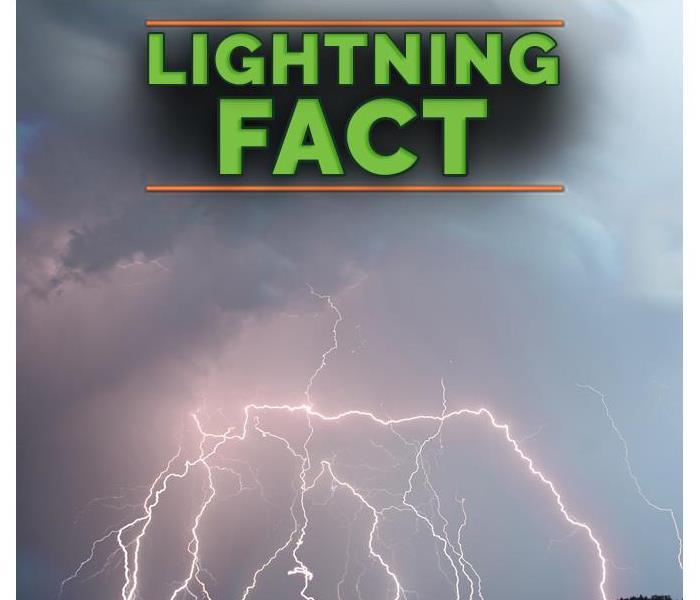 One strike in Besenville, IL can easily cause a lightning fire
One strike in Besenville, IL can easily cause a lightning fire
Lightning is an incredibly common event. Every second, there are around 45 flashes of lightning globally, and the power of just one strike in Bensenville, IL, can easily cause a lightning fire. The U.S. averages about 51 deaths and nearly 23,000 fires caused by lightning strikes per year. While only about 18% of fires caused by strikes occurred in homes, they caused the majority of deaths, injuries and overall losses.
Lightning Fire in Houses
Studies show that while less than 1/5th of lightning fires occurred in homes, they accounted for
- 88% of civilian deaths associated with lightning caused fires,
- 77% of the associated injuries, and
- 70% of the direct property damage
Lightning-caused house fires are responsible for around nine deaths, 53 injuries and over $450 million in property damage each year on average. The ubiquity and power of this natural force is often overlooked – until something dreadful happens.
Another problem caused is damage to electronics. Some power companies offer a lightning-protection device that they install in your service box. While not perfect, this has been shown to mitigate a great deal of damage to devices and in some cases may be guaranteed to cover losses.
What to Do If Your Home Is Struck by Lightning
Lightning can be insidious – if you know your home has been struck, call the fire department. As electricity, it always takes the path of least resistance, meaning the damage can be hidden. Attic fires have been known to develop and smolder for quite some time before showing symptoms of fire damage. Its path can branch out and go totally unexpected routes, so it’s best to be safe. The fire department can come out and inspect your home for hidden dangers.
Dealing With the Aftermath of a Lightning Fire
With luck and a proactive approach, you can keep the damage very limited. However, once a fire has caused significant smoke damage, you should contact your insurance agency in Bensenville, IL, to file a claim. The residue from a fire is often toxic and difficult to locate and remove so insurance will normally pay for a professional fire damage cleanup.
Cleaning Commercial Bathrooms
7/24/2019 (Permalink)
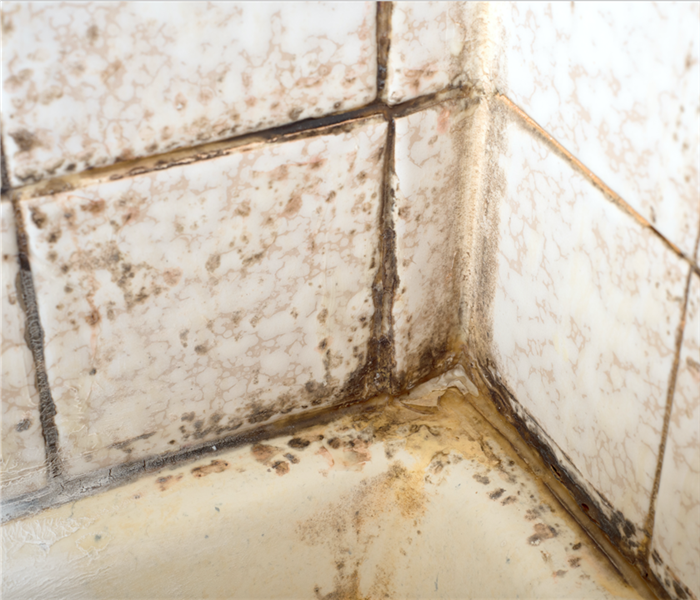 Mold in grout and caulk.
Mold in grout and caulk.
Your commercial location in Franklin Park, IL, deserves a clean, comfortable business bathroom. If you suspect mildew in your commercial bathroom, a professional mold removal company can give you a mildew clean room and provide preventative services you need. Find out today how to identify and remove mildew.
Identifying Bathroom Mildew
Bathroom mold and mildew can typically be seen. However, here are some other signs to determine whether your bathroom needs professional cleaning:
- Musty odor
- Mold in the corners
- Mildew along grout or caulk
- Standing water on the floor or another surface
These signs typically point to mold or mildew growth. Whether it’s already happened or not, it’s important to thoroughly clean the area. Mildew can quickly damage water barriers throughout your commercial bathroom, including mold and grout.
Replacing Grout and Caulk
While mold cleaning solutions and mildewcide are effective mold and mildew clean techniques, sometimes the problem is deeper than a surface solution can handle. In that case, it may be time to completely remove and replace your grout or caulk.
Grout in between bathroom tiles and caulk along the edges of fixtures are common areas for mildew to grow in a commercial bathroom. Because of the porous nature of grout, it’s essential to completely remove it and replace it to ensure a thorough cleaning.
However, improper removal and installation of these materials can compromise the waterproof barrier and allow water to collect behind sinks, under toilets and in corners of your commercial bathroom. Choose a professional remediation service to maintain the high cleanliness of your business bathroom.
Completing Commercial Cleaning
Clean your commercial bathroom and keep it dry to prevent further mold growth. Work with a company that is Here to Help and is capable of inspecting and removing mildew from your property. When you choose a mildew clean and prevention service, you’ll keep your location protected and comfortable for your customers and coworkers.
Your Home Needs THIS Many Fire Alarms and Other Facts That May Surprise You
7/17/2019 (Permalink)
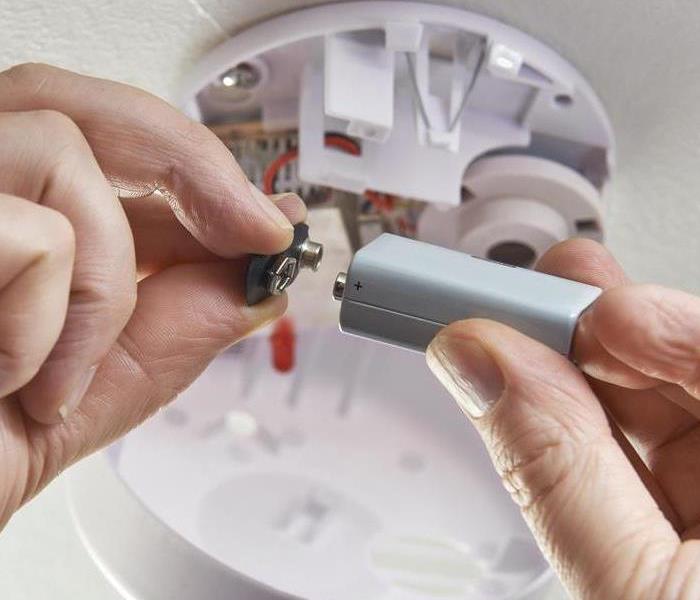
If you're like the average American, your home has one fire alarm, two tops, and that's not enough. According to one survey, Americans need to equip their homes with another 100 million smoke alarms to be fully protected.
It's not enough to have working alarms, though. You also need to know how to react when an alarm goes off. Test your fire safety knowledge by attempting to answer the questions below.
Q: How Many Fire Alarms Should the Average Home Have?
A: The National Fire Protection Association recommends placing one alarm in every bedroom, one outside each sleeping area and one on every level of the home. So, if your home has three bedrooms and two stories, you need a minimum of five fire alarms.
Q: What Type of Fire Alarm Should You Install in Your Home?
A: An ionization alarm sounds when a fast-moving fire occurs while a photoelectric alarm detects smoke damage and smoldering fires. Because you cannot anticipate what type of fire will move through your home, you need both types of detectors.
Q: How Often Should You Replace Your Fire Detector?
A: Everyone knows to replace their batteries after one year or when they start chirping, but how often should you replace the fire detector itself? Do you need to do it annually, every five to seven years or every eight to 10 years? The answer is every eight to 10 years.
Q: How Many Minutes Do You Have to Escape a House Fire?
A: Had you asked a fire damage professional 10 or 20 years ago, he or she might have said you have between 20 and 30 minutes to get out. The reality is you have between three and four minutes to get out of a house that's on fire. This short timeframe is why it is so important to have smoke detectors throughout your home.
This information is not meant to alarm you but simply to inform you. If you only have one fire alarm, go out and buy four more. For more safety tips, talk to your Elmhurst, IL fire department.
What To Know About Sewage Backup Mitigation
7/17/2019 (Permalink)
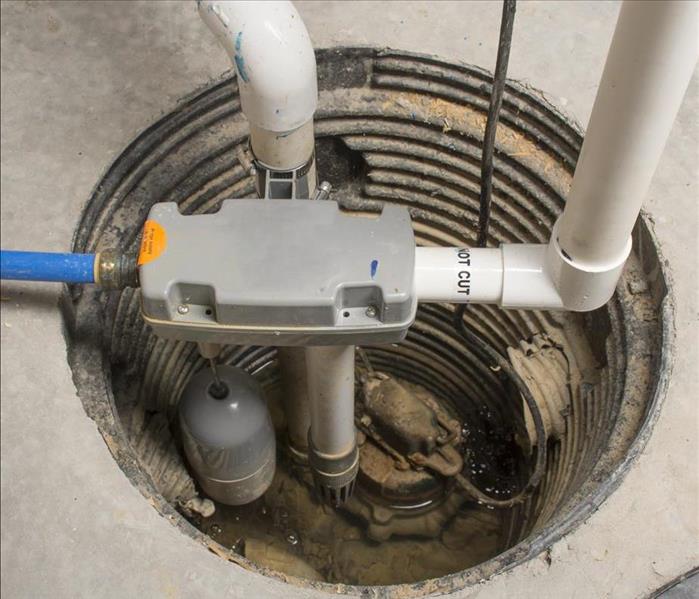 Consider the installation of a sump pump
Consider the installation of a sump pump
Protect Your Home Against Sewer Problems
If you're worried about sewage backup in your, Elmhurst, IL, home then you may be wondering what mitigation steps you can take to keep your property safe. Here are three things you can do to help protect your residence against potential sewer problems after a heavy storm.
1. Know The Risk in Your Area
When preparing your home against storm damage, it's important to know the risk level of your property. Keep track of storms in the area, know where your property is situated on the local watershed, and have an idea of the likelihood of sewer issues in your area. These things will help you have an idea of what the best mitigation measures are for your home.
2. Take Precautions Before a Storm Arrives
Before backup flooding occurs, there are some steps you can take. You may want to have a floor drain plug or standpipe installed in basement areas, or consider the installation of a sump pump. It's also a good idea to have your sewage system inspected regularly to ensure that everything is functioning correctly before an issue arises.
3. Be Prepared for a Cleanup
Even with the best precautions it's still possible for sewer damage to occur to you home. As such you may want to have a plan in place to take care of any sewer cleaning up that may be required. Have the number for a restoration service on hand, know where the water turn off valve and your electric box are located in your home so that these can be shut down in the event of an emergency, and have access to proper safety gear such as goggles and gloves.
When preparing your home against sewer backup it's important to know what the risk factor of your area is. Knowing this can allow you to take the proper precautions before a storm even occurs. You may also want to have a plan prepared in case these precautions can't protect your property 100 percent. If you have any questions your local restoration team may be able to help.
How To Tell When Storm Damage Is Tax Deductible
7/15/2019 (Permalink)
The aftermath of devastating natural disasters can leave behind hefty damage to the property of your business. Luckily, these damages can sometimes be tax-deductible, allowing business owners in the Elmhurst, IL, area who have been hit hard by Mother Nature to receive financial help from Uncle Sam.
What Is Not Covered
While plenty of storm-related damage can be written off during tax season, there are some blanket disqualifications. You typically cannot deduct these expenses:
• Natural wear and tear unrelated to any storm damage
• Minor damages
• Costs reimbursed by insurance
Additionally, failing to file a claim for property covered under the insurance will disqualify a business from any deductions for damage done to that property. Contact your insurance agent immediately after the storm and fill out any required paperwork.
Calculating Damage for Each Property
In order to calculate the total amount you can claim to the IRS, you must first find the actual property loss of each item in question. This can be estimated by subtracting any salvage value after the event from the value of the property at the time of the storm damage, which will be less than what you paid for it. For example, a vehicle purchased at $30,000 may be worth only $5,000 by the time it is damaged in a disaster. If the damaged vehicle has a salvage value of $1,000, that would leave only $4,000 in casualty losses since some of the original $5,000 was offset with the new valuation. Subtract any additional payouts from insurance for the final amount.
Additional Considerations
If damage to your property is due to a presidentially declared disaster, you can file for a deduction in either the year of the disaster or the following year. If a business receives a payout at a greater monetary value than the worth of the property itself, the business may need to report again on the action when filing.
When hit hard by storm damage, tax deductions are probably the last thing on your mind. However, keeping track of expenses incurred with storm damage restoration services may allow you to save your business some money in April.
4 Costly Ways Hail Can Damage Your Business
7/12/2019 (Permalink)
If your business in Elmhurst, IL, is hit by a hailstorm, you might feel overwhelmed with the amount of hail damage your building has experienced. Roof damage is the most common harm caused by hail, which can lead to water entering your business or even compromising its structure. Fortunately, a storm damage restoration company has the equipment and expertise necessary to prevent any more damage from occurring and get your business looking like new. Here are four common types of hail damage that a restoration company can help repair.
1. Roof Damage
Roofing materials are often not designed to handle the impact of especially large hailstones and can experience extensive damage as a result. Any time your business is hit by hail, it is essential to hire a roof inspector or check for missing shingles or any other roof damage that may have occurred.
2. Mounted Equipment and Skylight Damage
Roof-mounted equipment including HVAC equipment, turbines, solar panels, and satellite dishes are often damaged by hail. Investing in hail guards can help mitigate this damage. Additionally, skylights may crack or shatter if hit by hail, which leaves the interior of your business exposed to the elements.
3. Landscape Damage
Trees, plants, and other additions to your business’s landscape can be harmed from hail. Trees are especially dangerous in a hailstorm because the weight of the hail combined with strong winds can cause trees to fall over or branches to fall off onto your building.
3. Window Damage
If hail falls at an angle or bounces off another surface, it can hit your windows and cause them to crack or completely shatter. This can also happen to glass doors.
Hail damage can be extremely harmful to your building’s business and cause damage to several different parts of your building. Calling a restoration company is the best way to quickly repair your business before even more costly damage occurs.
3 Tips To Eliminate Cigarette Smoke Odor
7/10/2019 (Permalink)
Cigarette odors can be very persistent. It is possible to eliminate the smell that lingers after smoking indoors through home deodorization treatments. Here are three tips that can be helpful for getting rid of the residual smell of cigarette smoke at a home in Elmhurst, IL.
1. Clean Exposed Surfaces
Nicotine, tar, and other chemicals in cigarettes can cause a residue to form on surfaces such as ceilings, walls, and window blinds. These surfaces can be treated with either dry or wet cleaning methods.
A chemical sponge is an effective way to clean residues. This treatment does not contain chemicals and is made of absorbent rubber. Wet cleaning with a degreasing cleaner such as Trisodium Phosphate or the phosphate-free TSP-PF formula can break up residue and eliminate odors. These treatments are ideal before allowing painted surfaces to dry, applying a stain-blocking primer, and repainting.
2. Filter the Air
Air filtration can reduce the number of smoke particles in the air. Homeowners may use a free-standing HEPA air filter or attach an air scrubber to an HVAC system. Filtration may not completely eliminate smoke odors. A home deodorization treatment can reach smoke particles on surfaces or areas that are difficult to clean and neutralize smells.
3. Deodorize
There are several treatments that a homeowner can pursue depending on the severity of smoke odors. Ozone machines and thermal foggers are both very fast and effective, but require evacuation during treatment. Hydroxyl generators and vapor modification may take longer, but these treatments can proceed while occupants remain at home.
These three tips can help a homeowner get rid of the odor of cigarette smoke at a residence in Elmhurst, IL. While it may be possible to start the cleanup process on your own, a smoke damage remediation service can provide home deodorization treatments to ensure that every trace of the smell is gone.
3 Things You Should Know About Emergency Board Up Services
7/5/2019 (Permalink)
After a fire, your Elmhurst, IL home may have quite a bit of damage. Depending on the severity of the fire, it can affect the structure of your home. If this is the case, it might be necessary to board up your home. Here are a few things that might help you to better understand the process.
1. What Is Emergency Board Up?
This service is fairly self-explanatory. If there has been a lot of damage to your home, there can be missing walls or roofing that leave the inside of your home exposed. These services will cover these areas to reduce exposure.
2. Why Should You Do This?
There are several reasons that it is a good idea to board up your home after a fire. Perhaps the most important is that leaving the interior of your home exposed can result in further damage. If there is a storm, your home is vulnerable to wind or rain damage. It can also keep people and animals out as well. In some cases, your insurance company will require this kind of mitigation and failing to do so can prevent the damage from being covered by your policy.
3. How Is It Done?
If you need to board up your home, you should consider hiring an emergency restoration service to do it for you. They will have the tools and experience to make sure everything is done correctly and with quality materials. They will likely use a light material such as plywood for highly damaged areas as well as broken doors and windows. Tarps can be used to cover the roof.
Fire damage can be extensive and require a lot of rebuilding and restoration, so using an emergency board up service can be helpful. It can prevent further damage which will make the process of repairing your home go more quickly. Using a professional company will ensure that the job is done well.
3 Things You Should Know About Black Mold
7/5/2019 (Permalink)
If you believe you have fungus growing in your home in Elmhurst, IL, you should have a mold inspection done right away. Black mold, also known as Stachybotrys, is one of the more dangerous types you can encounter. You’ve probably heard the term but may not know that much about it. Here are some things you should know about Stachybotrys.
1. It Comes in Different Colors
You may be surprised to learn that black mold is not always black. It often appears as a dark green or even gray. It is usually slimy due to the moisture that causes it to grow. If it is Stachybotrys, you’ll probably notice a distinct smell. A mold inspection done by a remediation expert may tell you exactly what type of fungi it is though.
2. It Requires Moisture
Mold requires moisture to grow. This is why you were probably told not to leave wet towels on the floor; it can actually lead to spores growing in your bathroom. HVAC systems are often the cause of the problem, so it is important to have them checked regularly. You don’t have to have a leak for there to be growth though. Mold can form if your house is too humid, so keep an eye on the moisture level in your home.
3. It’s Not That Common
Stachybotrys is actually not a common type of house mold. Because it is one of the more dangerous types and many people have heard of it, it is believed to be more prevalent than it is. You are far more likely to find Cladosporium or Penicillium in your home, but a professional can tell you what type you are looking at.
Mold is not something you should be constantly stressing about, but it is important to stay informed and know what to look out for. Always deal with moisture problems right away and call a professional to do a mold inspection if you believe there is an issue in your home.
Save Your Hardwood Floors: Quickly Clean Up Water Damage
7/2/2019 (Permalink)
Do you want to keep your business in Elmhurst, IL, looking pristine? The best way to have an immaculate place is to take care of your property, including your beautiful wood floor. When should you clean up the liquid from a pipe burst? What problems could the resulting damage cause and how do you know when to contact a professional?
Swift Action Is Essential in Protecting Your Property
It is important to clean up a wet floor as quickly as possible. The following steps should be utilized to assess the damage, stop the leak and determine when to call a commercial building restoration service.
• Find the source and stop the water from continuing to flood your facility.
• Dry and clean up as much of the water as possible.
• If significant liquid is on the flooring or it has been there for an extended period of time, contact a professional mitigation company.
• Have your property dried out and tested for dampness, mold and mildew.
• If there are any resulting environmental health hazards, then have them professionally addressed.
Flooding Can Cause Substantial Damage to Your Property
Water easily saturates the pores in the wood and can cause issues if the floor is not cared for properly. It’s essential to clean up spills and water overflows from a pipe burst in order to prevent a wet floor. Leaving liquids on the ground could result in mold, mildew and other preventable problems. A small amount of liquid may not cause significant damage. However, if your property has flooding, then the extent of the loss can be overwhelming in Elmhurst, IL.
A pipe burst causes inconvenience and damage. Severe water damage can result in an extended length of time where the business may not be able to use certain rooms of the building due to destruction and the associated repairs. In order to prevent a wet floor, clean up spills and liquids as soon as possible. Contact a professional water mitigation company if the amount of water is significant. Keep your wood floor pristine and your offices a safe place for your employees.
What Is Category 3 Water Damage and How To Recover From It
6/30/2019 (Permalink)
There is so much to consider when you experience flood water at your business in Elmhurst, IL. One of the many considerations is what category the water is and what kind of recovery the resulting level of damage requires. The worst possibility is category 3 water. It is important to understand what you are dealing with and how to protect yourself and employees.
What Is Category 3 Water Damage?
Category 3 water damage is the unhealthiest level. It occurs when highly contaminated water, or flood water, infiltrate materials such as wood and sheetrock, leading to poor environmental conditions. This type of liquid can come from broken sewer lines, severe weather conditions, flash floods, backed-up sewer mains, and even toilet overflow.
Why Is Category 3 Water Damage Dangerous?
There are serious health concerns involved with category 3 water damage. The highly contaminated black water can carry pathogens that can lead to communicable diseases such as hepatitis, tetanus, HIV, tuberculosis, and West Nile virus. The water can spread quickly through a building, making it very difficult to properly clean up all the materials in which it can permeate.
How Does a Business Recover from Category 3 Water Damage?
To recover from a flooding event, it is important to allow a professional company specializing in water damage repair to thoroughly clean your building. Make sure the company is certified in category 3 damage. These professionals can ensure you meet OSHA and EPA standards at your place of business for the sake of all employees. If possible, move your workplace to another location during the cleanup process. Using a professional cleaning company can help reduce the spread of pathogens, aid in the reconstruction of damaged structures, and help with recovering salvageable materials and personal belongings.
Cleaning up from a flood water event in your business is not easy. Do not risk your health and the health of your employees by trying to restore category 3 water damage by yourself. Call a professional instead.
How the Pros Will Clean up Water After a Fire in Your Office Building
6/25/2019 (Permalink)
If you can’t summon help quickly, a fire can quickly sweep through your Elmhurst, IL, office and leave a trail of devastation in its wake. Fire damage can be severe and make it impossible for you to resume work duties in your building. Ironically, the very water firefighters use to eliminate the fire can also cause major problems. Trained professionals have the equipment and skill to clean up both types of damage.
Thorough Inspection
When you call a professional disaster cleanup crew to your office, the team won’t jump right in and start working without a plan. The company will evaluate the effects of the fire damage in order to come up with an effective strategy. The technicians will do the following:
• Make note of which areas of your building were affected.
• Determine the extent of the damage.
• Decide what areas and items you can salvage and which ones you must replace.
• Establish a plan of attack that will yield the most complete, time-effective results.
Remove Standing Water
A fire hose can pump out hundreds of gallons of water while a firefighter is battling a blaze. It’s no wonder water can wreak havoc in your office after a fire. A technician will use wet vacuums and other specialized water removal equipment to make sure there is no leftover water on your floor or on furniture or other objects. Next, the team will dry the areas with dehumidifiers and high-powered blowers.
Clean and Sanitize
Sucking up water and drying the area isn’t enough to mitigate water damage. The professionals will also use chemicals to thoroughly sanitize any areas where there had been water. This will minimize the chances of mold growth.
Fire damage and water issues go hand in hand after a fire. By understanding the process the pros use, you can have peace of mind and confidence that your office will be in good hands.
Dealing With Mold Damage at Home or Work
9/26/2017 (Permalink)
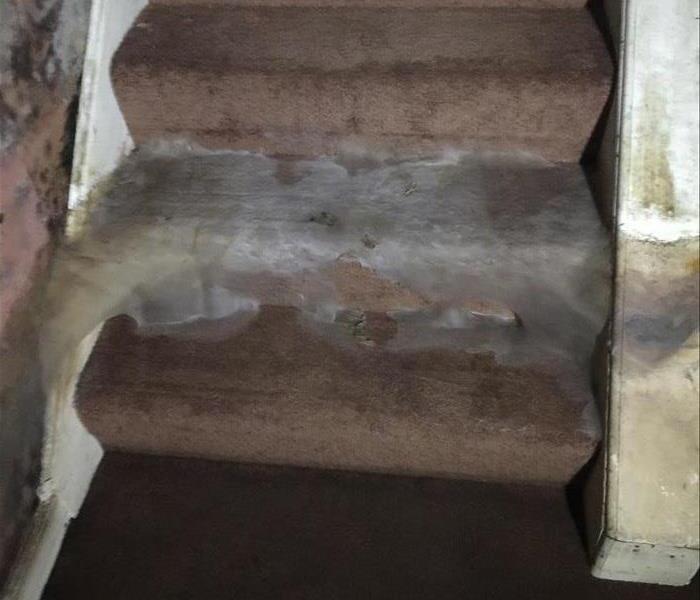 Mold on stairs
Mold on stairs
A smelly odor deodorization does nothing to mask, the presence of mildew or another fungus anywhere in the house, or even the smallest presence of mold in the home is bad news. A smelly odor that’s not cleared up with the help of deodorization or by taking out the trash might indicate another issue. When nothing else makes sense and that smelly odor doesn’t go away no matter how much deodorization is utilized, it’s time for homeowners to admit there might be mold damage somewhere in the home.
What is Mold Damage? Mold damage isn’t what it sounds like. This fungus doesn’t appear to have damaged anything when it’s easily wiped up. Mildew doesn’t seem like damage so much as it seems like someone neglected to clean the bathroom or kitchen or even the basement properly. Mold damage is damaging. It spreads quickly, it’s dangerous for the home, and it’s not good to live in a home with mold present. No amount of deodorization to mask the smelly odor that indicates mold in the home is enough to get rid of it, and it’s time to call a professional before it spreads and causes massive damage to the home.
Where is Mold Found? Mold is often present when mildew is present, but it’s a fungus that lives everywhere. It’s a fungus found in mold spores in the air. All it needs is a little moisture and a high level of humidity to grow quickly and spread rapidly. When this occurs, a problem is close at hand. Mold in the home is very common in places with high levels of humidity, but commercial mold damage is also a big problem. It’s easy to miss commercial mold damage more so than mold at home. Commercial mold damage in a large warehouse or building can go unnoticed for days or weeks. Commercial mold damage like this that goes unnoticed often spreads quickly and causes more problems for the business owner. Mold at home or at work requires remediation and mitigation.
Calling for Professional Mold Removal – SERVPRO of Elmhurst – 63-758-1701
Professional mold remediation and mitigation is imperative the moment this fungus is located. Professional mold removal services are equipped to better handle mold removal and remediation while also providing mitigation services. Handing this without the help of professional-grade equipment often results in an imperfect job where mold returns quickly.
Mold removal services use professional equipment that’s designed to clear out mold during the remediation and mitigation process. It helps dry moist areas, detect the source of moisture in the building, and this service provides mitigation for those who need to learn how to prevent mold from reoccurring. Mold removal is not for those who haven’t dealt with this problem before. It’s more expensive for a home or business owner to attempt mold removal on their own than it is to pay for a professional remediation and mitigation service from the start. When this job is done right the first time, home and business owners are able to learn how to prevent mold from occurring again in the future.
Mildew and mold aren't issues anyone should brush off at home or work. Both require the help of a service that helps remove the issue as well as educate the home or business owner about the importance of keeping moisture at bay and humidity levels low. Knowledge is power when it comes to mold remediation and prevention at home or work.
Visit http://www.SERVPROElmhurst.com for more information on mold removal and remediation.
DIY Mold Test
9/8/2017 (Permalink)
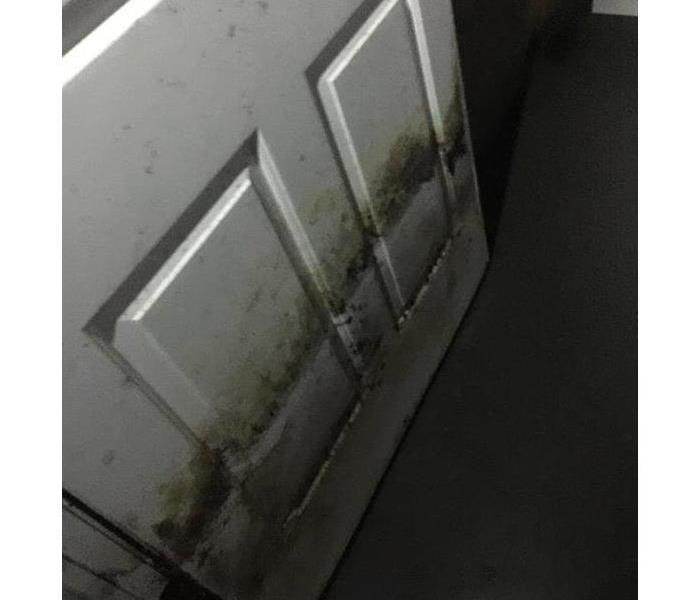 Mold on door
Mold on door
You can expect mold and mildew outside your home because of the natural damp conditions of the outdoors. Mold and mildew inside the home is a different problem, because the inside of your home shouldn't remain damp.
The presence of moisture is the biggest contributor to mold growth, and to fight the infestation you should conduct a room-by-room assessment of the house to identify problem areas. The moisture can come from condensation due to poor ventilation (attic), from a water leak (around bathrooms), or from outdoor intrusion (foundation walls).
Detection
Mold and mildew in a home is not always easy to detect if it exists within attics or is hidden within walls. If you suspect your indoor air quality is hindered by hidden mold, you can conduct your own DIY test to detect a problem.
The EHT staff recently conducted the Healthful Home 5-Minute Mold Test in a finished basement that had suffered some previous flooding problems. The air seemed fine in the room, but the old moisture issues suggested that if there were to be a mold problem in the house then it was likely to occur in this room.
The test is easy to accomplish. Simply use one of the cotton swabs included with the kit to sample surface dust in the room. Soak the swab tip in the "rinse buffer" liquid (included) and then drip five drops of the liquid onto the two test strips that come with the kit. One strip is labeled Asp/Pen (Aspergillus and/or Penicillium) and the other is labeled Stachybortrys.
Test results show in as little as 5 minutes, and much like a pregnancy test you'll either see one line (negative results) or two lines (positive).
Luckily, our home tested negative. If the test is positive, however, it does not necessarily mean you have a serious problem but that you should consider consulting a professional indoor air quality inspector or a remediation service professional SERVPRO of Elmhurst. You can also have an optional laboratory analysis of your test results conducted for an additional fee.
Fighting the Mold you Find
If you discover mold on the home's interior, the first step in solving the problem is to eliminate the source of moisture, whatever that may be. Otherwise, any mold or mildew you clean is likely to return.
For minor problems you may be able to clean the surface of the materials with an antimicrobial cleaner. For major problems, remove materials that cannot be thoroughly cleaned of mold and mildew, like insulation, carpeting or drywall. Use your antimicrobial cleaner to clean the surrounding area as well as the places where you actually see mold and mildew, to make sure you remove all traces of the substances.
Finally, replace the removed building materials with new, mold-free materials. For more information call SERVPRO of Elmhurst 630-758-1701.
For Immediate Service in Elmhurst, Call SERVPRO of Elmhurst
9/5/2017 (Permalink)
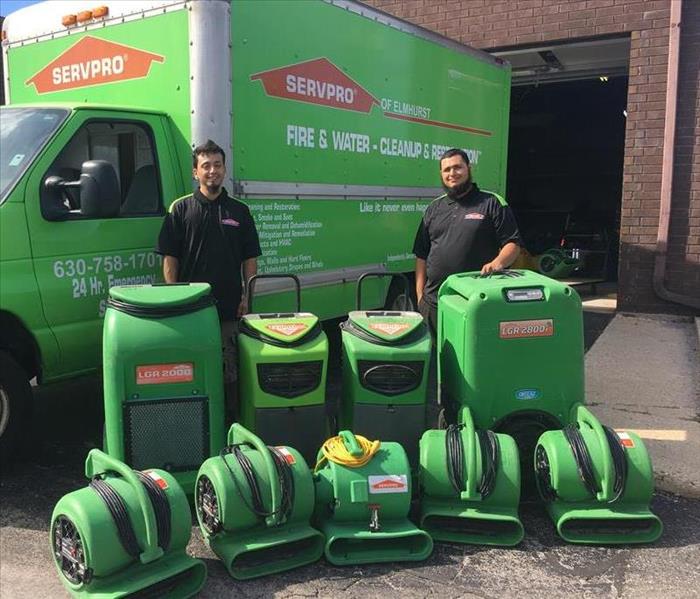 SERVPRO of Elmhurst
SERVPRO of Elmhurst
SERVPRO of Elmhurst provides 24-hour emergency service and is dedicated to being faster to any-sized disaster in Elmhurst. We can respond immediately to your emergency and have the expertise to handle your restoration or cleaning needs.
- 24-Hour Emergency Service
- Faster to Any-Sized Disaster
- Highly Trained Restoration Technicians
- A Trusted Leader in the Restoration Industry
- Locally Owned and Operated
- Advanced Restoration and Cleaning Equipment
Have Questions? Call SERVPRO of Elmhurst 630-758-1701
Residential Services
Whether your Elmhurst home needs emergency flood damage or your upholstery cleaned, you can depend on us. Our technicians have extensive cleaning and restoration training and can make your property look its best. Learn more about our residential services:
- Water Damage Restoration
- Fire Damage Restoration
- Mold Remediation
- Storm Damage Restoration
- Cleaning Services
- Building/Reconstruction Services
Commercial Services
There's never a convenient time for fire or Water damage to strike your Elmhurst commercial property. Every hour spent cleaning up is an hour of lost revenue and productivity. When the need arises for professional cleaning or emergency restoration services we have the training and expertise to respond promptly with highly trained technicians to get your property back to business.
Mold Remediation and Removal
9/5/2017 (Permalink)
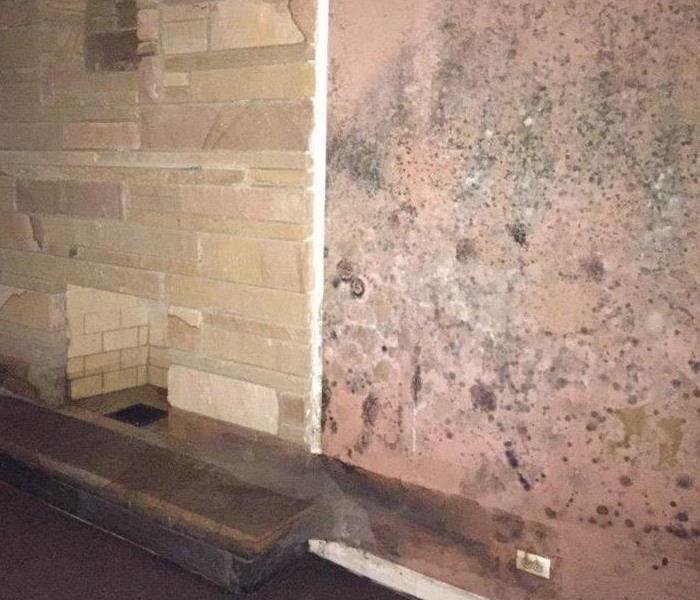 Mold in basement
Mold in basement
If you have mold anywhere inside of your residence or business, your home could be compromised. This microbial growth is a silent and many times undetected condition, but one in which you must be concerned about.
It can come in several different colors, and it looks like a fuzzy covering on surfaces that seems to come out of nowhere. It comes about from spores that travel through the air and when the spores land where conditions are just right, it will plant itself and grow.
It needs an area where it is dark, and where there is a moisture supply and where there is no moving air. If it finds these conditions, it can grow seemingly overnight and cover an entire wall in a matter of days. So areas such as basements, attics, closets, crawl spaces, and bathrooms are prime candidates.
Mildew and fungus are many times mistaken for mold, but they are not the same. Even though they have similar looks, they are very different types of organisms. Mildew and fungus are usually more greenish in color, whereas mold can be reddish, brown, green, blue, and black. The black kind of mold can be the most serious simply due to its growth rate, its hardiness, and difficulty in eradicating.
If you discover the microbial growth, you should contact an environmental hygienist to discover if it is fungus or mildew or not. An environmental hygienist is available with most cleanup organizations and companies who specialize in mold cleanup and mitigation. You should never attempt to clean up an area that is suspect yourself because that could be dangerous and ineffective. Mold cleanup should only be done by experts.
Most people who will attempt mold cleanup and mitigation by wiping it off will think that they have succeeded, but they will have only wiped off the top of the microbial growth. The organism itself has tentacles or roots that can penetrate and take hold in just about every substance there is except for glass. That is why you will see it growing on the surfaces of wood, cloth, shingles, walls, and even concrete.
The microbial growth will grow on the inside of walls too, so it may go undiscovered for quite some time before anything can be done about it. When the environmental hygienist diagnoses it as being the problem a process of mold removal and mitigation must begin as soon as possible. Workers who work at mold removal will wear special clothing and masks to protect themselves, so they will not be exposed any toxic effects.
Fungus and mildew will not cause harmful effects, but certain kinds of the microbial growth can even give off toxins, especially the black kind, so respiratory protection during its mitigation process is very important. The environmental hygienist will supervise and treat the area, so the mold cleanup process will assure that the substance will not easily reoccur. Need more information, call SERVPRO of Elmhurst at 630-758-1701.
Fire Damage Restoraton Information
9/5/2017 (Permalink)
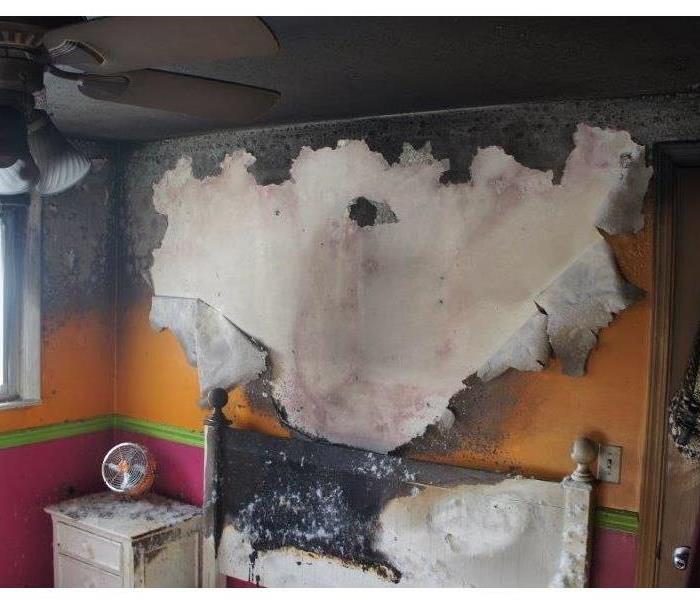 Fire in bedroom
Fire in bedroom
There is nothing more devastating than a fire in home or fire in business. Seeing one's personal belongings or business products go up in smoke is a stunning experience that makes one wonder what to do next. Often the first indication of a fire is the smoke smell.
The day following a fire is the time to start planning on fire damage restoration. Fortunately, there are commercial fire damage companies who specialize in the fire cleanup process. In a severe fire, one is talking about fire cleanup starting from scratch. However, in many cases the fire is confined to a limited area.
The first step is to contact a commercial fire damage company that specializes in fire cleanup. This company will have the equipment and expertise to clean up smoke damage, soot damage, a smoke smell and all the other problems that have been caused by the fire.
1. Upon being contacted, the professionals will immediately arrive on the scene to make an inspection and determine the amount of the damage. Whether it is a fire in home or a fire in business, they will carefully survey the area and provide a written estimate of the cost of the repairs. This is especially important with commercial fire damage where there are often large amounts of salable goods involved.
2. If the fire damage has caused a breech in the walls, roof or windows, the professionals will immediately use boards and tarps to cover these areas to prevent further damage. This protects the property from vandals or weather damage.
3. Unfortunately, fire hoses must spray water to put out a fire. This is part of the fire damage that is left behind. Removing this water quickly will avoid things like warped boards or the formation of mold. Professionals are equipped with large dehumidifiers, blowers and air movers to clear the area of excess water and dry the area.
4. Today's professionals in the business have the equipment and materials to return many of the items suffering from soot damage or smoke damage to their pre-fire condition. They sanitize and clean all items that are salvageable.
5. Smoke damage and soot damage are fire damage restoration problems that require special consideration. Using special equipment, as much smoke and soot as possible will be removed. In many cases it will be necessary to repaint or refinish some surfaces that are smoke stains. This, as well as replacing drywall, making minor or major reconstruction, painting and so forth, can be done by the specialists by contract.
Commercial fire damage can be costly. Not only in the actual damage to a building and goods, but in the lack of business caused by the shutdown. This makes it imperative to obtain the services of a specialist in the area of fire damage restoration. An experienced company will be able to quickly access the damage and present a plan to cover all aspects of cleaning up the fire in business circumstances.
When a fire in home is involved, have a professional immediately address problems such as soot damage, smoke damage, smoke smell and general all over fire cleanup. They will carefully explain the cost, the methods used and the end result. As a rule, an insurance company must be contacted before work can begin.
Professionals in the area of fire damage restoration are especially trained in the ins and outs of fire damage that occurs when there is a fire in home or a fire in business. In addition to training, they have the equipment and materials to address things such as smoke damage, soot damage, smoke smell and other things caused by fire damage. This makes it possible for them to start work immediately after a fire and have the home or business back in tip-top shape quickly and efficiently. Visit http://www.SERVPROElmhurst.com for more information on fire damage.
Faster to your Elmhurst Water Damage
8/30/2017 (Permalink)
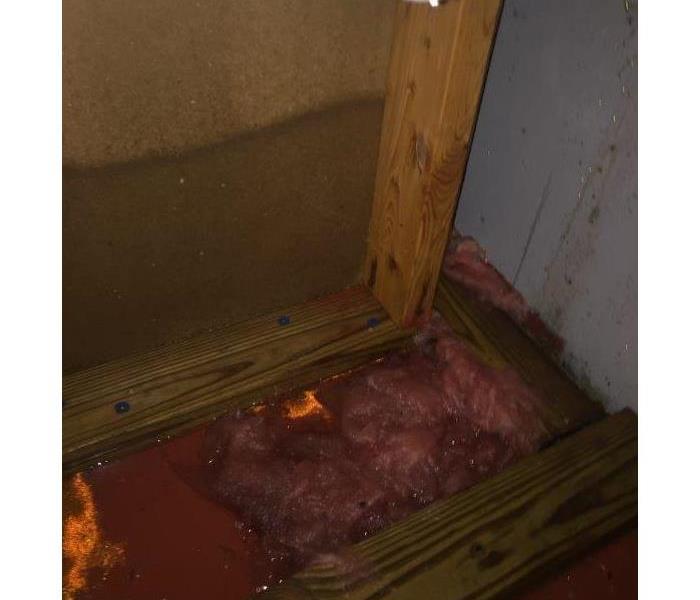 Water damages in the basement.
Water damages in the basement.
Photo Caption: SERVPRO of Elmhurst provides 24 hour fire and water damage restoration service in Elmhurst, Bensenville, Hillside, Berkeley, Franklin Park, Melrose Park, Stone Park and Northlake.
Flooding and water emergencies don’t wait for regular business hours and neither do we. SERVPRO of Elmhurst provides emergency cleaning and restoration services 24 hours a day, 7 days a week—including all holidays.
Faster To Any Size Disaster
Flooding and water damage is very invasive. Water quickly spreads throughout your home and gets absorbed into floors, walls, furniture, and more. SERVPRO of Elmhurst arrives quickly and starts the water extraction process almost immediately. This immediate response helps to minimize the damage and the cleaning and restoration costs.
Need Emergency Service? Call Us 24/7 –SERVPRO of Elmhurst
Water Damage Timeline
Within Minutes
- Water quickly spreads throughout your property, saturating everything in its path.
- Water is absorbed into walls, floors, upholstery, and belongings.
- Furniture finishes may bleed, causing permanent staining on carpets.
- Photographs, books, and other paper goods start to swell and warp.
Hours 1 - 24:
- Drywall begins to swell and break down.
- Metal surfaces begin to tarnish.
- Furniture begins to swell and crack.
- Dyes and inks from cloth and paper goods spread and stain.
- A musty odor appears.
48 Hours to 1 Week:
- Mold and mildew may grow and spread.
- Doors, windows, and studs swell and warp.
- Metal begins to rust and corrode.
- Furniture warps and shows signs of mold.
- Paint begins to blister.
- Wood flooring swells and warps.
More Than 1 Week:
- Restoration time and cost increase dramatically; replacing contaminated materials and structural rebuilding may be extensive.
- Structural safety, mold growth, and biohazard contaminants pose serious risks to occupants.
We Specialize in Flooded Basement Cleanup and Restoration!
8/30/2017 (Permalink)
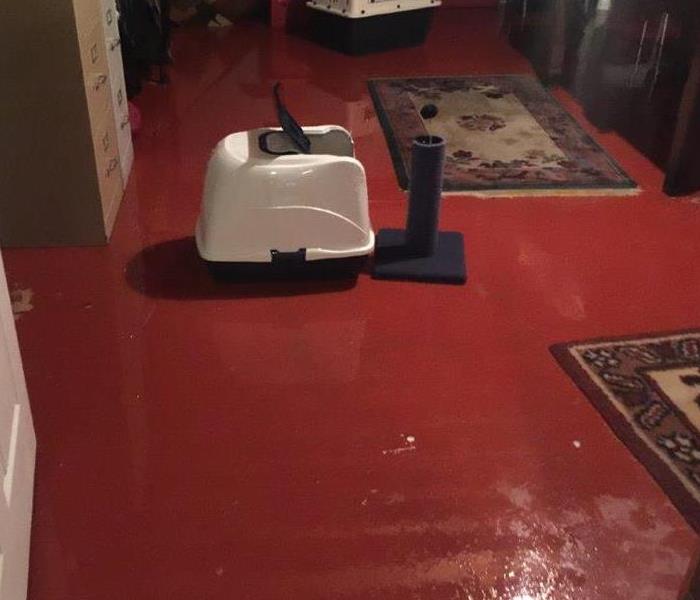 Basement
Basement
A basement can flood at any time, although flooding most often occurs during heavy rainfall. Basements are inherently prone to flooding because they are the lowest level of a building and are normally built partly or entirely below ground level. There are a number of reasons why your basement could flood, including:
- A blocked or failed sewer lateral pipe
- Heavy rain causes surface water to pool around your home
- Storm sewer backup
- Sanitary sewer backup
- Foundation drainage failure
- Water supply-line break or hot-water tank failure
- And many more
Have Questions about Basement Flooding?
Call Today – SERVPRO of Elmhurst
If flood water is not handled quickly and properly, it can jeopardize your health and safety, and cause severe damage to your home’s structure. Remember, the longer you wait, the worse the problem will get.
The bottom line: a flooded basement can jeopardize your health, safety, and your home’s integrity. It’s worth making a call to SERVPRO of Elmhurst and let our trained, professional crews handle the situation safely and correctly. We have earned the trust of hundreds of homeowners, business owners, and property professionals.
We are Flooded Basement Specialists:
- We are Available 24 hours/7 days per week
- We’re a Preferred Vendor to many National Insurance Companies
- We Bill The Insurance Directly – One Less Thing For You To Worry About
- Our Technicians are Highly-Trained in Water Restoration Techniques
- We use s500 IICRC Restoration Standards
- Advanced Inspection and Extraction Equipment
Basement Flooded? Call Us Today 630-758-1701 – SERVPRO of Elmhurst is Ready To Help!
Ready To Help
7/25/2017 (Permalink)
SERVPRO of Elmhurst is available 24 hours a day for water emergencies, large or small. When you are dealing with water damage, immediate action is crucial. A delay of just a few hours can greatly increase the severity of the water damage.
We Answer the Phone Ready to Help Call Today - SERVPRO of Elmhurst 630-758-1701
We understand that when you call us, you may be feeling confused, stressed, and vulnerable. You need an expert to guide you through this crisis. SERVPRO of Elmhurst has the specific water damage training and experience to help you through this tough time. We specialize in water damage restoration in fact, it's the cornerstone of our business.
What to Expect
When you call, we will ask several questions regarding your water damage emergency. These questions will help us determine what equipment and resources to bring, including how many trained SERVPRO Professionals may be needed.
Our SERVPRO Representative will ask several questions:
- Your name and contact information
- Your insurance information (if applicable)
- The street address of the water-damaged home or business
- When did the flooding or water damage occur?
- What caused the water damage (if known)?
- Is there electricity available (on-site)?
About SERVPRO of Elmhurst
7/25/2017 (Permalink)
SERVPRO of Elmhurst specializes in the cleanup and restoration of commercial and residential property after a water damage event. Our staff is highly trained in property damage restoration. From initial and ongoing training at SERVPRO corporate training facility to regular IICRC-industry certification, rest assured our staff is equipped with the knowledge to restore your property.





 24/7 Emergency Service
24/7 Emergency Service


